In English:
Sergey Shabohin:
Atlas of Tectonic Landscapes
February 3 – March 5, 2023
Municipal Gallery Arsenał, Poznan
Curator: Marek Wasilewski
︎︎︎ arsenal.art.pl

Tectonic landscape, a term used in the field of geomorphology, is a type of landscape “whose main features have been shaped by tectonic movements, and whose system of elevations and depressions corresponds to the orogenic and epeirogenic processes. Typical elements of tectonic sculpture are horst and graben, sinkholes, and tectonic edges. In these areas, earthquakes are frequent, and they are generally characterized by high relative heights and high intensity of sculptural processes.” 1
At the exhibition of work by Sergey Shabohin, geomorphology meets art, and geological processes meet imaging strategies. Horst and graben, sinkholes, and tectonic edges allude to the geopolitics of the former Soviet Union. Tectonic landscapes are shaped by powerful forces whose actions exceed the imagination of man, because they function in different time categories and shape the overall structure of our environment. From the perspective of human life, they seem unshakable, just as the mighty Soviet empire once did. But one point, thirty years ago, the ever-moving system of large plates reached its tipping point, and we have been observing its convulsions ever since. And it is precisely the earthquakes and powerful sculptural processes that Sergey Shabohin records in his work in political and cultural terms.
Shabohin, born in the Orwellian year 1984 in Novopolotsk, Belarus, currently lives and works in Poznań. He’s an art activist who simultaneously conducts artistic, curatorial, and critical activities. In his artwork, Shabohin explores the critiques of the cultural system and the role played by contemporary museums and the creation of original archives. An important motif in Shabohin’s work is the history of 20th and 21st century art and iconic figures such as Kazimir Malevich or Marcel Duchamp. The artist is particularly fascinated with the category of fear and the social body in Belarusian society. Described as one of the most significant Belarusian artists of his generation, since 2010 he records in his work the mechanisms of repression and subjugation to power in modern Belarus. He creates narratives about the practices of the totalitarian regime, and collects stories, images, slogans, and found objects.
With the passion of a scientist, Shabohin conducts artistic research on the living and aching body of the recent past and the present of post-Soviet countries. With great sensitivity he deconstructs the aesthetics of the ideology of submission, its pathos and nostalgic sorrow. The title of his exhibition – Atlas of Tectonic Landscapes – clearly evokes Aby Warburg’s Bilderatlas Mnemosyne. Shabohin uses a similar strategy of combining two ways of seeing: a philosophical and a history-based approach to images. As Paweł Brożyński writes in the introduction to the Polish edition of Warburg’s book (and I think his observations also perfectly describe Shabohin’s work): “(…) above all [it] presents the endurance and wandering of elementary visual patterns (pathos formulas)”.
The exhibition at the Arsenal combines various series of the artist’s works, which are familiar with the aforementioned “pathos formulas”. Social Marble is a series inspired by observing the process of removing graffiti from cheap imitations of marble and granite by municipal authorities in Minsk. Thus, the series also denotes the authoritarian censorship practices of the Belarusian regime and deconstructs the nationalist mythology propagated by the Belarusian state. The Tectonic Plates series, in the making since 2020, large-scale geopolitical upheavals: military conflicts, pandemics, protest waves, remaking of the world order, and cultural revolutions. Inspired by the ideas of the 1920s avant-garde, the artist transposes the abstract forms into a realistic context and creates an atlas of imaginings, which he calls images of human consciousness. The series entitled We are Stern Consumers of Cultural Revolutions is an analysis of his approach to the heritage of the avant-garde UNOVIS school in Vitebsk. The artist points out the paradox of silencing avant-garde achievements in the Soviet Union and its keen reception and handling in the West during the Cold War. Shabohin demonstrates how today the avant-garde aesthetics return to Belarus in the form of mass consumer products. Dedicated to the artist’s hometown, the Street Without End series is based on selected shots from the feature film Street Without End (1972). Here, we are confronted with images of a phantom Soviet utopia. The series reflects upon unrealized aspirations, confrontations between nature and urban tissue, memory, and nostalgia. Mandrake Gardens is a two-channel video in which Shabohin juxtaposes the pandemic riots in Berlin’s Hasenheide Park with the almost parallel pro-democracy demonstrations in the Park of Peoples’ Friendship in Minsk. On the screens, we see the timid reaction of the Berlin police and the aggression of their Belarusian counterparts. The artist notices white knotted ribbons, the symbol of gay cruising in parks, and similar white ribbons on the shoulders of demonstrators in Minsk.
In the Atlas of Tectonic Landscapes, by creating a broad, panoramic image of the current political and cultural situation, the artist exorcizes the ghosts of post-Soviet reality and reveals the effects and consequences of the catastrophes we are witnessing today.
[1] en.wikipedia.org
At the exhibition of work by Sergey Shabohin, geomorphology meets art, and geological processes meet imaging strategies. Horst and graben, sinkholes, and tectonic edges allude to the geopolitics of the former Soviet Union. Tectonic landscapes are shaped by powerful forces whose actions exceed the imagination of man, because they function in different time categories and shape the overall structure of our environment. From the perspective of human life, they seem unshakable, just as the mighty Soviet empire once did. But one point, thirty years ago, the ever-moving system of large plates reached its tipping point, and we have been observing its convulsions ever since. And it is precisely the earthquakes and powerful sculptural processes that Sergey Shabohin records in his work in political and cultural terms.
Shabohin, born in the Orwellian year 1984 in Novopolotsk, Belarus, currently lives and works in Poznań. He’s an art activist who simultaneously conducts artistic, curatorial, and critical activities. In his artwork, Shabohin explores the critiques of the cultural system and the role played by contemporary museums and the creation of original archives. An important motif in Shabohin’s work is the history of 20th and 21st century art and iconic figures such as Kazimir Malevich or Marcel Duchamp. The artist is particularly fascinated with the category of fear and the social body in Belarusian society. Described as one of the most significant Belarusian artists of his generation, since 2010 he records in his work the mechanisms of repression and subjugation to power in modern Belarus. He creates narratives about the practices of the totalitarian regime, and collects stories, images, slogans, and found objects.
With the passion of a scientist, Shabohin conducts artistic research on the living and aching body of the recent past and the present of post-Soviet countries. With great sensitivity he deconstructs the aesthetics of the ideology of submission, its pathos and nostalgic sorrow. The title of his exhibition – Atlas of Tectonic Landscapes – clearly evokes Aby Warburg’s Bilderatlas Mnemosyne. Shabohin uses a similar strategy of combining two ways of seeing: a philosophical and a history-based approach to images. As Paweł Brożyński writes in the introduction to the Polish edition of Warburg’s book (and I think his observations also perfectly describe Shabohin’s work): “(…) above all [it] presents the endurance and wandering of elementary visual patterns (pathos formulas)”.
The exhibition at the Arsenal combines various series of the artist’s works, which are familiar with the aforementioned “pathos formulas”. Social Marble is a series inspired by observing the process of removing graffiti from cheap imitations of marble and granite by municipal authorities in Minsk. Thus, the series also denotes the authoritarian censorship practices of the Belarusian regime and deconstructs the nationalist mythology propagated by the Belarusian state. The Tectonic Plates series, in the making since 2020, large-scale geopolitical upheavals: military conflicts, pandemics, protest waves, remaking of the world order, and cultural revolutions. Inspired by the ideas of the 1920s avant-garde, the artist transposes the abstract forms into a realistic context and creates an atlas of imaginings, which he calls images of human consciousness. The series entitled We are Stern Consumers of Cultural Revolutions is an analysis of his approach to the heritage of the avant-garde UNOVIS school in Vitebsk. The artist points out the paradox of silencing avant-garde achievements in the Soviet Union and its keen reception and handling in the West during the Cold War. Shabohin demonstrates how today the avant-garde aesthetics return to Belarus in the form of mass consumer products. Dedicated to the artist’s hometown, the Street Without End series is based on selected shots from the feature film Street Without End (1972). Here, we are confronted with images of a phantom Soviet utopia. The series reflects upon unrealized aspirations, confrontations between nature and urban tissue, memory, and nostalgia. Mandrake Gardens is a two-channel video in which Shabohin juxtaposes the pandemic riots in Berlin’s Hasenheide Park with the almost parallel pro-democracy demonstrations in the Park of Peoples’ Friendship in Minsk. On the screens, we see the timid reaction of the Berlin police and the aggression of their Belarusian counterparts. The artist notices white knotted ribbons, the symbol of gay cruising in parks, and similar white ribbons on the shoulders of demonstrators in Minsk.
In the Atlas of Tectonic Landscapes, by creating a broad, panoramic image of the current political and cultural situation, the artist exorcizes the ghosts of post-Soviet reality and reveals the effects and consequences of the catastrophes we are witnessing today.
Marek Wasilewski
[1] en.wikipedia.org
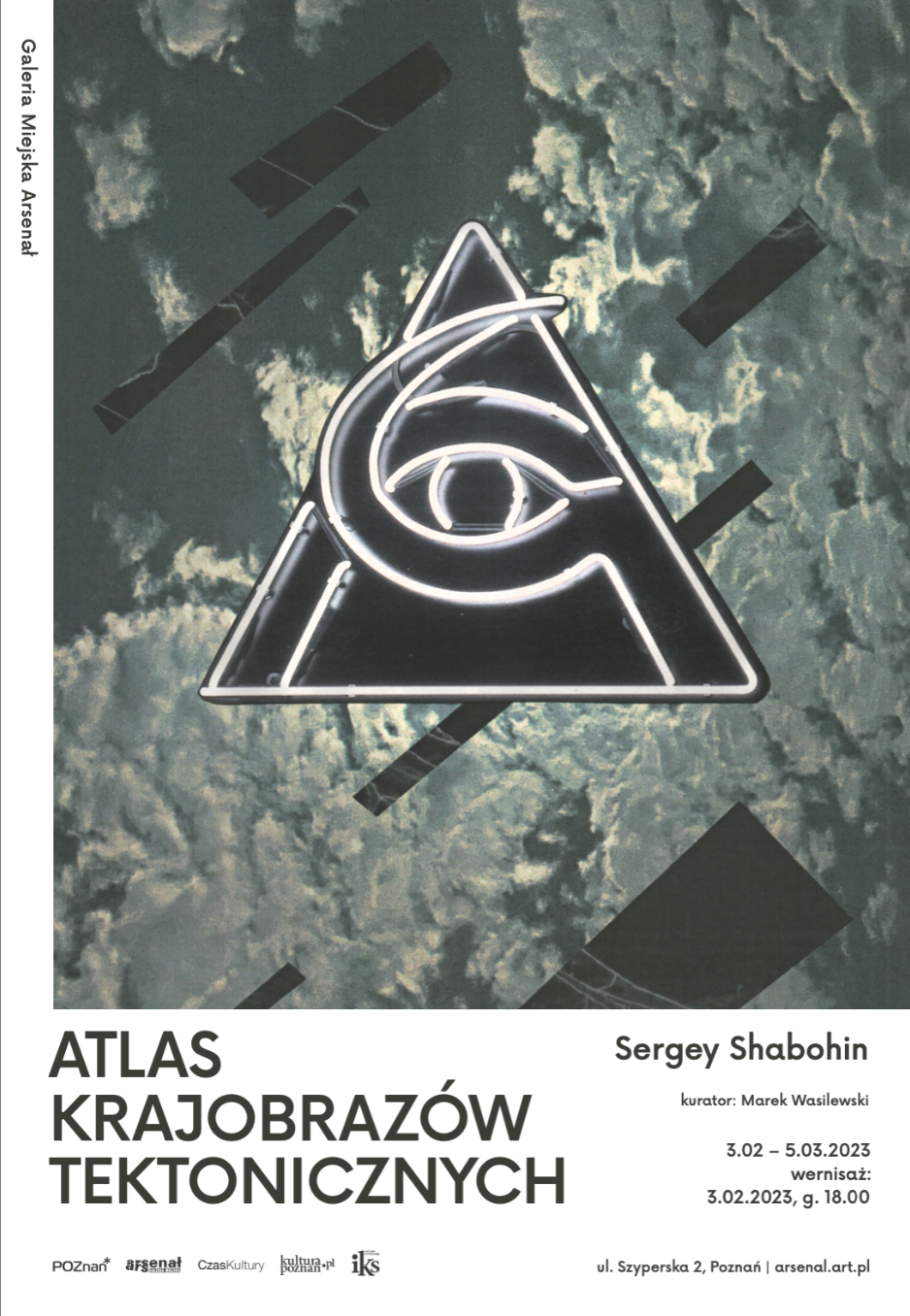
Exhibition poster
Glossary:
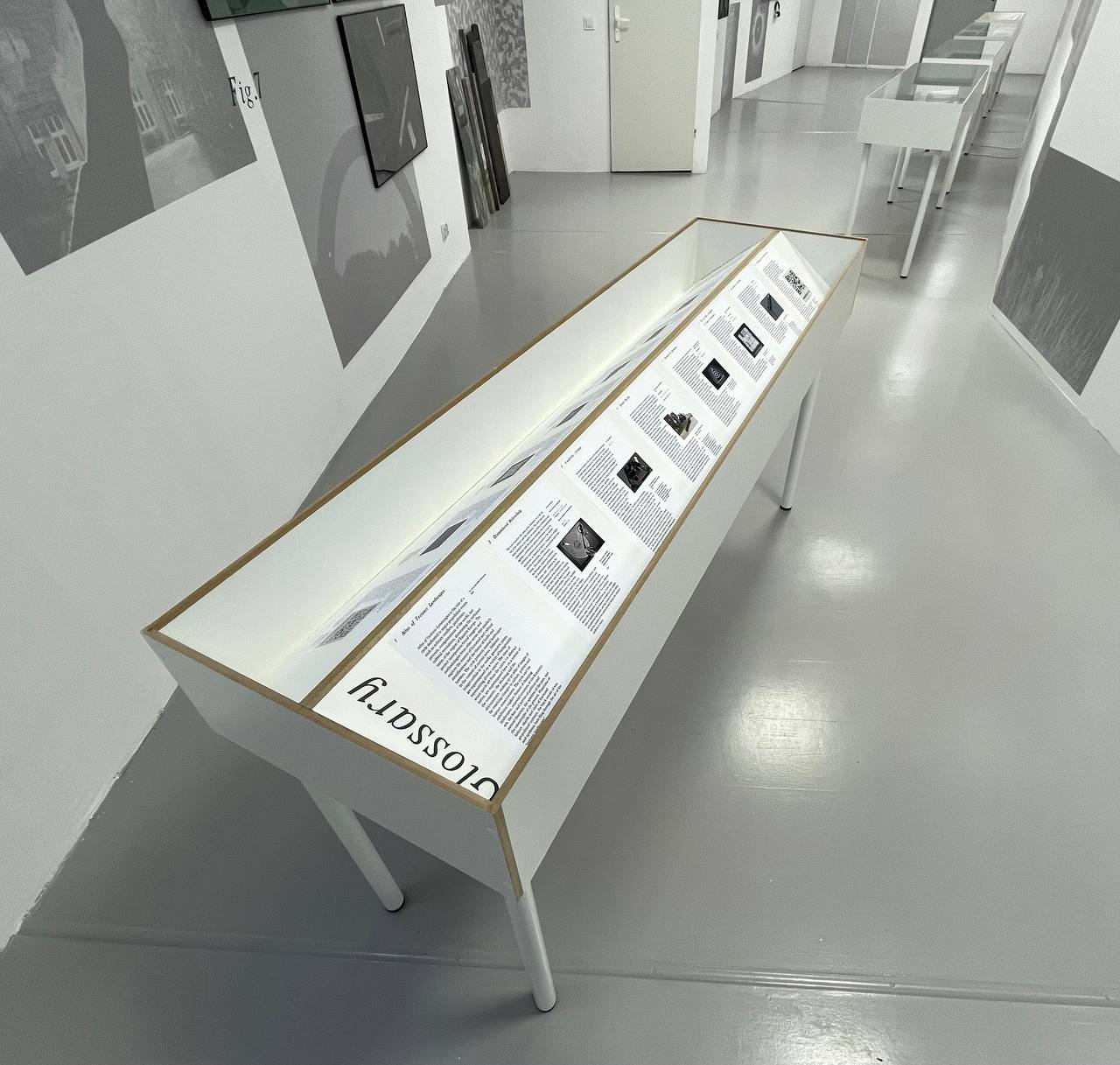
1
Atlas of Tectonic Landscapes
Atlas of Tectonic Landscapes is the title of a cycle dedicated to major geopolitical events such as military conflicts, pandemics, protests, reorganisations of the world, and cultural revolutions, showcasing the turbulent times of the region of Eastern Europe. The project incorporates found imagery and methodologies from other series that similarly explore the context of historical and cultural stratifications and the theme of faults and borders. The cycle presents mental landscapes in the context of current news. Different images collide in the works; geometric plates are superimposed on a variety of backgrounds representing diverse spaces. The ideas of avant-garde art from the 1920s, i.e. abstract forms, are superimposed here on a system of the romantic, the declining and the documentary, making up an atlas of images of far-reaching changes in culture, politics and human consciousness. The cycle and the exhibition explore themes of changing landscapes, renewed concepts of the Romantic era, the fear and horror of political and natural disasters, the spectres of the past, and the catastrophe of the present. Phantoms of history, shards and slabs of fractured geopolitical contexts, the black smoke of war, and epidemic bats fling through the air of the “tectonic landscapes”.
︎
The cycle has been made since 2020
2
Dismembered Melancholy
The cycle considers the ideas of the Romantic era with its cult of the natural and the emotional. This style has now been updated in our region: an escape from civilisation and a fascination with the natural elements (the environmental agenda), a reference to political symbolism, a turn to individual experience and exploration of the human microcosm, an interest in history, a longing for twilight and the unconscious, a fear of catastrophes and of the future. The exhibition references the Romantic landscape tradition, the characteristics of Romanticism in music, and – inherent in the very structure of the exhibition – the fondness of the Romantic era of the early 19th century for making research atlases based on natural and mental studies. The music of this time is a particular highlight of the exhibition; three invited composers have made their own special contribution in this respect. In the exhibition, the Romantic musical tradition, both melancholic and deeply passionate, is explored and “dismembered”, destroyed and constructed into new systems. The artist moreover examines the impact of a historical current on such contemporary styles as: ambient, techno, noise, minimal, and industrial. The exhibition depicts the breakdown of Romanticism as a style, where clots of opposing marble forms are revealed in the twilight of traditional landscapes, and the crackle of tectonic faults and the sounds of war penetrate and disrupt the classical tradition in music.
︎
At the exhibition:
Romanticism in landscape:
Fig. 2, 4, 5, 7, 9, 12
Showcases ︎ A, ︎ B, ︎ C, ︎ D
Musical tradition of Romanticism:
Fig. 2, 9
Showcase ︎ C (video)
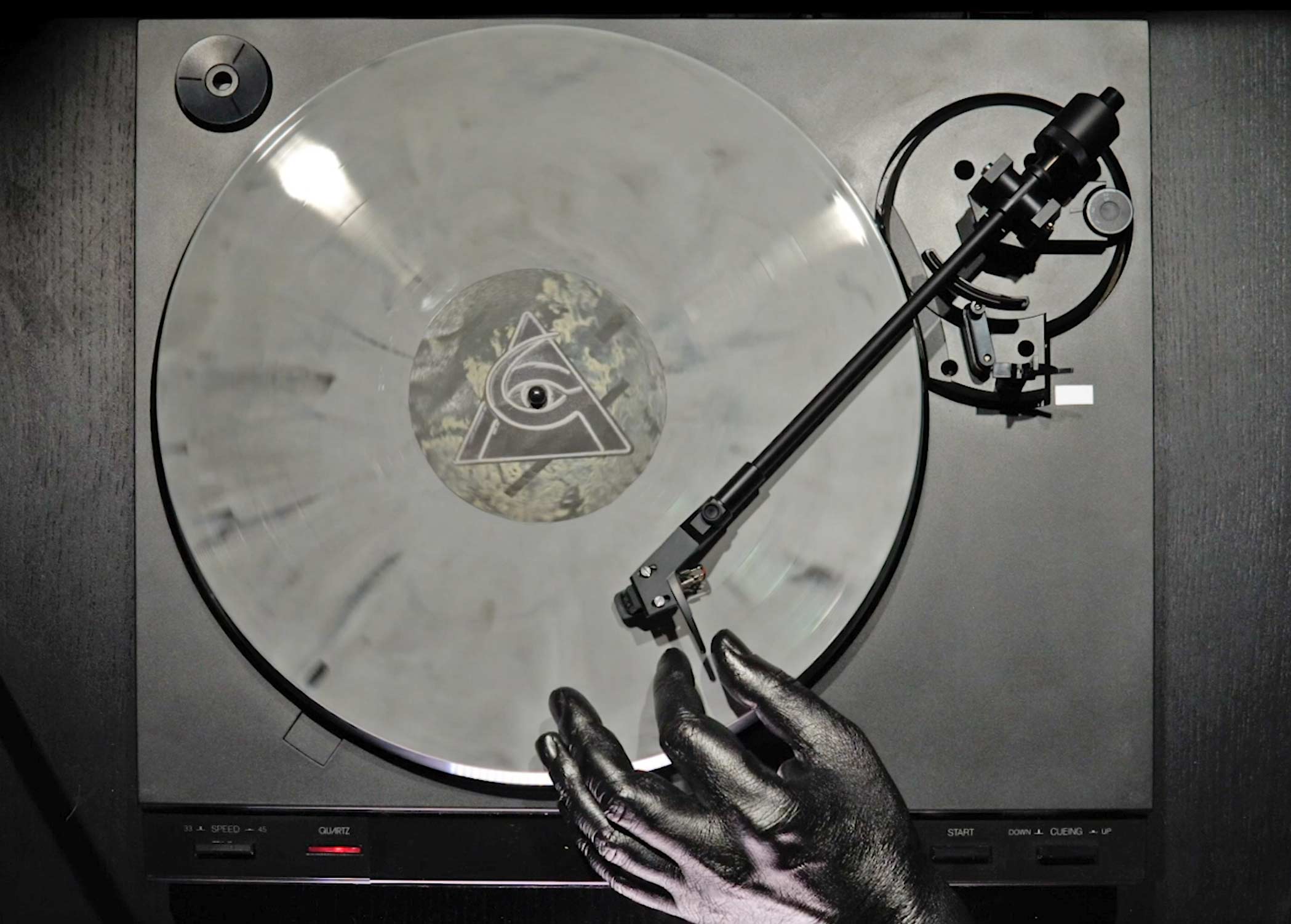
Video Atlas of Tectonic Landscapes: Dismembered Melancholy (Broken Vinyl)
2023
See: showcase ︎ C ︎︎︎
2023
See: showcase ︎ C ︎︎︎
3
Mandragora Gardens
Mandragora Gardens is the name of the ultimate landscapes of public liberty examined in the series: raves in parks, public picket venues, protest landscapes, etc. The theme of illusory freedom and the relationship between the natural and the sexual manifests itself in many of the works in the exhibition, most notably in a two-channel video of two parks: the Hasenheide in Berlin and the Friendship of Nations Park in Minsk. During the pandemic in the summer of 2020, nightclubs in Berlin were closed and the city's residents began to hold illegal parties in the parks. Particularly eye-catching were the raves in the Hasenheide Park, gathering thousands of participants. In this part, the dense park is an attractive place for cruising and queer orgies. At the same time, an election campaign was underway in Belarus. The official picket of Svyatlana Tikhanouskaya took place in the Friendship of Nations Park in Minsk on 30 July 2020. The two screens show side by side two seemingly divergent contexts: illegal raves and official picketing; the gentle reaction of the Berlin police and the aggression of the Minsk security forces; the sexuality of the picket and the energy of protest; the white ribbons with the knot on the trees as a symbol of the LGBTQ+ community and the white ribbons on the shoulders as a symbol of the protest movement in Minsk; the myth of the mandrake growing from a male seed and the Belarusian mythology with the semiotics of the potato, etc. The dual video not only compares the contexts, but demonstrates the unsatisfied desire for freedom against the backdrop of urban park landscapes.
︎
At the exhibition:
Fig. 2, 9


Total installation Fear of Castration: Darkroom-Labyrinth
2019
The artists looks into a gay cruising and compares it against the context of Belarus also in the series Fear of Castration, which gathers archival photographs from dark rooms in Warsaw.
2019
The artists looks into a gay cruising and compares it against the context of Belarus also in the series Fear of Castration, which gathers archival photographs from dark rooms in Warsaw.
4
Social Marble
Social Marble is a cycle based on the observation of practices of Minsk cleaning services who, unable to erase aggressive graffiti from Soviet marble and granite walls of subway passages began to hide them under self-adhesive foil with a marble pattern. The artist called such quasi-marble “social marble” inasmuch as anyone can afford it. Within the cycle, foil was used to create works about communities and the emergence of civil society in Belarus, social transformation and solidarity networks. On the other hand, this foil symbolises the Belarusian authoritarian regime, its censorship and the image of a pseudo-social state based on the Soviet myth. The works covered with "marble" foil show total censorship against any dissent and even against memory, when the state combats spontaneous memorials at the site of death of opposition heroes Fig. 7. They are an indication of the authorities' attempts to write their own history with the new tools of the post-truth era. This part of the cycle criticises historical fabrications and the nation-building mythology of the Belarusian state. Social marble as a material is used extensively in the exhibition in the Atlas of Tectonic Landscapes cycle, where it arises as an image of the palimpsests of memory and the anxiety of traumatic historical transformations and ideological confrontations, demonstrated through the processes occurring in the region of Eastern Europe.
︎
The cycle has been made since 2014
At the exhibition:
Fig. 1, 2, 3, 4, 5, 6, 7, 11, 12
Showcases ︎ A, ︎ B, ︎ C, ︎ D
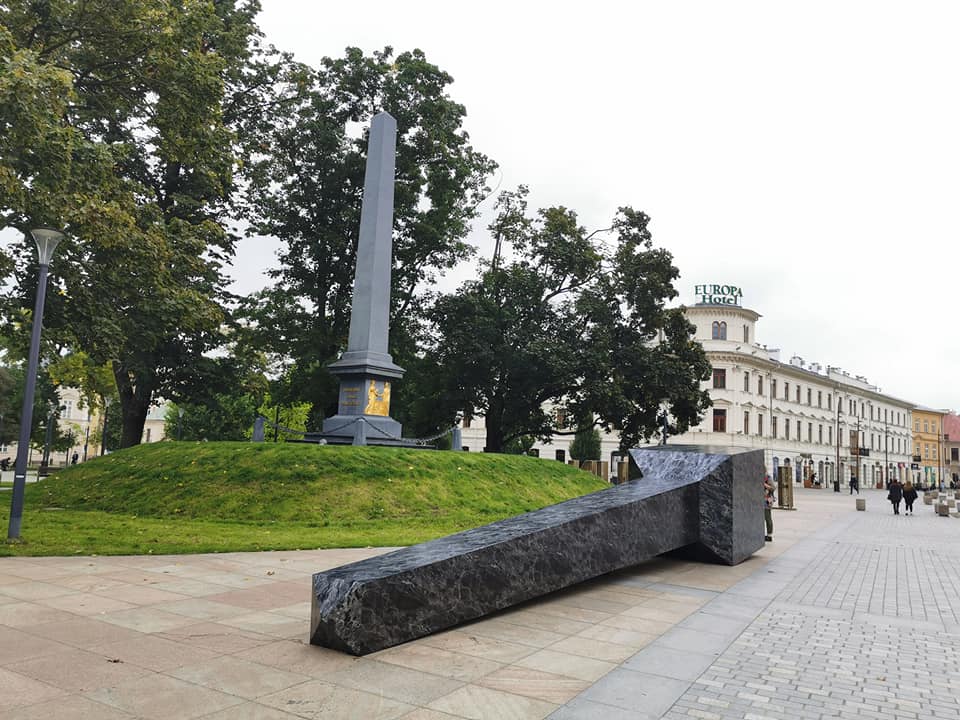
Sculpture in public space: Social Marble: Cover, Lublin
2021
The sculpture was made in the form of a plywood obelisk wrapped in "marble" foil. The object was located near the stele commemorating the Union of Lublin and criticised the way in which the illegitimate Belarusian regime tries to rewrite history, misappropriating and destroying historical facts.
2021
The sculpture was made in the form of a plywood obelisk wrapped in "marble" foil. The object was located near the stele commemorating the Union of Lublin and criticised the way in which the illegitimate Belarusian regime tries to rewrite history, misappropriating and destroying historical facts.
5
Pyramid of Alienation
Fear is one of the pervasive themes of contemporary myths about Belarus. Censorship, and even more so self-censorship, is incredibly powerful there. Belarusian citizens are cut off from their government, but delegate representatives to take care of all spheres of their lives. The many bans include also quite absurd ones. For example, after a series of "silent protests" in 2011, the authorities banned applause in public places (and a person with both amputated hands was arrested for applauding). The relief frieze titled Solidarity is located in the centre of Minsk. In the upper part of the frieze, one can see a pyramid formed by two banners with an arch, a sickle and a ball in the centre. Apart from the symbol of an omniscient eye, which in the context of Belarus is an image of total control in the Pyramid of Alienation, there is also the Colourless Rainbow (a symbol of normativity, and a reference to the Friendship of Nations Arch in Kyiv, which is to be pulled down because of the war) and Self-amputation Sickle (a symbol of alienation and subordination). The neon indicates in the exhibition a mystical symbol of the observer and demiurge as well as the political aspect, pointing to the context of post-revolution Belarus, alienated and usurped, a return to which is impossible due to censorship and a risk of losing personal liberties, health or even life.
︎
The first Pyramid of Alienation drawing was made in 2011
At the exhibition:
Fig. 2, 8
Showcases ︎ C, ︎ D

This pyramid is not only one of the key images of the project, but also part of the logo which the artist imprints on his work.
6
We are Stern Consumers of Cultural Revolutions
We are Stern Consumers of Cultural Revolutions is another cycle of works integrated into the show. The cycle traces back the approach to the legacy of historical avant-garde in Vitebsk. In the early 1920s, the city of Vitebsk was home to the UNOVIS school of art. The artist points out that during the years of the Cold War the ideas of the avant-garde were far more positively received in Western culture, while in Belarus Suprematism and the Constructivist ideas of UNOVIS were rejected for many years. In the cycle, the artist explores these processes and the attitude to the legacy of the avant-garde in the West and East, using the example of the reconstruction of the building of the People's School of Fine Arts in Vitebsk and the creation of a museum showcasing the history of the school. The artist demonstrates how the ideas of the avant-garde are returning to Belarus today in the form of mass culture and design for the mass consumer, and how the ideas of the avant-garde school are being integrated into contemporary life. It is the ideas of Suprematism found in Vitebsk that are so extensively displayed in the exhibition: Suprematist forms created from social marble are found in these very dense expanses of historical landscapes.
︎
The cycle has been made since 2012
At the exhibition:
Fig. 1, 10, 11
Showcases ︎ C, ︎ D

Neon We are Stern Consumers of Cultural Revolutions, 2012
The neon sign in the collection of ING bank is currently on display in Galeria Podgląd in Warsaw.
The neon sign in the collection of ING bank is currently on display in Galeria Podgląd in Warsaw.
7
The Spectres of Sovietism
The Suprematist slabs criss-crossing the landscape are here either fragments of catastrophes and tectonic shifts in the region, or heralds of the future total construction and reorganisation of the world, or spectres-evidence from the past, pointing to the causes of what is happening. We find the spectres of Sovietism in various sections of the exhibition: in the grand modernist gestures of utopias that have crumbled but are sprouting into modernity; in the desire of the invisible Soviet man to escape beyond the city into the context of nature and find his own voice; in the mutating authoritarian regimes that draw on the Soviet myth and their instruments of surveillance and repression. In one video, the "spectre of Sovietism" literally exists in the work. The video is based on selected takes from a feature movie Street Without End (1972), shot by Belarusfilm in Novopolotsk (the artist’s hometown), which was being developed at that time. For the sake of the video, the faceless protagonist, against the backdrop of urban space and natural landscapes, was "cut out", turned into a spectre, as an alienated phantom of the Soviet utopia and its failed aspirations, urbanism and nature, memory and nostalgia.
︎
At the exhibition:
Fig. 1, 3, 8, 10, 11
Showcase ︎ B

Video installation Street Without End
2018
Novopolotsk was a Soviet utopia that did not materialise; under the new political and economic circumstances, the city began to decline. This is also evidenced by the construction of residential quarters in the shape of the letters СССР (USSR), where the last house in the shape of the letter Р (R) was never completed due to the collapse of the Soviet Union.
2018
Novopolotsk was a Soviet utopia that did not materialise; under the new political and economic circumstances, the city began to decline. This is also evidenced by the construction of residential quarters in the shape of the letters СССР (USSR), where the last house in the shape of the letter Р (R) was never completed due to the collapse of the Soviet Union.
8
Cartography of the entire archive
The entire exhibition is a total archival installation, a quasi-scientific atlas resulting from the study of processes taking place in geopolitics, culture, nation-building, history, and psychology. The artist often draws on museum strategies, creating extensive archives, linking together research cycles. He employs the aesthetics of history museums, hyper-narrative and intentionally excessive detail in the logic of exhibition creation. He uses showcases and constructs glossaries. The glossary is the artist's trademark technique, which he uses regularly in all of his series. The background for the entire exhibition is a series of murals, depicting natural and urban landscape fragments, shots from museums and picket spaces, public monuments and intimate objects. All of these images provide peculiar contextual windows into the exhibition, conveying an ambivalent sense of both the fundamental and the ephemeral. The cartography of the exhibition is not restricted to the curator's text and the author's glossary. A bookmark on the artist's website – shabohin.org/Atlas – facilitates a closer examination of the show and the series of works on display. Here we can find all reference materials and further detailed descriptions of all the exhibits and elements of the exhibition in Polish, English, Belarusian, and Russian.
Exhibits:
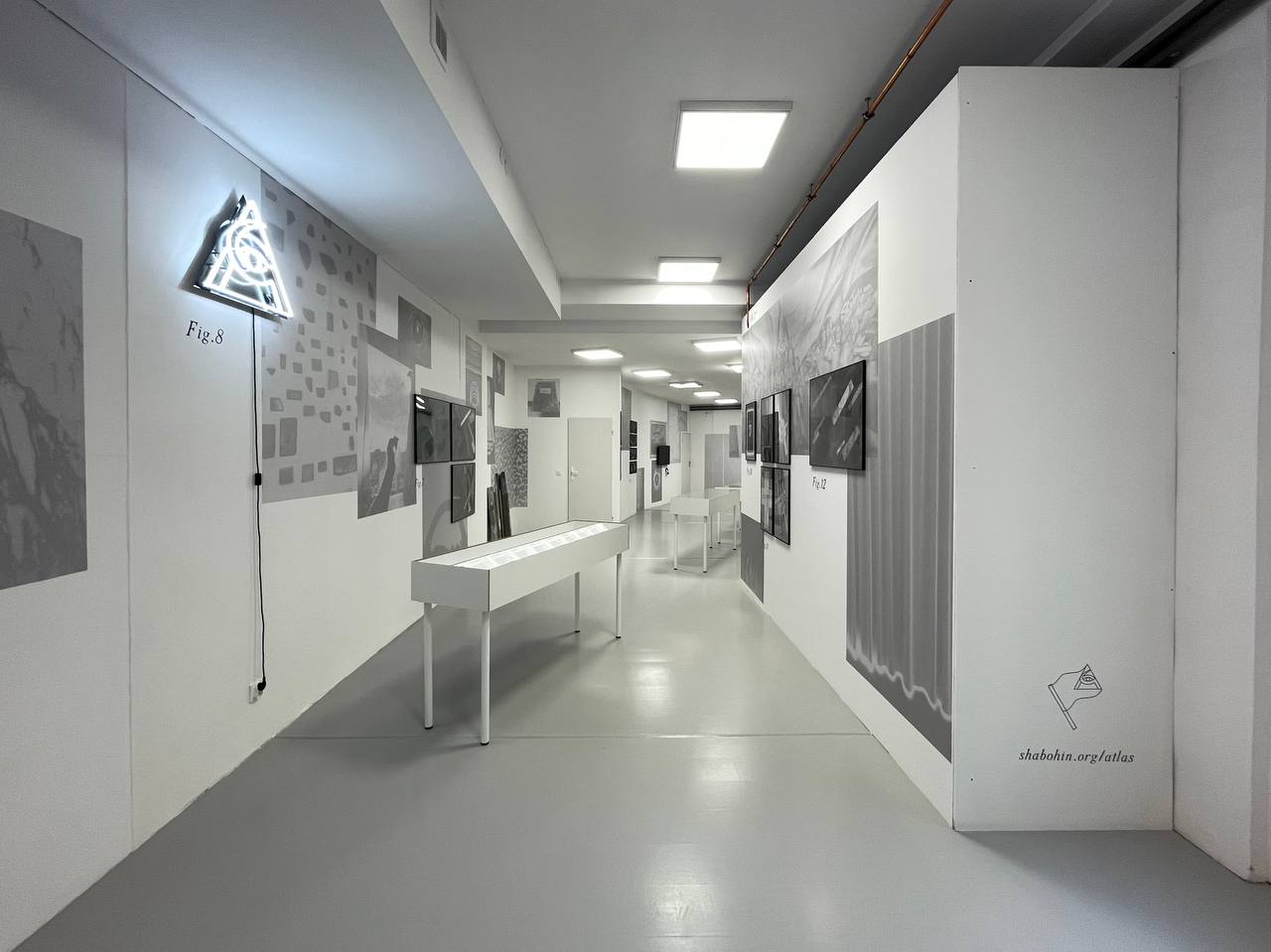
Fig.1
Photo Social Marble at the Venice Biennale
In the photo, the artist holds in his hand a sickle made of fake "social marble" (cardboard pasted over with a film with a marble pattern) against the background of St. Mark's Basilica in Venice, which is lined with thousands of sometimes rare marbles.

May 7, 2019
Fig.2
Video Atlas of Tectonic Landscapes: Through the Eclipse Corridor
The video shows a mystical mystery that occurs at the time of a total annular eclipse, which is a harbinger of tectonic shifts in the region. Suprematist objects traverse twilight landscapes: urban and natural views, landscapes of the Romantic era, primitive cave paintings, cruising areas, military smoke from the news feed and hordes of bats. The music was specially created for the video by the German composer Christoph Ogermann. The sound dissects the musical canons taken from the era of romanticism and deconstructs them into a noisy industrial rumble, which, together with the visual range, creates a phantasmagoric and eerie opera - a harbinger of catastrophes and transformations.
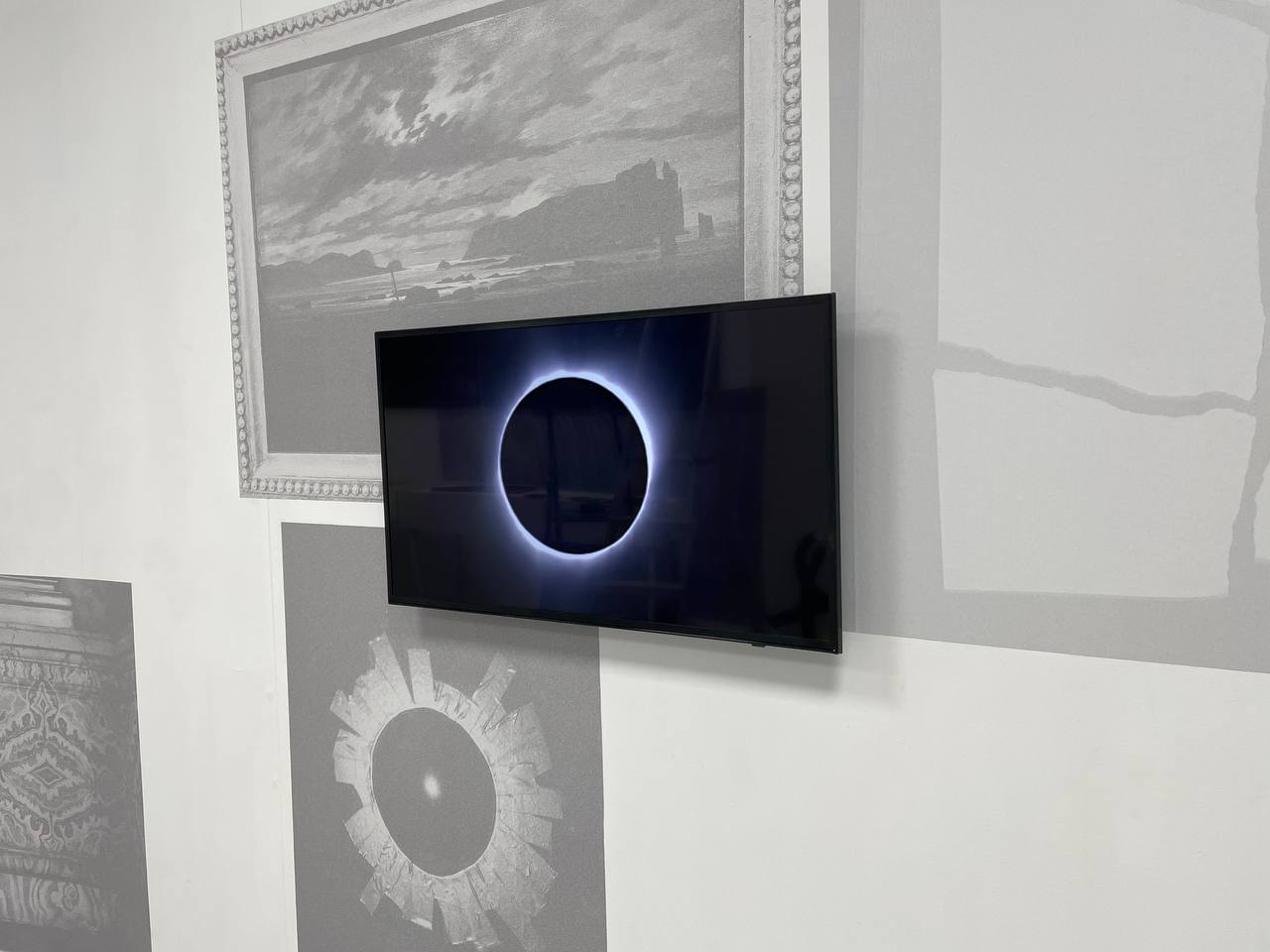
23’56”
2023
Sergey Shabohin
director, cameraman, editing, concept.
Christoph Ogiermann
composer and lyricist.
Musical composition:
SORRY MAM_Tectonics_Electronic Improvisation
texted and com-posed by Christoph Ogiermann
2021 – 2023 with the voices of Neue Vocalsolisten Stuttgart
and parts of MULTIeTUDE 2b played and sung by LENsemble Vilnius
and the public of the concert commissioned by platformB a project of Musik der Jahrhunderte
premiered at ECLAT festival new music Stuttgart
2023
Sergey Shabohin
director, cameraman, editing, concept.
Christoph Ogiermann
composer and lyricist.
Musical composition:
SORRY MAM_Tectonics_Electronic Improvisation
texted and com-posed by Christoph Ogiermann
2021 – 2023 with the voices of Neue Vocalsolisten Stuttgart
and parts of MULTIeTUDE 2b played and sung by LENsemble Vilnius
and the public of the concert commissioned by platformB a project of Musik der Jahrhunderte
premiered at ECLAT festival new music Stuttgart
Fig.3
Series of collages Plate Tectonics (Social Marble): Memory Censoring
A series of collages captures spontaneous monuments in Belarus - spaces of memory at the site of the death of Belarusian oppositionists. The authorities are fighting with such memorable places, destroying them, painting over the graffiti on the walls and covering the slogans on the pavement with salt. For collages, a film with the texture of "lichen granite" is used - as a symbol of the growing state censorship directed not only against all dissidents, but also against the memory of those who disappeared or died.
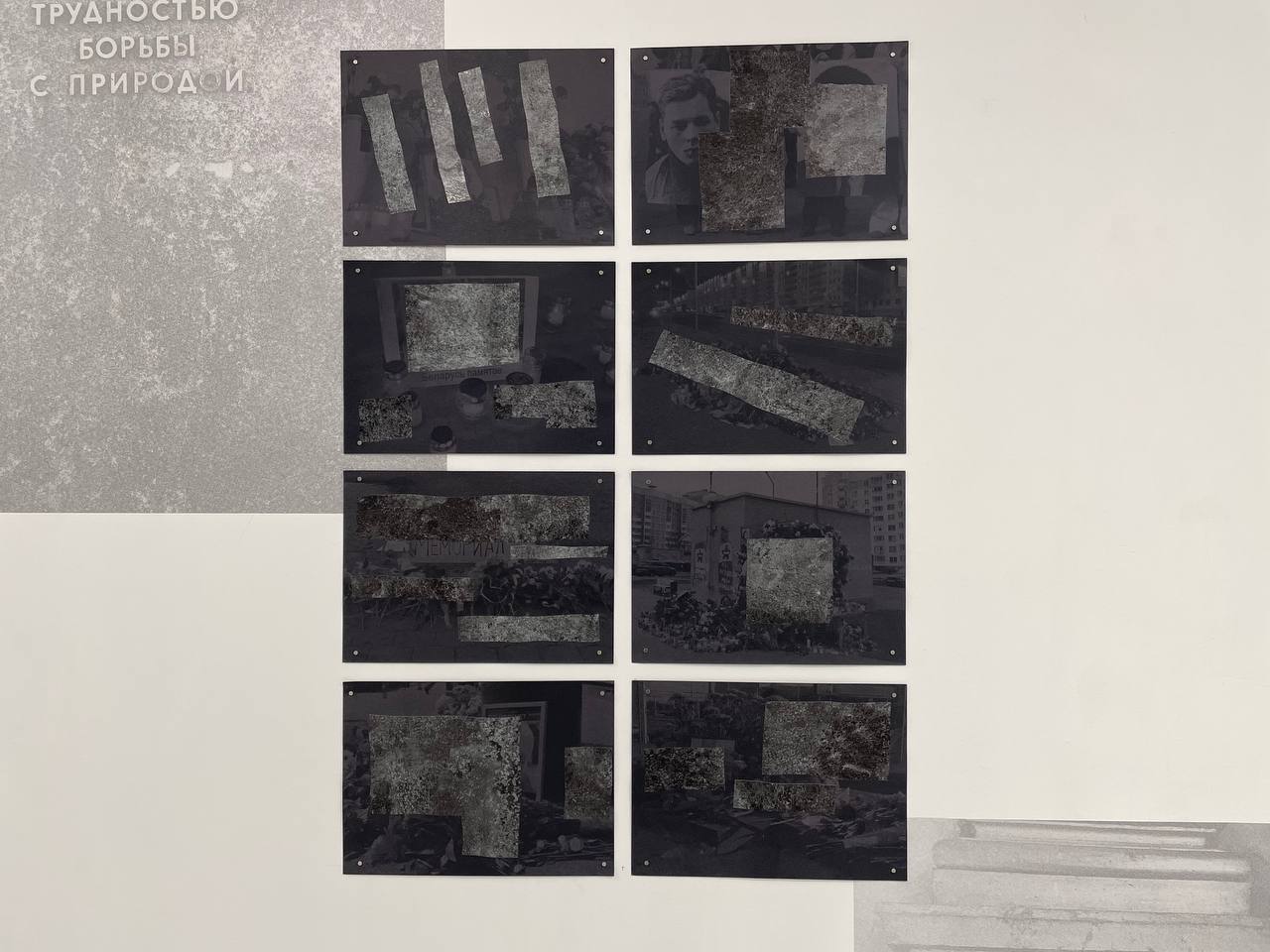
Full title: Plate Tectonics (Social Marble): Memory Censoring / Parallelepipeds With the Lichen-Marble Texture Censoring Images of Spontaneous Monuments at the Place of the Death of Belarusian Opposition Figures
The complete series consists of 9 collages
2021
The complete series consists of 9 collages
2021
Fig.4
Painting series with elements of collage Plate Tectonics (Social Marble): Black Smoke
Two black marble cuboids cross the sky with images of black smoke taken from a news feed about the war in Ukraine. The series depicts the confrontation of certain essential constructs in the twilight sky from the smoke.
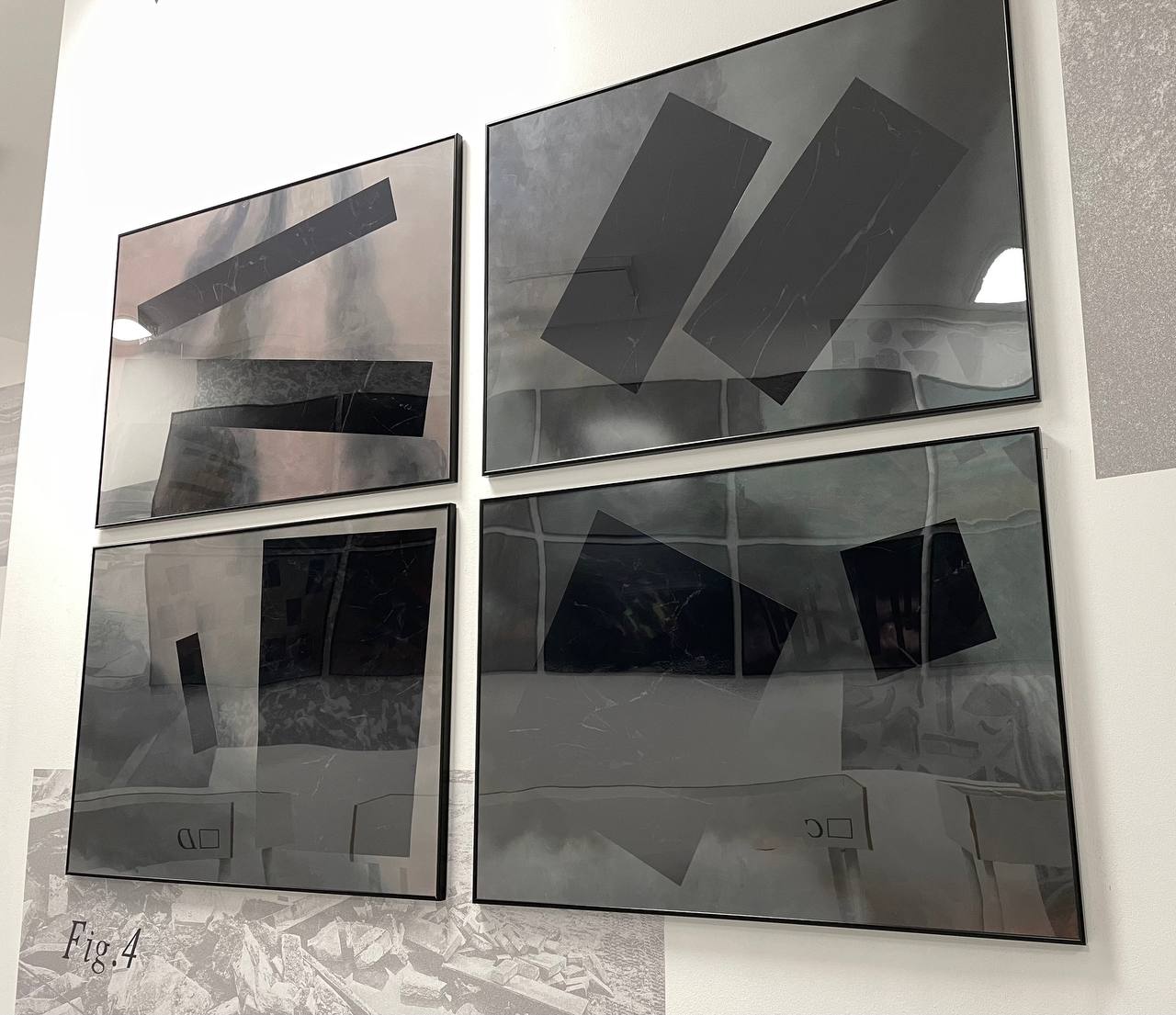
Full title: Plate Tectonics (Social Marble): Black Smoke / Two Rival Black Parallelepipeds (Social Marble) on the Background of the Black Smoke and Air Raids
The complete series consists of 12 pieces
2022
The complete series consists of 12 pieces
2022
Fig.5
Painting series with elements of collage Plate Tectonics: Twilight of Freedom
Twilight landscapes devoid of a horizon line are executed in the colors and traditions of romantic landscape painting. Against their background, black Suprematist parallelepipeds (from 1 to 12) move like tectonic plates or phantoms of freedom.

Full title: Plate Tectonics: Twilight of Freedom / Black Slabs (Social Marble) Tending to the Diagonally on the Background of the Twilight Cloudy Sky Without a Horizon Line
2021
2021
Fig.6
Installation Plate Tectonics (Social Marble): Gravestones
Pieces of fake “social marble” are placed on granite and marble slabs, which the authorities in the Minsk metro use to paste over graffiti on marble and granite walls.
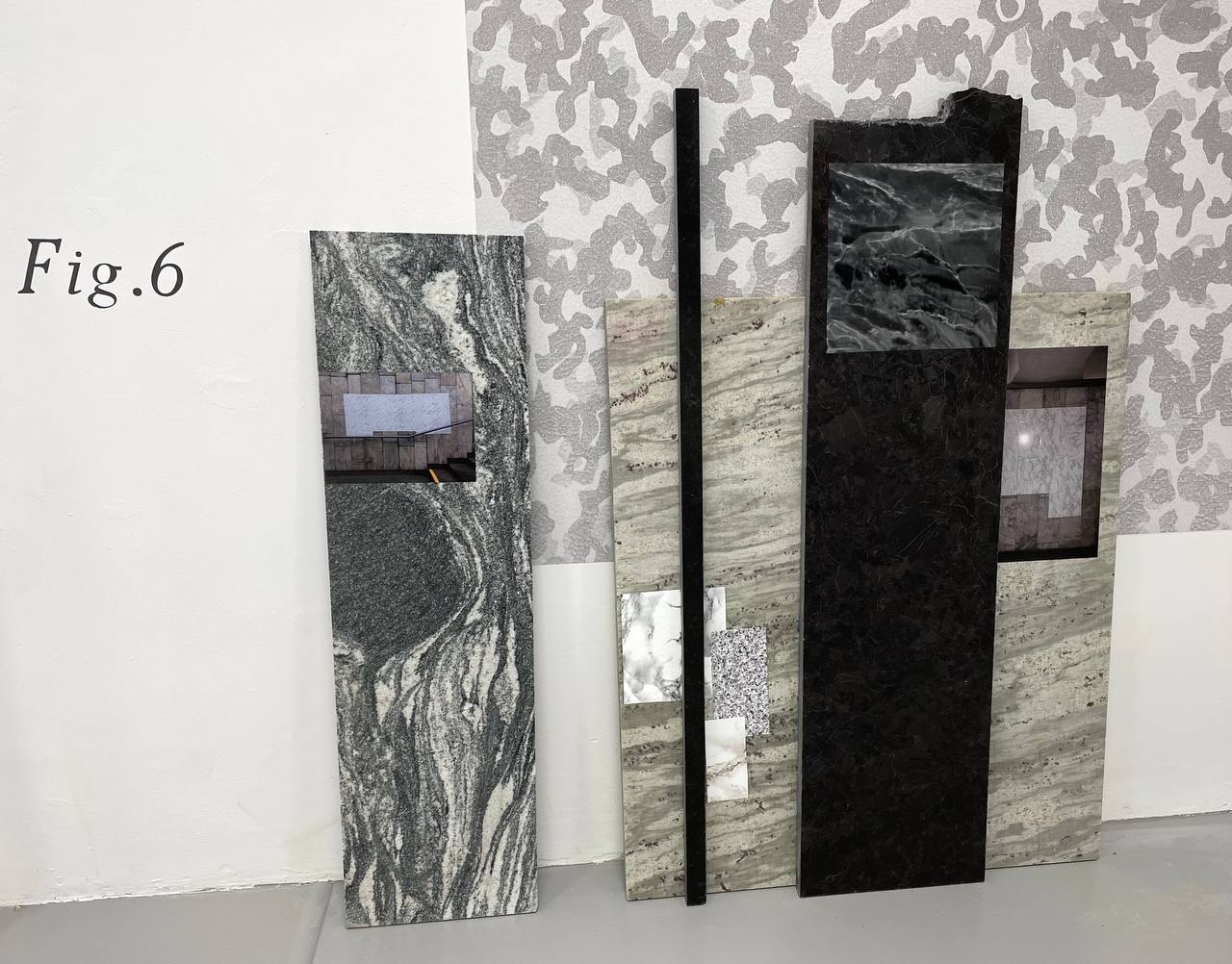
Installation
Thank you for your help Kamieniarstwo Michał Palacz
2023
Thank you for your help Kamieniarstwo Michał Palacz
2023
Fig.7
Painting series with elements of collage Atlas of Tectonic Landscapes: Primitive Collisions
The series consists of three primitive rock paintings reproduced on paper, against which a Suprematist struggle takes place between parallelepipeds of different shapes and materials.

2023
Fig.8
Neon sign Pyramid of Alienation
The relief frieze titled Solidarity is located in the centre of Minsk. In the upper part of the frieze, one can see a pyramid formed by two banners with an arch, a sickle and a ball in the centre. Apart from the symbol of an omniscient eye, which in the context of Belarus is an image of total control in the Pyramid of Alienation, there is also the Colourless Rainbow (a symbol of normativity, and a reference to the Friendship of Nations Arch in Kyiv, which is to be pulled down because of the war) and Self-amputation Sickle (a symbol of alienation and subordination). The neon indicates in the exhibition a mystical symbol of the observer and demiurge as well as the political aspect, pointing to the context of post-revolution Belarus, alienated and usurped, a return to which is impossible due to censorship and a risk of losing personal liberties, health or even life.
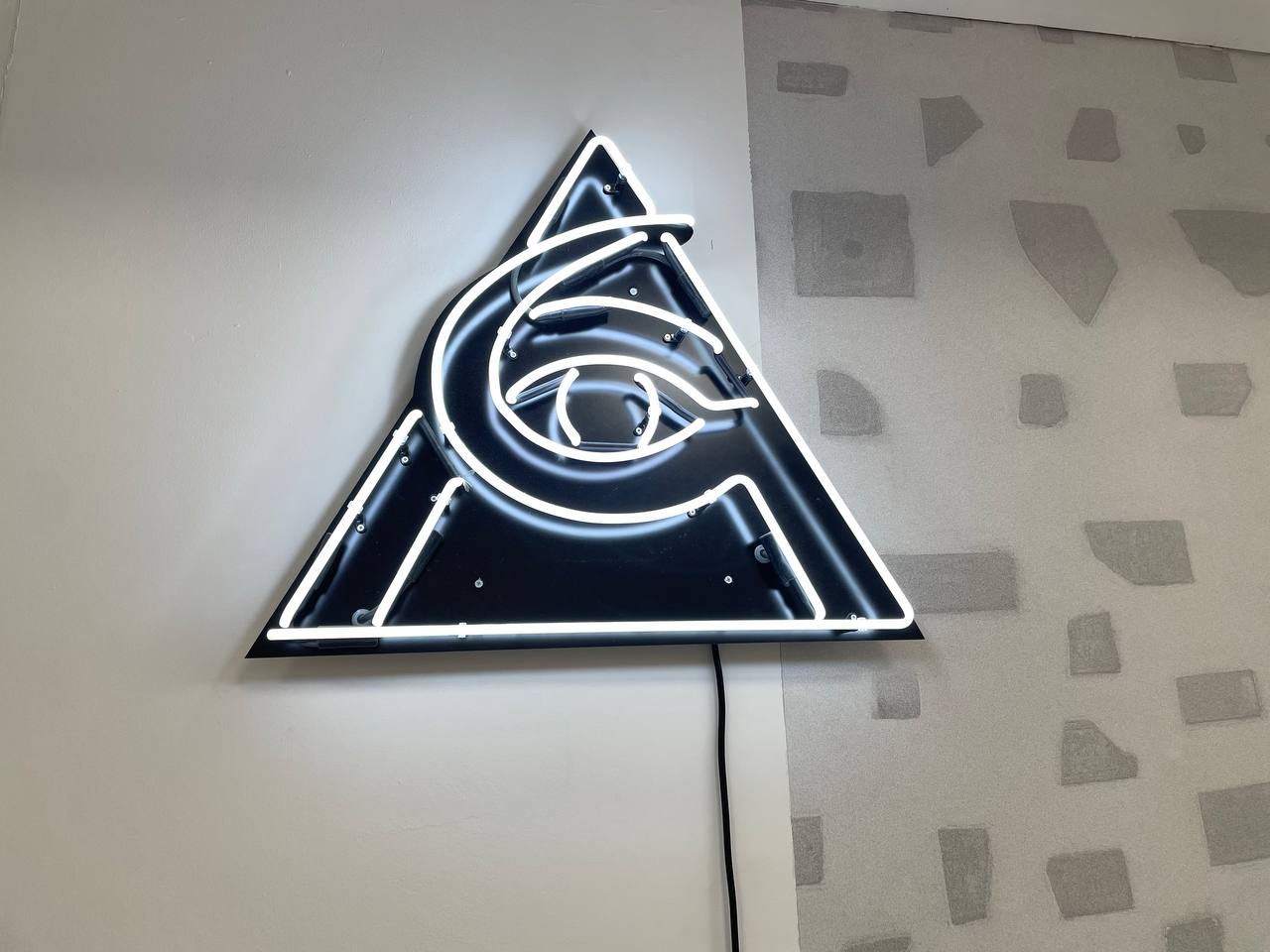
2020
Fig.9
Two-channel video Mandrake Gardens
The theme of twilight freedom and the connection between the natural and the sexual is manifested here in many works at the exhibition, the main of which is the two-channel video of the same name about two parks: Hasenheide in Berlin and Friendship of Peoples Park in Minsk. During the pandemic in the summer of 2020, nightclubs closed in Berlin, and city residents began throwing illegal parties in parks. Especially notable were the raves of many thousands in Hasenheide Park. In this part, the dense park is an attraction for cruising and queer orgies. At the same time, an election campaign was going on in Belarus. On July 30, 2020, an official picket of Svetlana Tikhanovskaya took place in the Friendship of Peoples Park in Minsk. Two screens show in parallel two seemingly different contexts: illegal raves and official pickets; the mild reaction of the Berlin police and the aggression of the Minsk security forces; the sexuality of the cruise and the energy of protest; white ribbons with a knot on the trees as a symbol of the LGBTQ+ community and white ribbons on the arms as a symbol of the protest movement in Minsk; the myth of a mandrake growing from a male seed, and Belarusian mythology with potato semiotics; etc. The double video does not so much compare contexts as it demonstrates an unquenchable thirst for freedom against the backdrop of urban park landscapes.

15'00"
2020
2020
Fig.10
Collage We are Stern Consumers of Cultural Revolutions. Beat the Whites with a Red Wedge
In the 1920s, the avant-garde movement UNOVIS arose in the Vitebsk public school, within which the theory of Suprematism was developed. The heritage of the avant-garde was forgotten in Belarus, and the school building itself was in a ruined state until 2016. One of the foreign embassies presented the building with new plastic windows, which by mistake turned out to be wider than the window openings, and instead of ordering new ones, the openings were widened in the historical building. This is just one of the plots of the monstrous reconstruction of the building.
︎︎︎ See also Fig.11
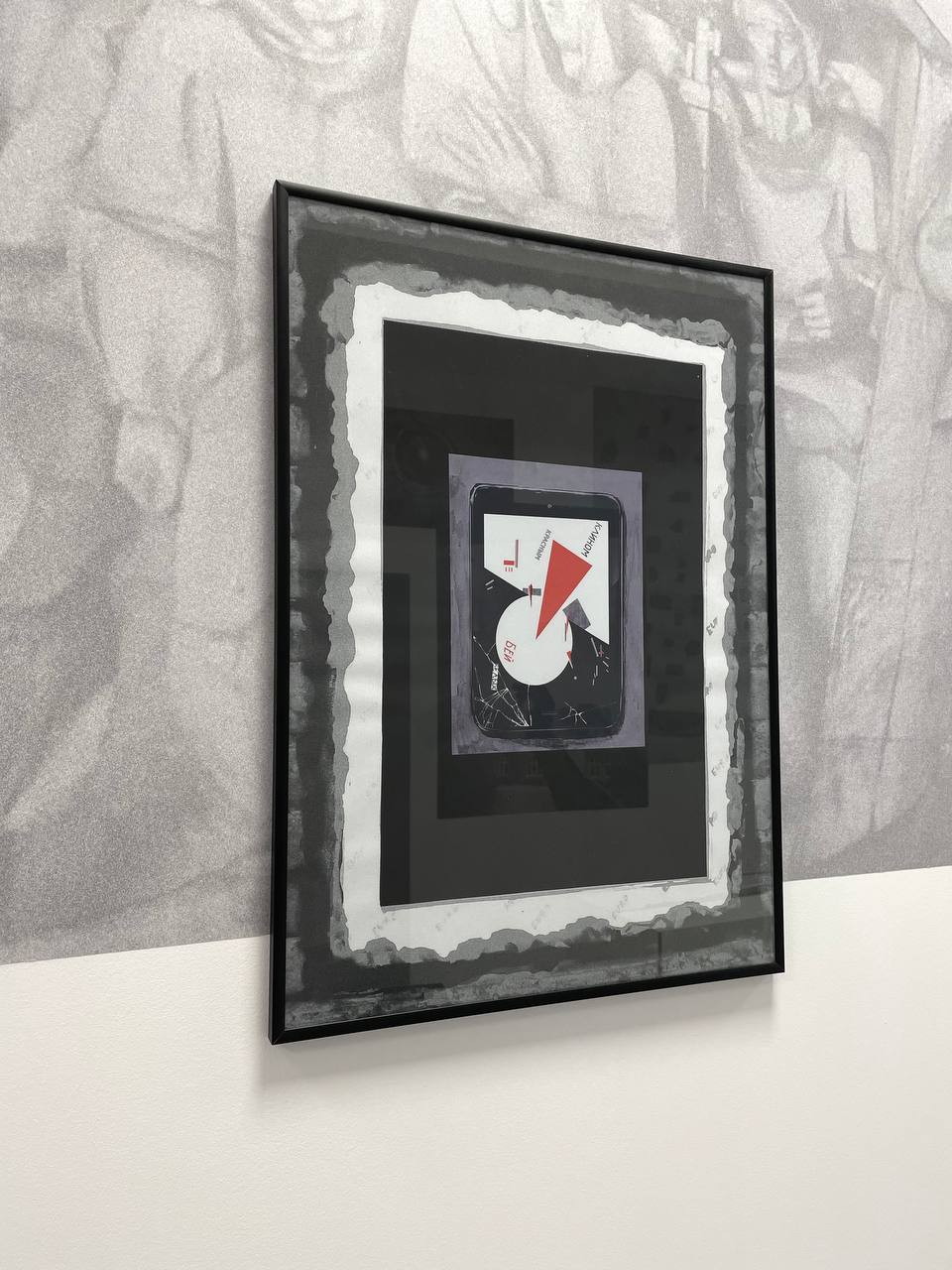
2013
Fig.11
Collage series We are Stern Consumers of Cultural Revolutions (Social Marble): Patches
Famous Suprematist compositions (developed in this case by Kazimir Malevich and El Lissitzky) are reproduced from “social marble” and placed against the backdrop of the renovation of the building of the Vitebsk Art School, within the walls of which they were created. The series is called Patches, which emphasizes the attempts to patch up historical gaps in the creation of a new museum. The fact that the directorate of the new museum laid out a floor of marble and granite in the hall, reproducing El Lissitzky's drawing "Beat the Whites with a Red Wedge" deserves special mention.
︎︎︎ See also Fig.10

The complete series consists of 17 collages
2019
2019
Fig.12
Painting with elements of collage Atlas of Tectonic Landscapes: Harbinger Ring
Painting is an annular eclipse – a disturbing harbinger of change.
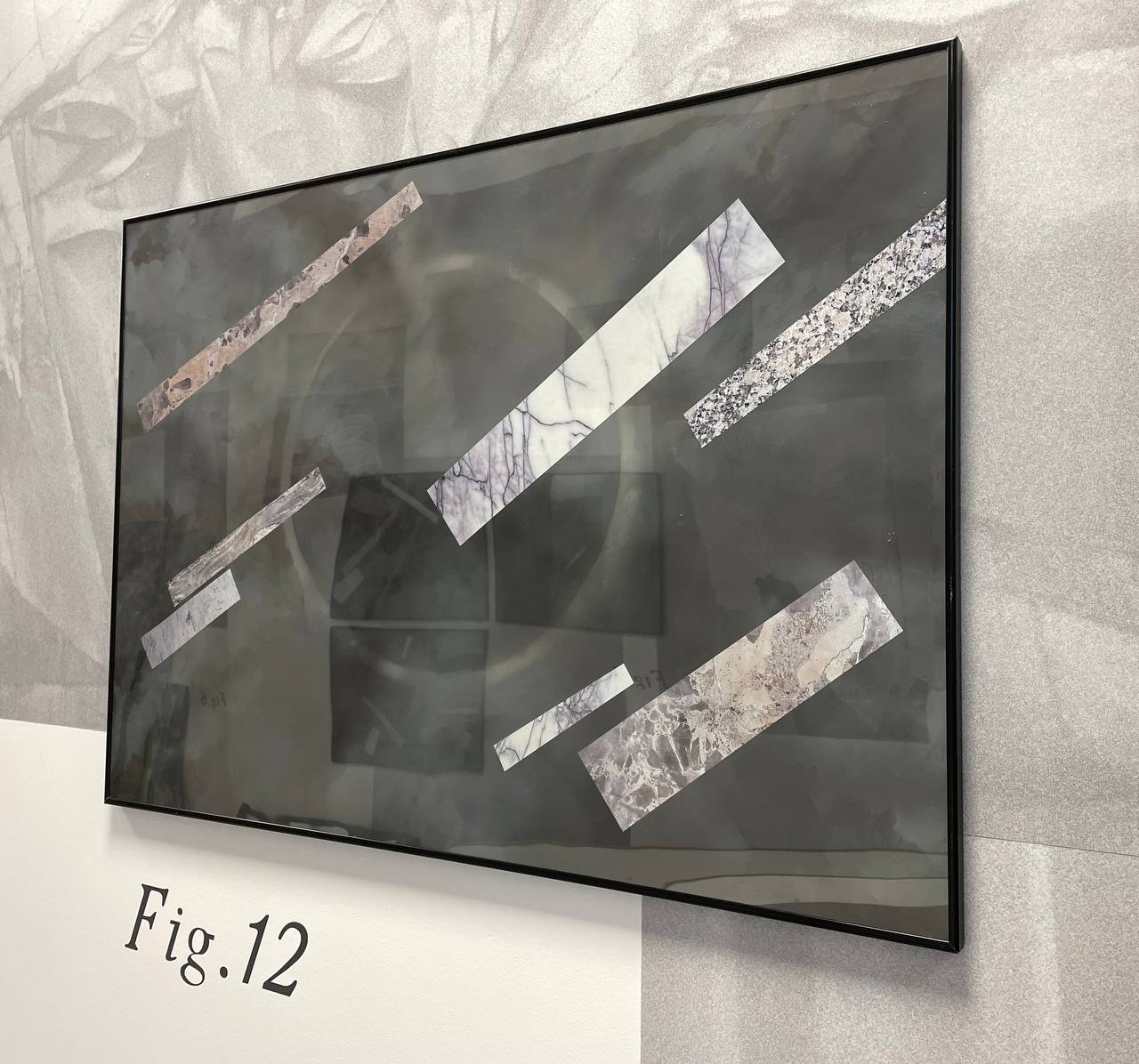
2023
Showcases:
︎ A

The showcase includes an information block,
link to the website and brochures.
Exhibits:
A series of collages Plate Tectonics (Social Marble): Mariupol Landscapes
The series combines so-called "bloody granite", newspaper clippings about destroyed Mariupol and postcards depicting Ukrainian landscapes created by the Romantic artist Arkhip Kuindzhi (who is also from Mariupol).

Full title: Plate Tectonics (Social Marble): Mariupol Landscapes / Reproductions of Arkhip Kuindzhi's Landscapes and Photos from Newspapers Depicting the Ruined Mariupol Glued Together with a Foil Depicting "Bloody Granite"
2022
2022
︎ B

Exhibits:
Video Street Without End
The video was created on the basis of selected frames of the feature film "Street Without End" (1972) by the film studio "Belarusfilm". It was filmed in Novopolotsk (the artist's hometown), which at that time was just beginning to be built. For the video, the faceless hero against the backdrop of urban space and natural landscapes was “cut out”, turned into a ghost, as an alienated phantom of the Soviet utopia and its unfulfilled aspirations, urbanism and nature, memory and nostalgia.

Frame from video
5'22"
2018
5'22"
2018
A series of collages Street Without End: Mosaic Parade
Marble tape is pasted over with photographs depicting collapsing Soviet mosaics on the walls at the entrances of residential buildings in Novopolotsk.
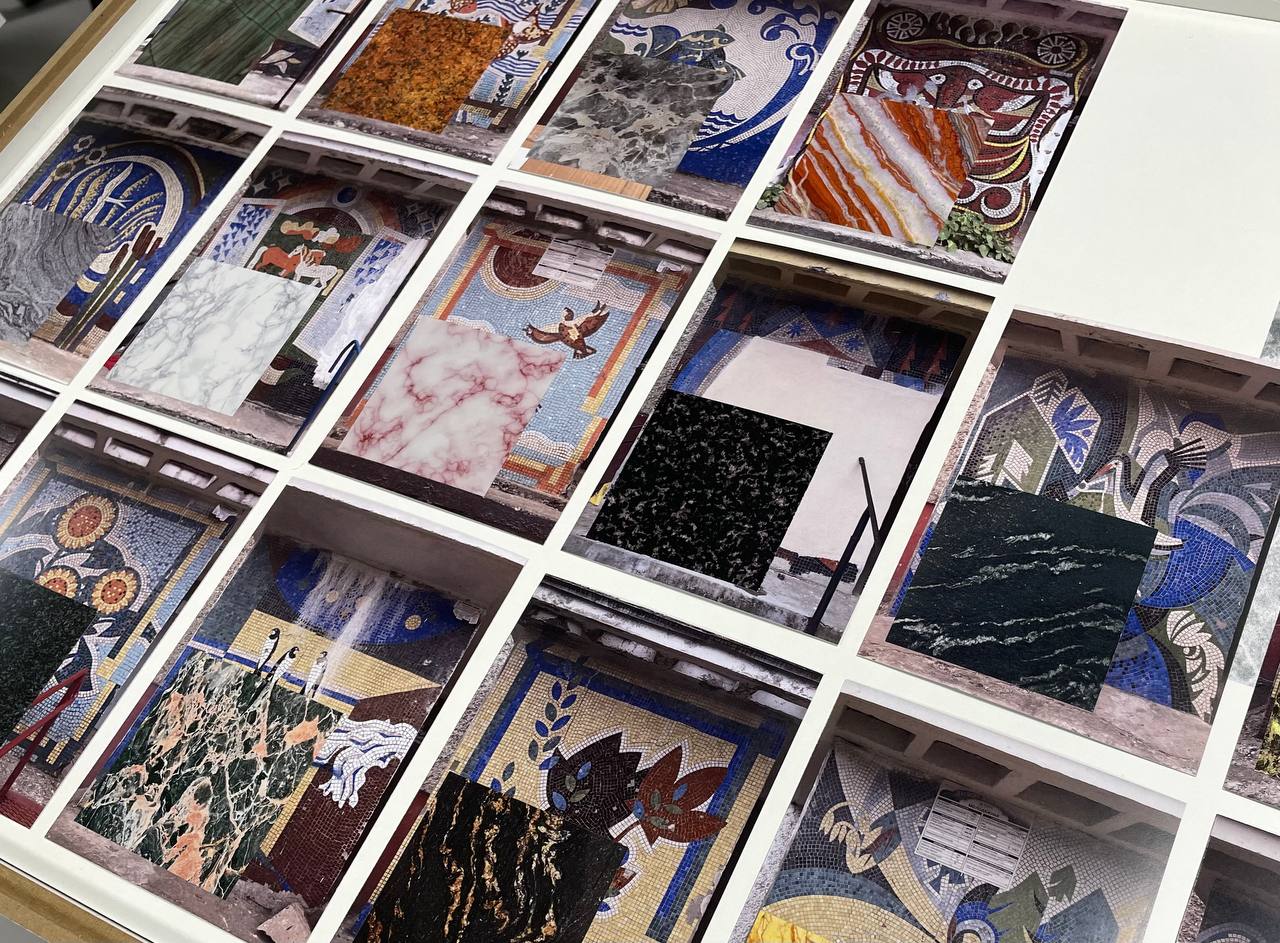
The complete series consists of 24 collages.
2023
2023
A series of collages Plate Tectonics (Social Marble): Quagmire
The swamp is a characteristic landscape of Belarus, around which many myths are built and the Belarusian identity is constructed.
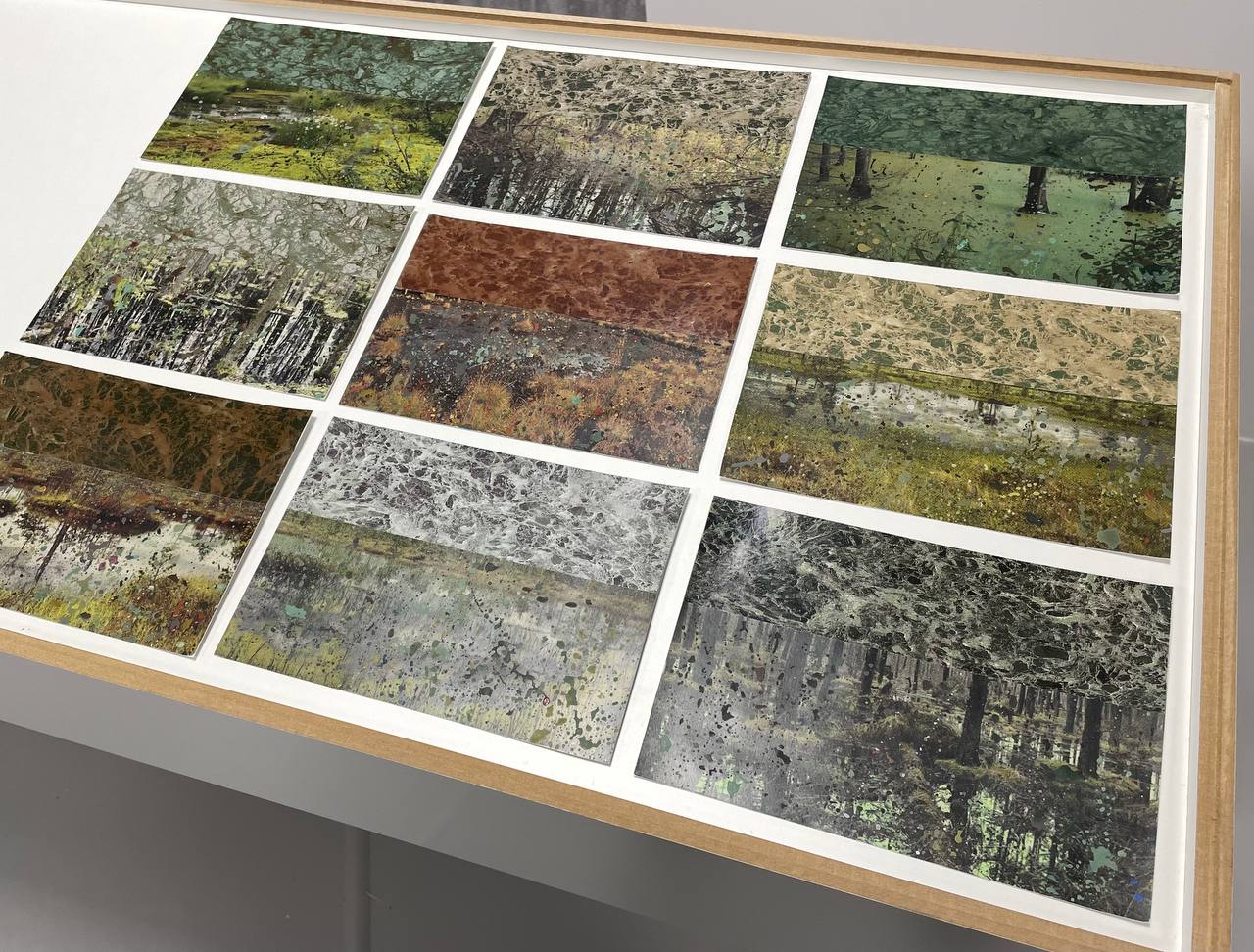
Full title: Plate Tectonics (Social Marble): Quagmire / A Film With Marsh-Colored Marble Texture Pasted on a Paint-Splattered Images of a Swampy Landscapes Without a Horizon LineThe complete series consists of 18 collages.
2022
2022
Photo wallpaper
Novopolotsk was a Soviet utopia that did not come true, and in the new political and economic conditions, the city began to decline. This is also indicated by the construction of residential quarters in the shape of the letters of the СССР (USSR), but the last house in the shape of the letter P (R) was not completed due to the collapse of the Soviet Union.

Quarter in Novopolotsk with buildings in the form of three letters C (S), Google Maps
2019
2019
︎ C
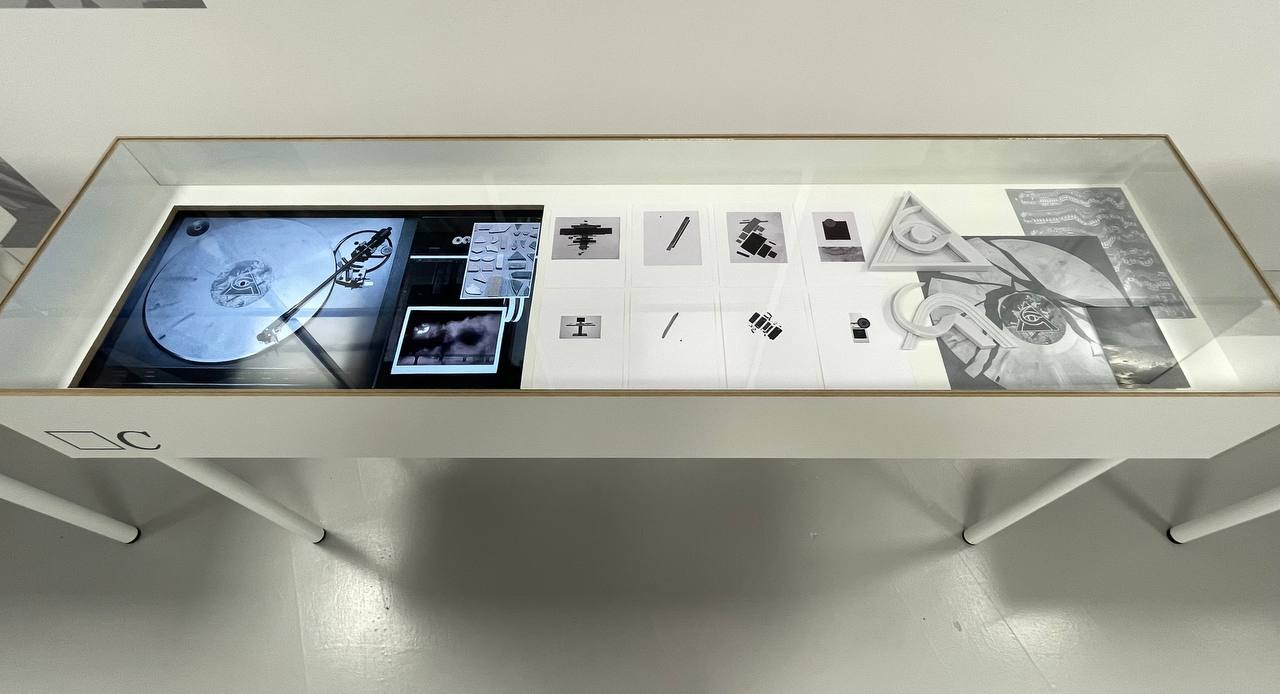
Exhibits:
Video Atlas of Tectonic Landscapes: Dismembered Melancholy (Broken Vinyl)
Musical works were written especially for the video. Belarusian pianist Olga Podgayskaya played Chopin's Fantasy on a Prelude in E Minor, where she transformed the melody typical of the romantic era in different ways. As part of the Gray Mandorla project, Belarusian musician Mikita Bubashkin created an ambient composition, reproducing the melancholic melody typical of the era of romanticism, but dissected using modern musical techniques. The disc closes with a minimalist melancholic composition by the Belarusian group Sgustok, which, like the hackneyed vinyl itself, constantly repeats element after element.
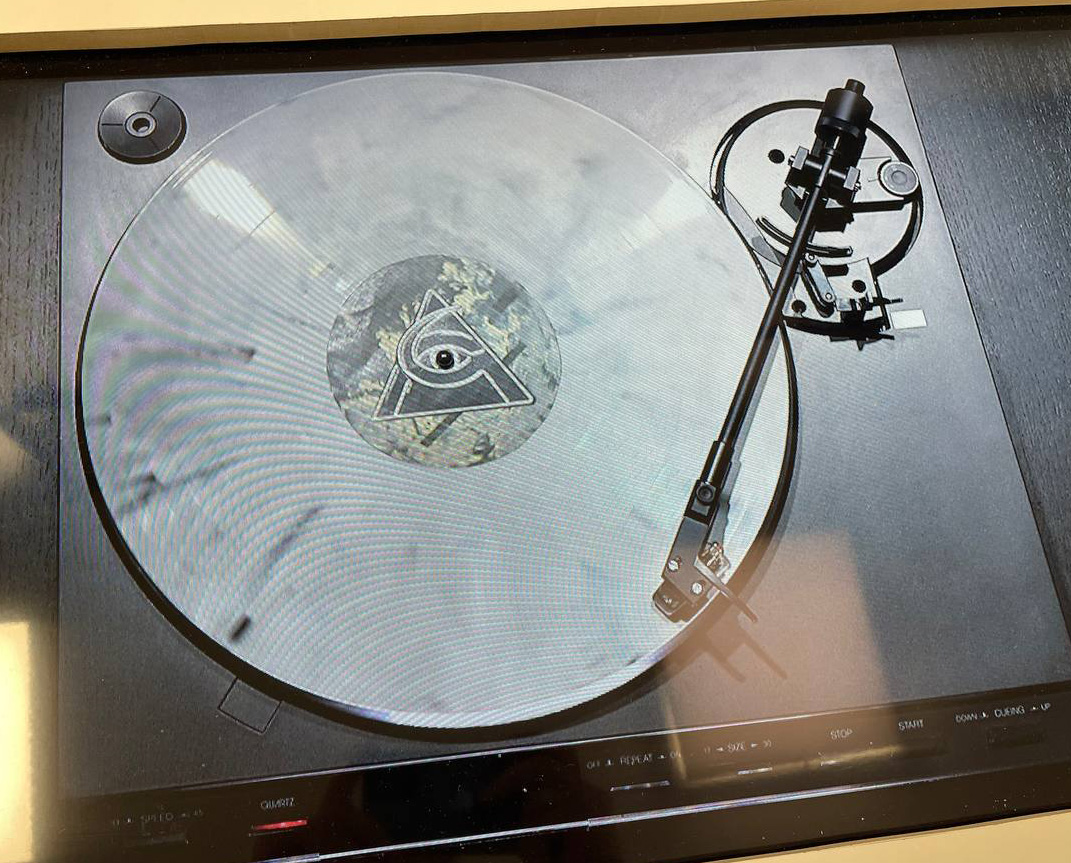
Frame from video
2023
Idea, direction and editing - Sergey Shabohin.
Operator assistance - George Minets.
Musical works:
Olga Podgayskaya - Fantasy on the Prelude in E Minor by F. Chopin, 2023;
Mikita Bubashkin and Gray Mandorla - Dismembered Melancholy, 2023;
Sgustok – Love Kills, 2008
2023
Idea, direction and editing - Sergey Shabohin.
Operator assistance - George Minets.
Musical works:
Olga Podgayskaya - Fantasy on the Prelude in E Minor by F. Chopin, 2023;
Mikita Bubashkin and Gray Mandorla - Dismembered Melancholy, 2023;
Sgustok – Love Kills, 2008
Multiplied object Pyramid of Alienation (Construct)
The object reproduces the Pyramid of Alienation in the form of a collapsible transformer sculpture.
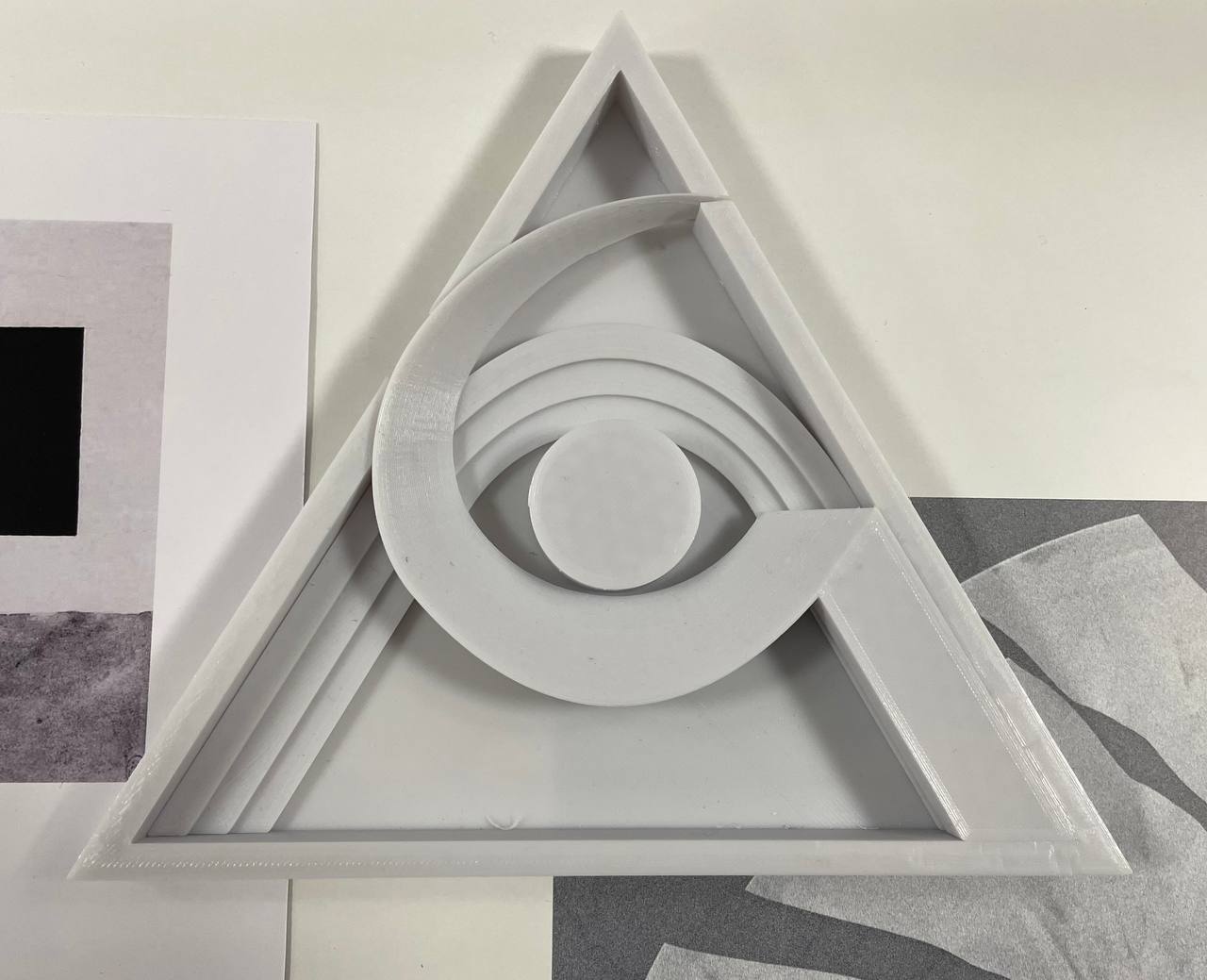
2023
3D printing:
modeling and idea: Sergey Shabohin
modeling and printing: Roman Shabohin
3D printing:
modeling and idea: Sergey Shabohin
modeling and printing: Roman Shabohin
Series We are Stern Consumers of Cultural Revolutions. 1920s Drawings vs. 2010s Ads
The famous drawings of UNOVIS representatives from the 1920s are compared with advertisements found in the urban space of Vitebsk in the 2010s.
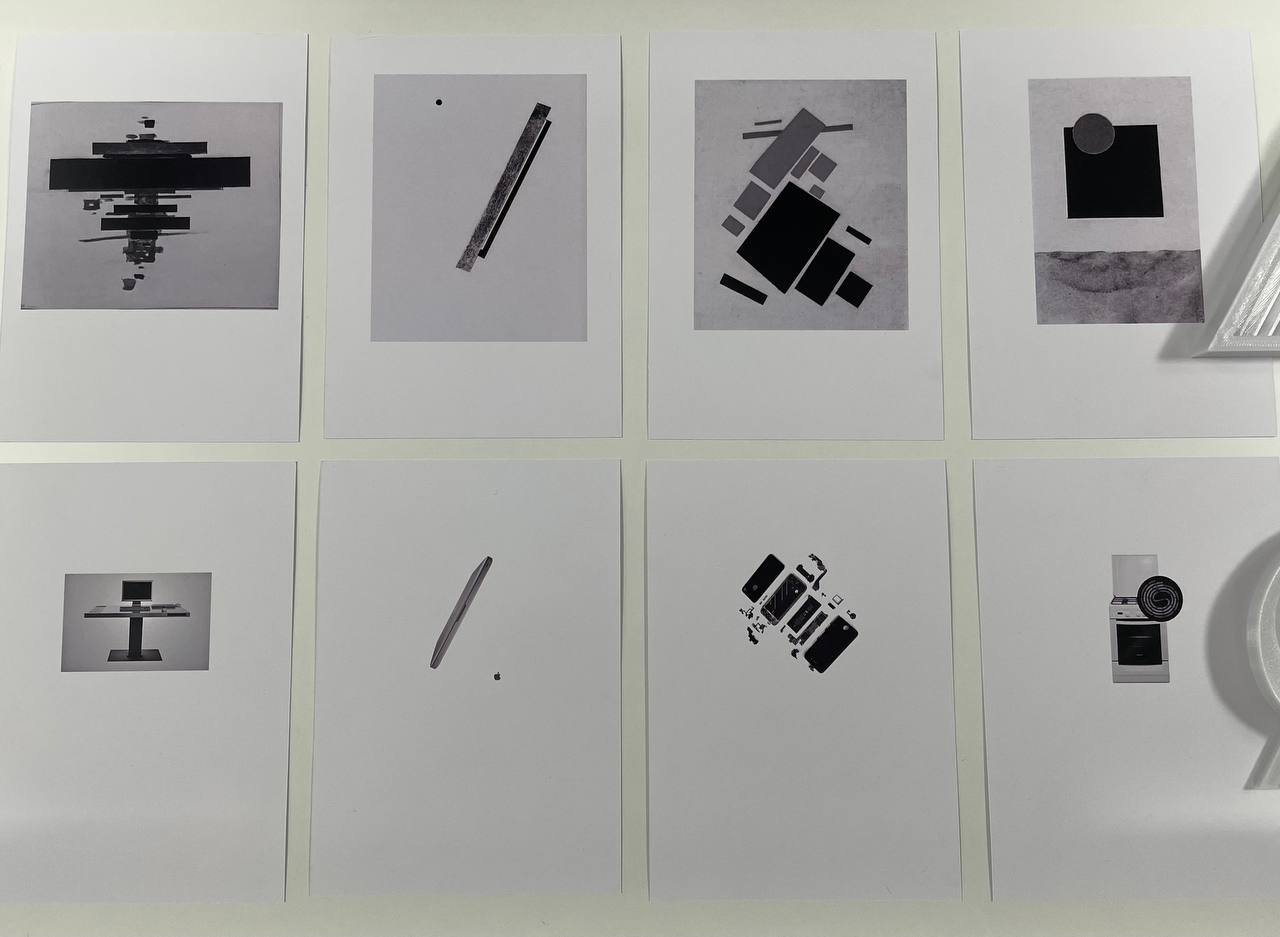
The complete series consists of 12 cards.
Authorship of drawings from left to right: Lazar Khidekel, El Lissitzky, Kazimir Malevich, Vera Ermolaeva
2012
Authorship of drawings from left to right: Lazar Khidekel, El Lissitzky, Kazimir Malevich, Vera Ermolaeva
2012
Collage Plate Tectonics (Social Marble): Storm
Half of the postcard depicting a landscape with a sea storm is pasted over with a dark marble foil.
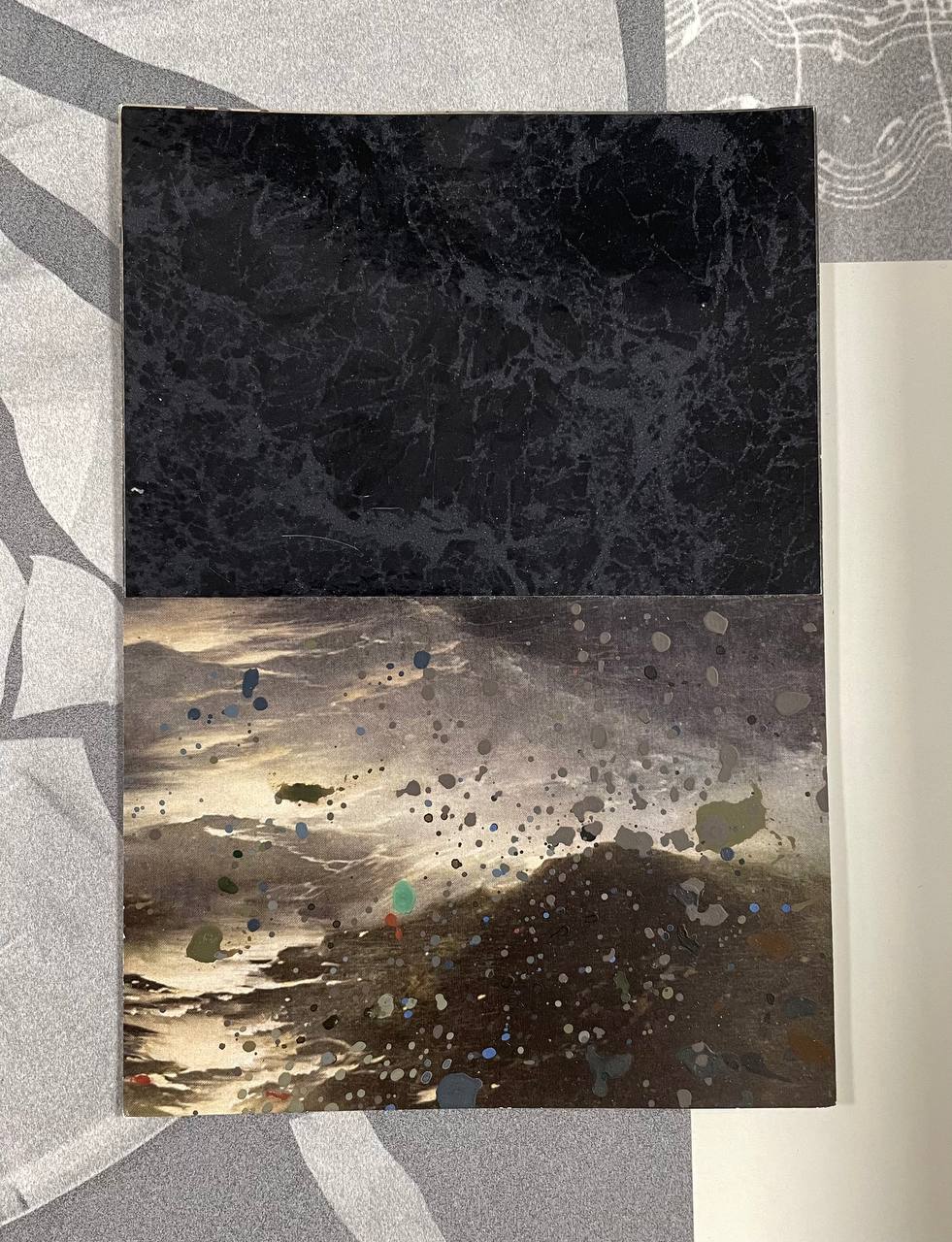
Fragment of a series of 8 collages.
Full title: Plate Tectonics (Social Marble): Storm / A Foil With Ocean-Colored Marble Texture Pasted on a Paint-Splattered Fragment of a Romantic Seascape
2022
Full title: Plate Tectonics (Social Marble): Storm / A Foil With Ocean-Colored Marble Texture Pasted on a Paint-Splattered Fragment of a Romantic Seascape
2022
Mural
Broken vinyl, 2023
Deformed Prelude in E minor by Fryderyk Chopin, 2023
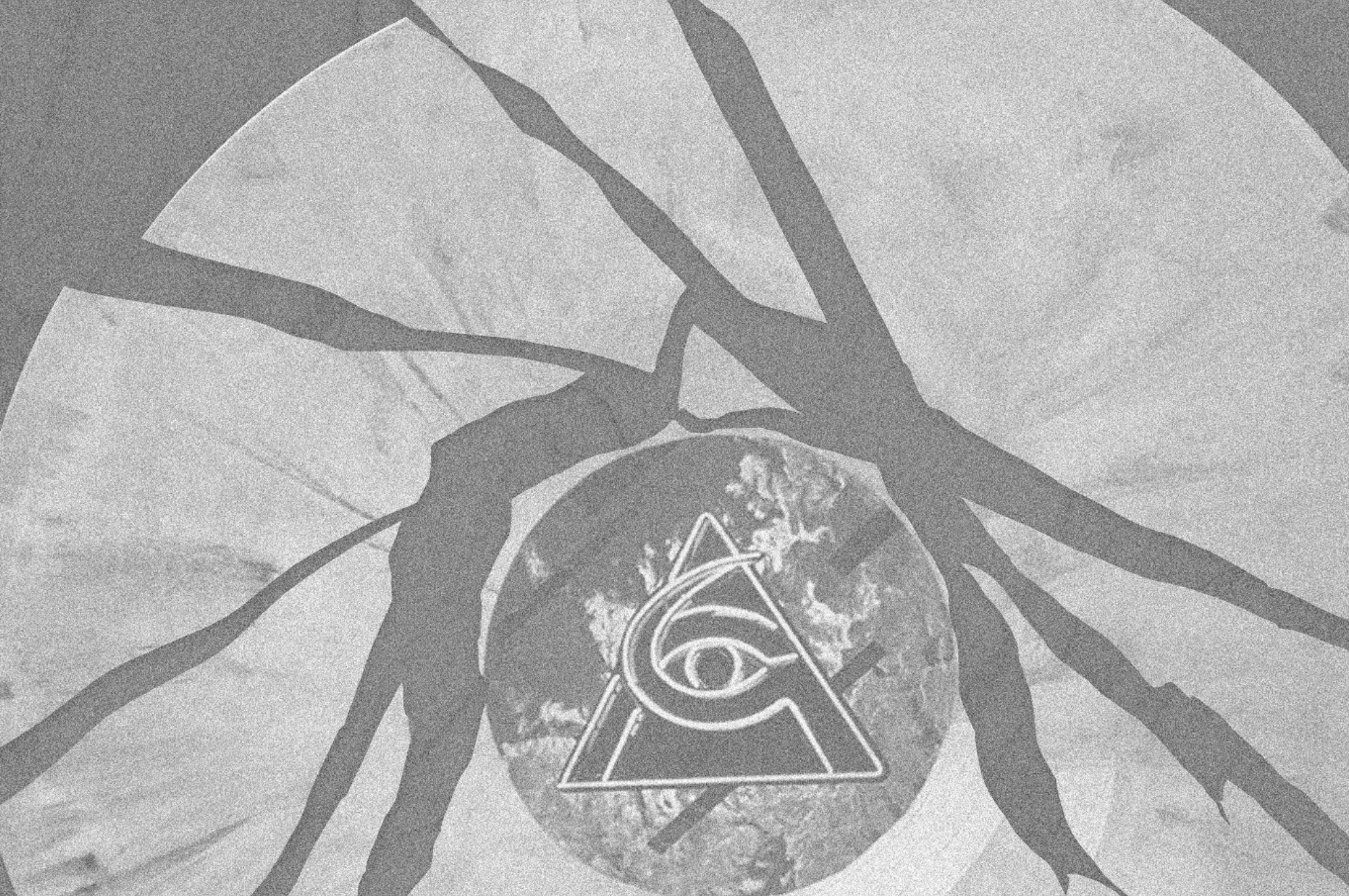
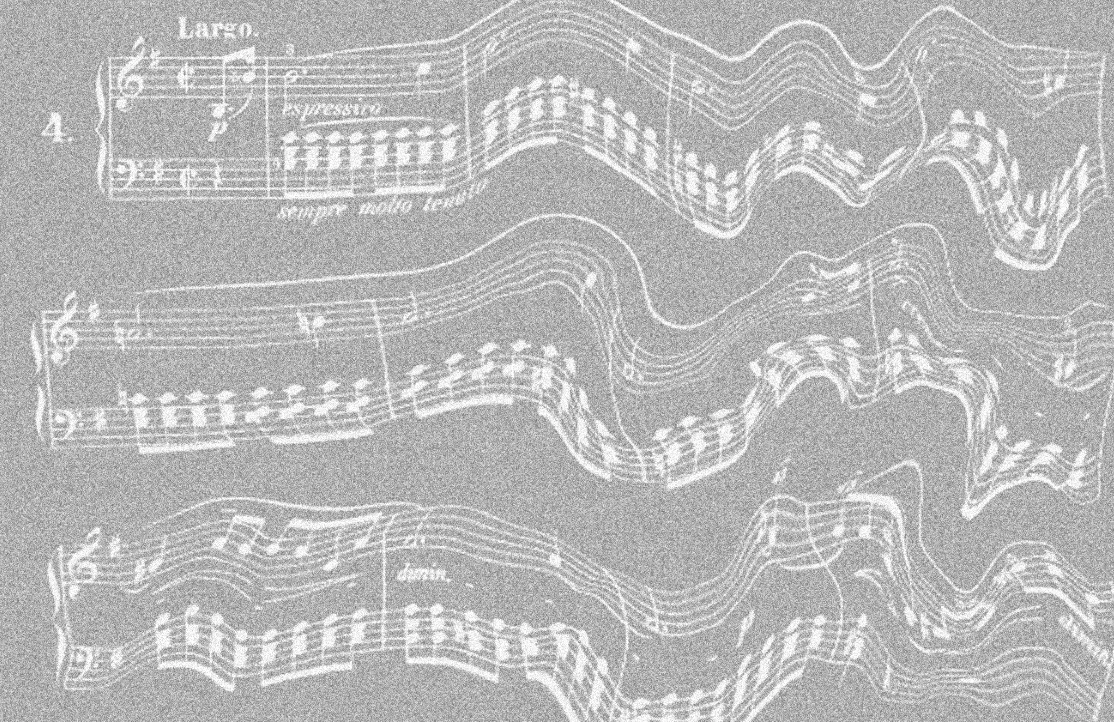
Fragments
︎ D
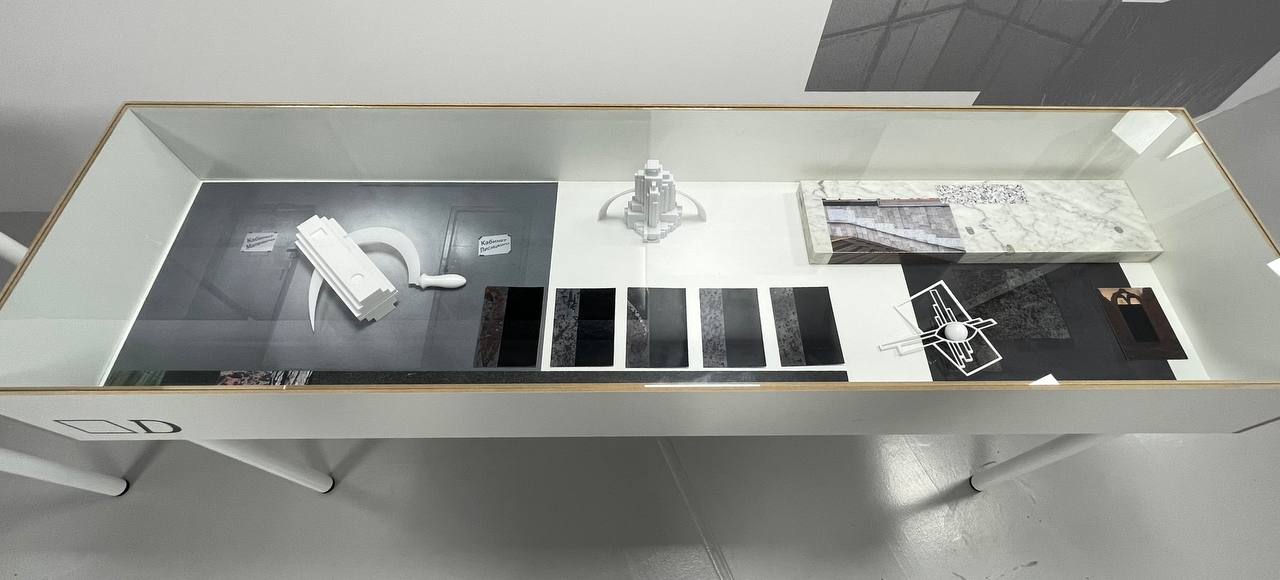
Exhibits:
Object Architecton Pierced by a Colorless Rainbow
The architectural model, reminiscent of the architectons of Kazimir Malevich, is pierced by a “colorless rainbow”, similar to the Arch of Friendship of Peoples in Kyiv.

2023
3D printing:
modeling and idea: Sergey Shabohin
modeling and printing: Roman Shabohin
3D printing:
modeling and idea: Sergey Shabohin
modeling and printing: Roman Shabohin
Object Malevich's Coffin Pierced by a Sickle
A model of a sickle passes through the model of the coffin in which Kazimir Malevich was buried.

2023
3D printing:
modeling and idea: Sergey Shabohin
modeling and printing: Roman Shabohin
3D printing:
modeling and idea: Sergey Shabohin
modeling and printing: Roman Shabohin
Object Suprematist Eye
Inside one of the textbook Suprematist compositions there is a ball in a mandorla, reminiscent of the symbol of the all-seeing eye.

2023
3D printing:
modeling and idea: Sergey Shabohin
modeling and printing: Roman Shabohin
3D printing:
modeling and idea: Sergey Shabohin
modeling and printing: Roman Shabohin
Series of collages Plate Tectonics (Social Marble): Frrr
Bats are featured in a series of collages created during the pandemic.
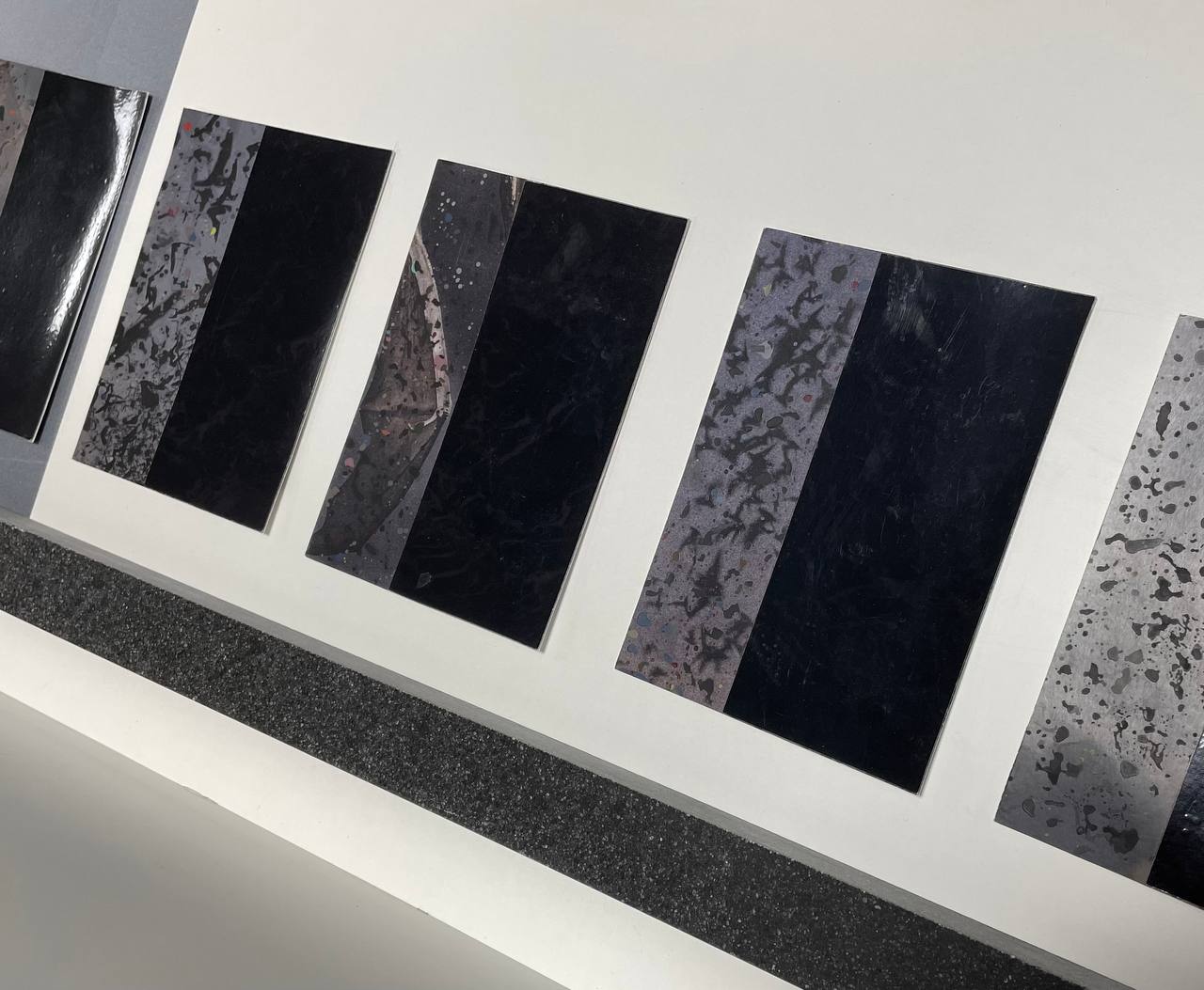
Fragment of a series of 12 collages.
Full title: Plate Tectonics (Social Marble): Frrr / A Foli With Black Marble Texture Pasted on a Paint-Splattered Images With Bats
2022
Full title: Plate Tectonics (Social Marble): Frrr / A Foli With Black Marble Texture Pasted on a Paint-Splattered Images With Bats
2022
Collage Plate Tectonics (Social Marble): Caspar David Friedrich Studios
The landscape postcard by Caspar David Friedrich has a black marble foil pasted in the center.
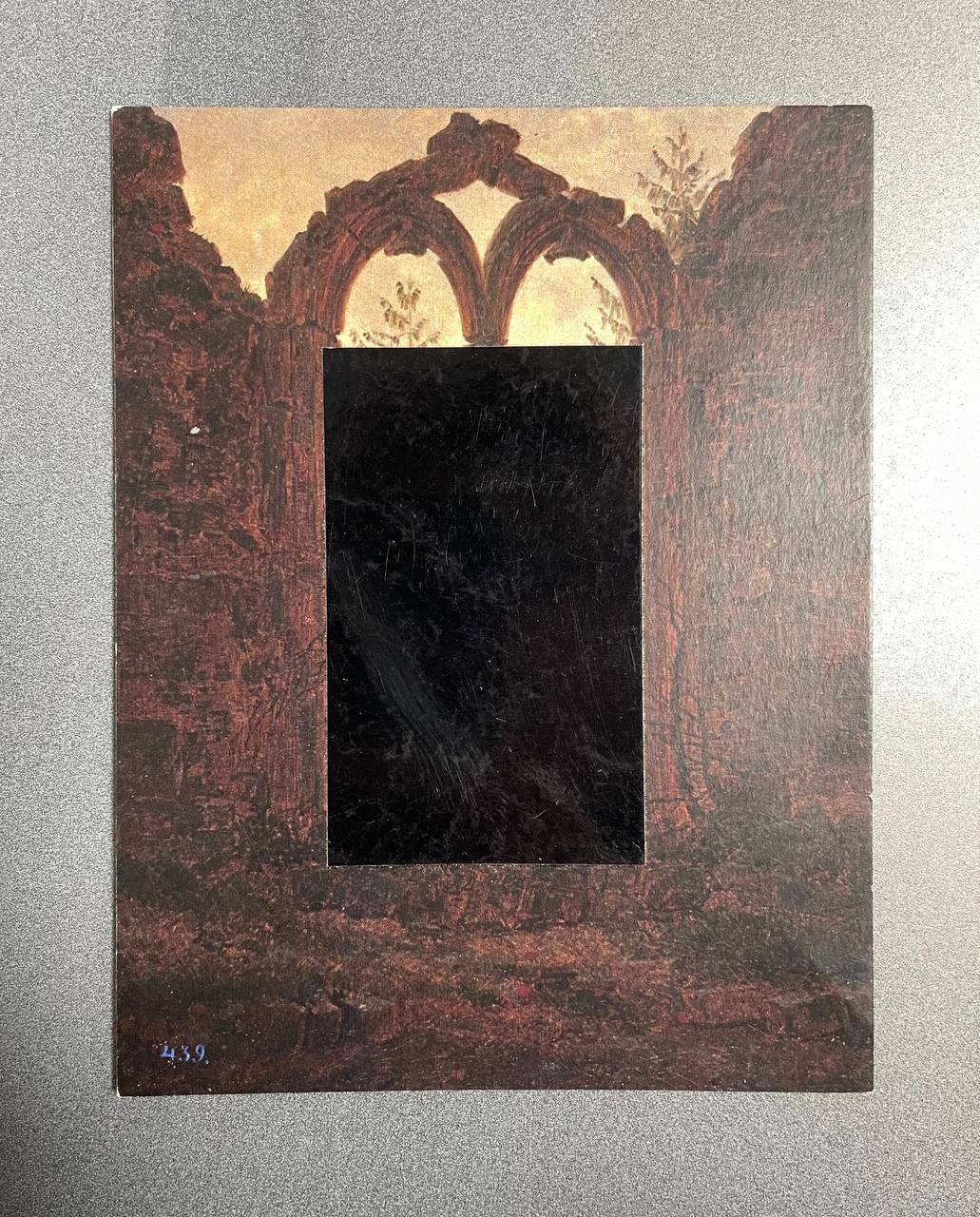
Fragment of a series of 16 collages.
Full title: Plate Tectonics (Social Marble): Caspar David Friedrich Studios / A Foil With Black Marble Texture Pasted on the Center Line of the Postcard Depicting a Landscape by Caspar David Friedrich 2022
Full title: Plate Tectonics (Social Marble): Caspar David Friedrich Studios / A Foil With Black Marble Texture Pasted on the Center Line of the Postcard Depicting a Landscape by Caspar David Friedrich 2022
Collage Plate Tectonics (Social Marble): Memory Censoring
See Fig.3 ︎︎︎
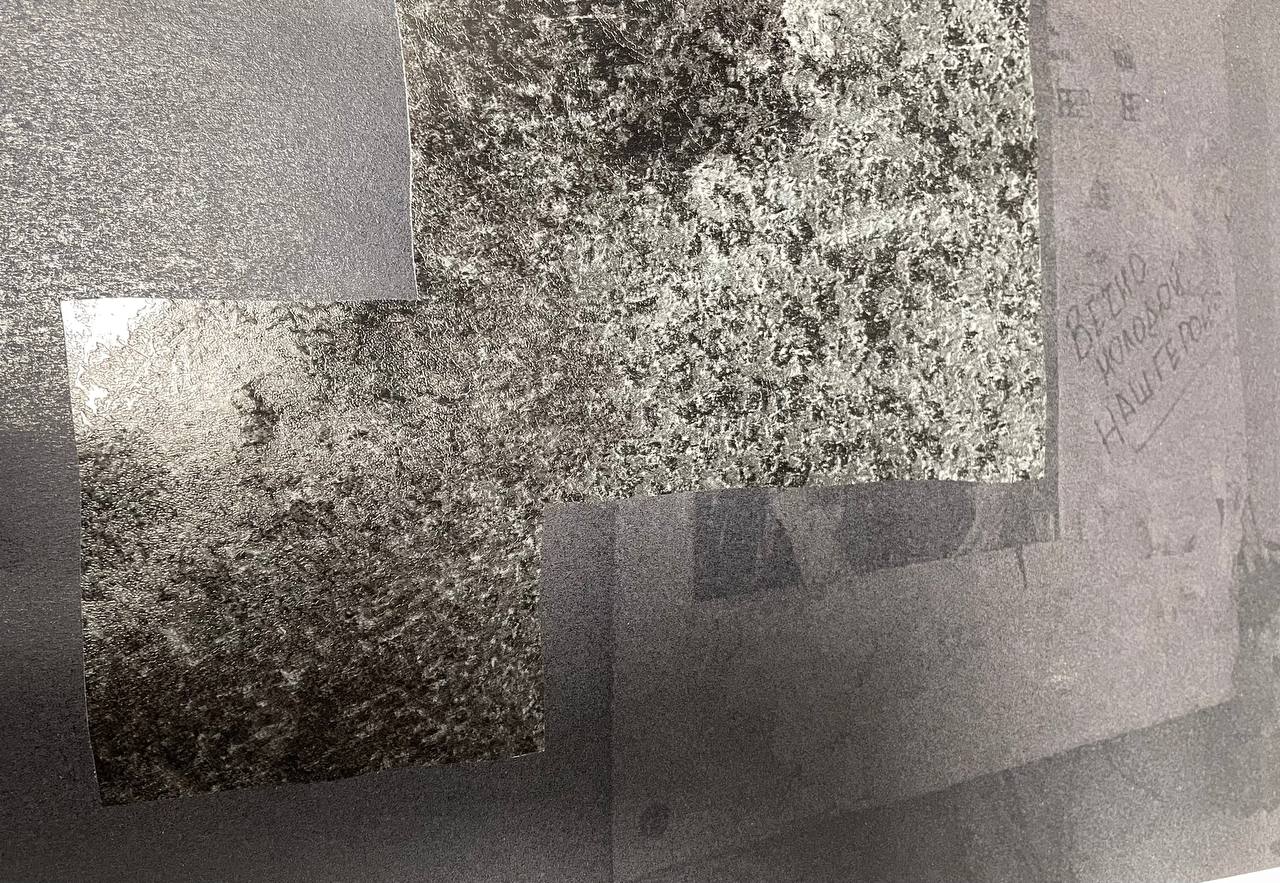
Fragment of a series of 9 collages.
See Fig.3 ︎︎︎
2021
See Fig.3 ︎︎︎
2021
Marble Objects
The showcase contains slabs of marble and granite, on which images with a marble texture and a photograph from Minsk (2016) are pasted.
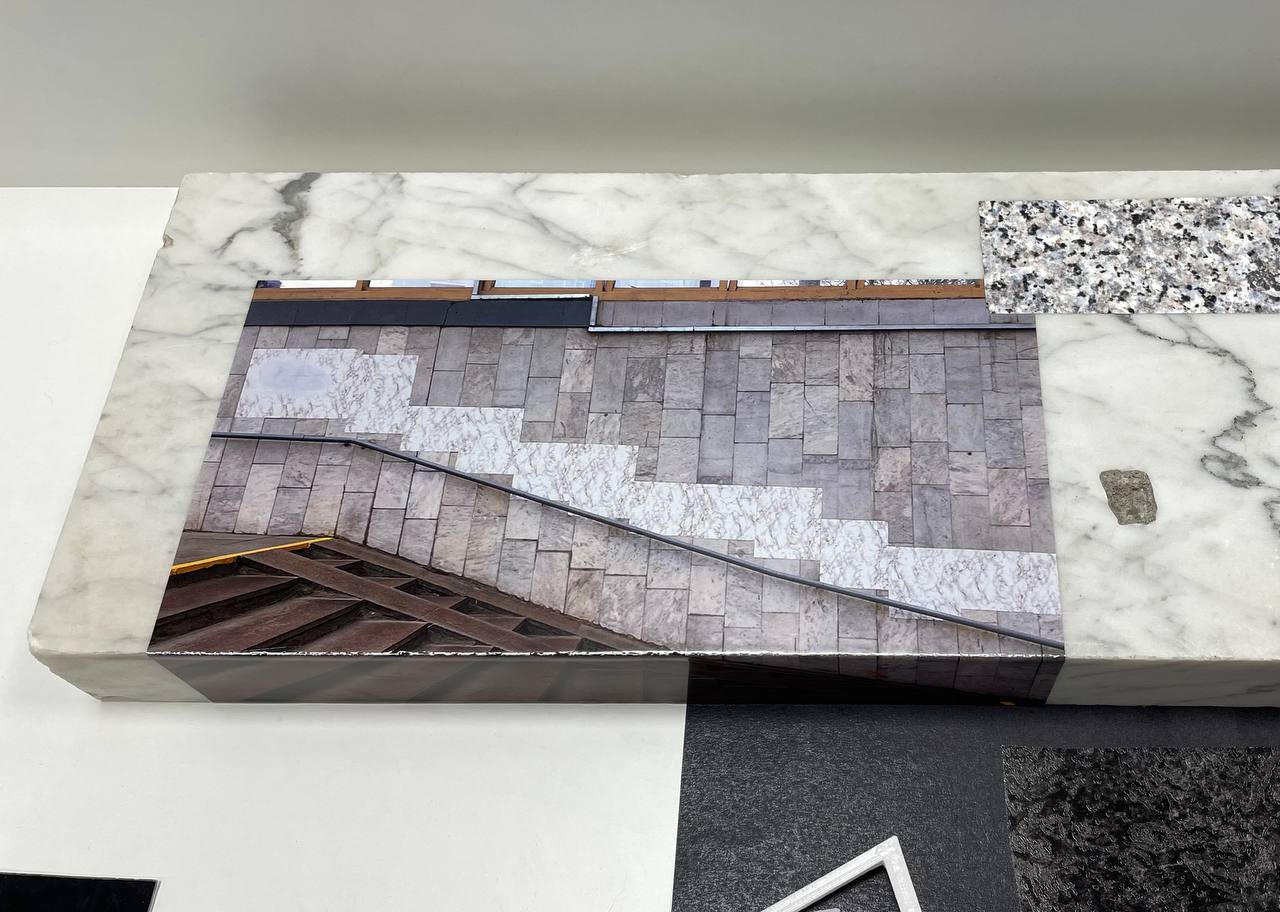
2023
Mural
Photo-reconstruction of doors with signatures seen in 2012 in the emergency building of the Vitebsk Folk Art School before its renovation began.
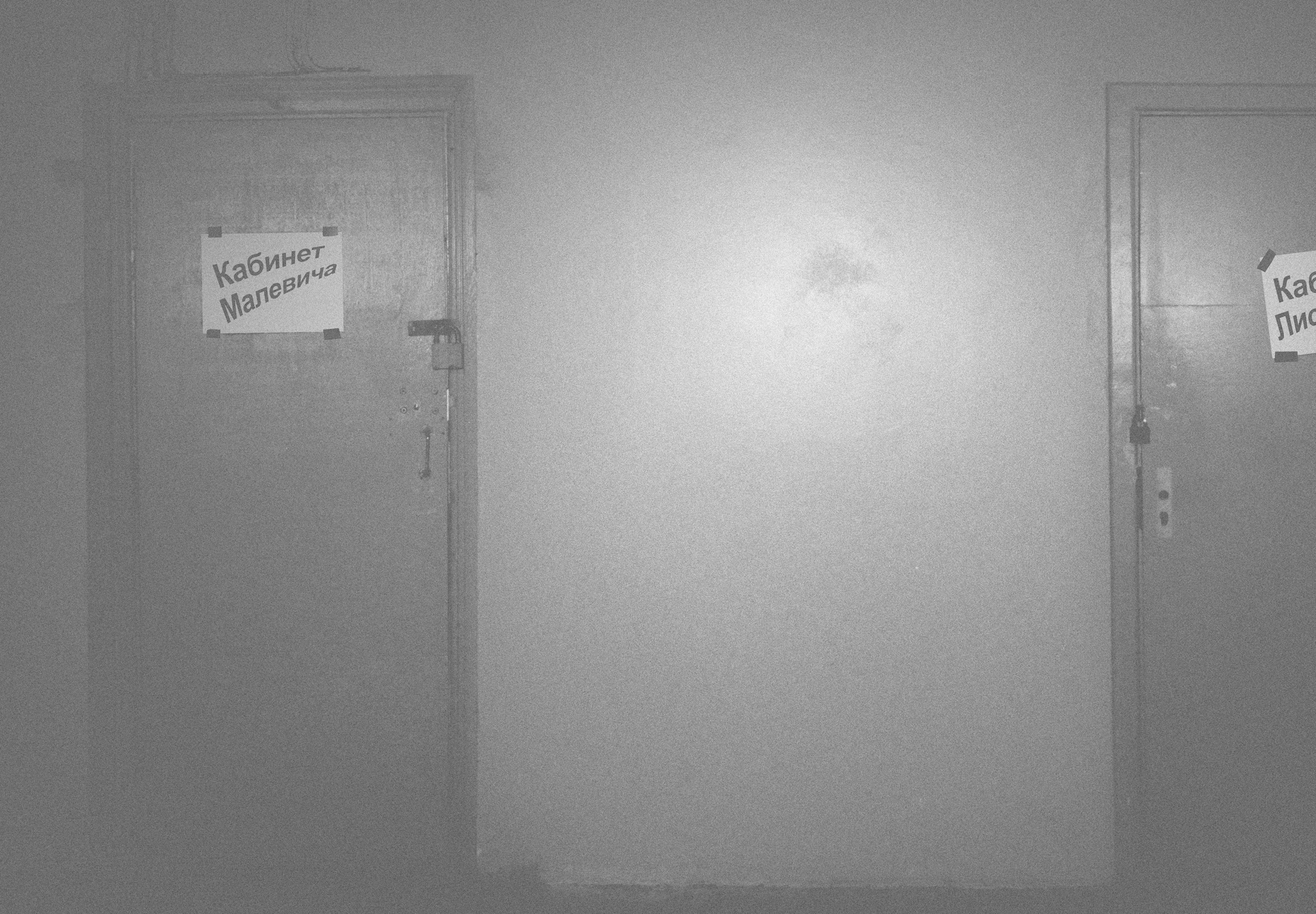
Fragment
2012
2012
︎ E
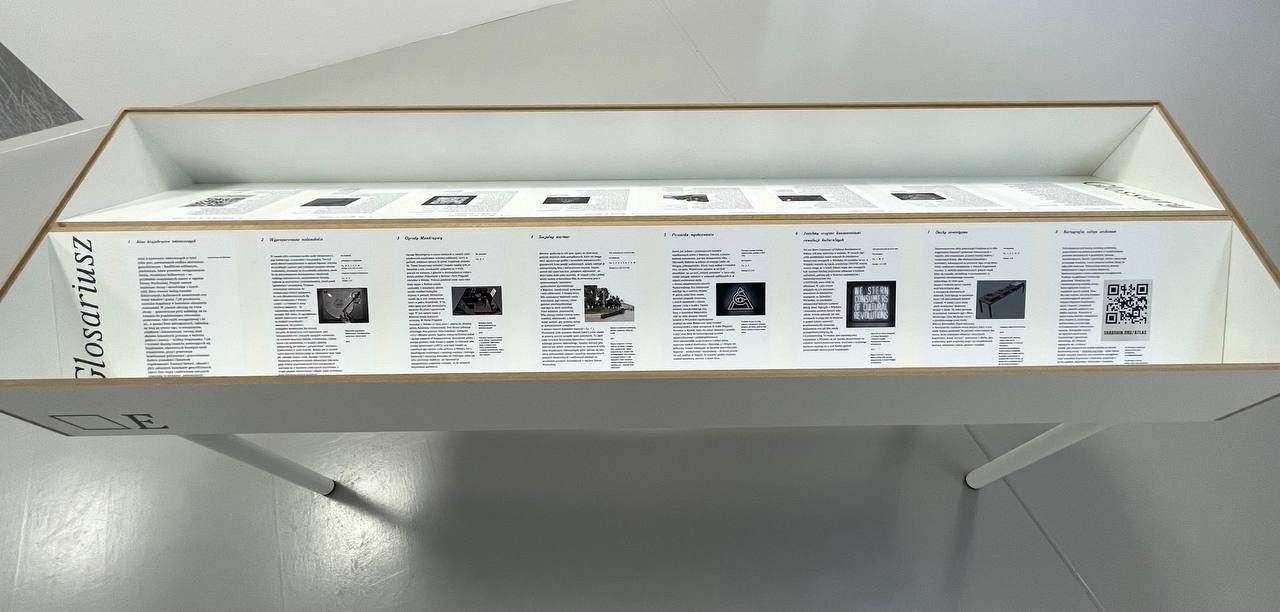
Glossary.
︎︎︎ See above for glossary content.
Walls:
W.1
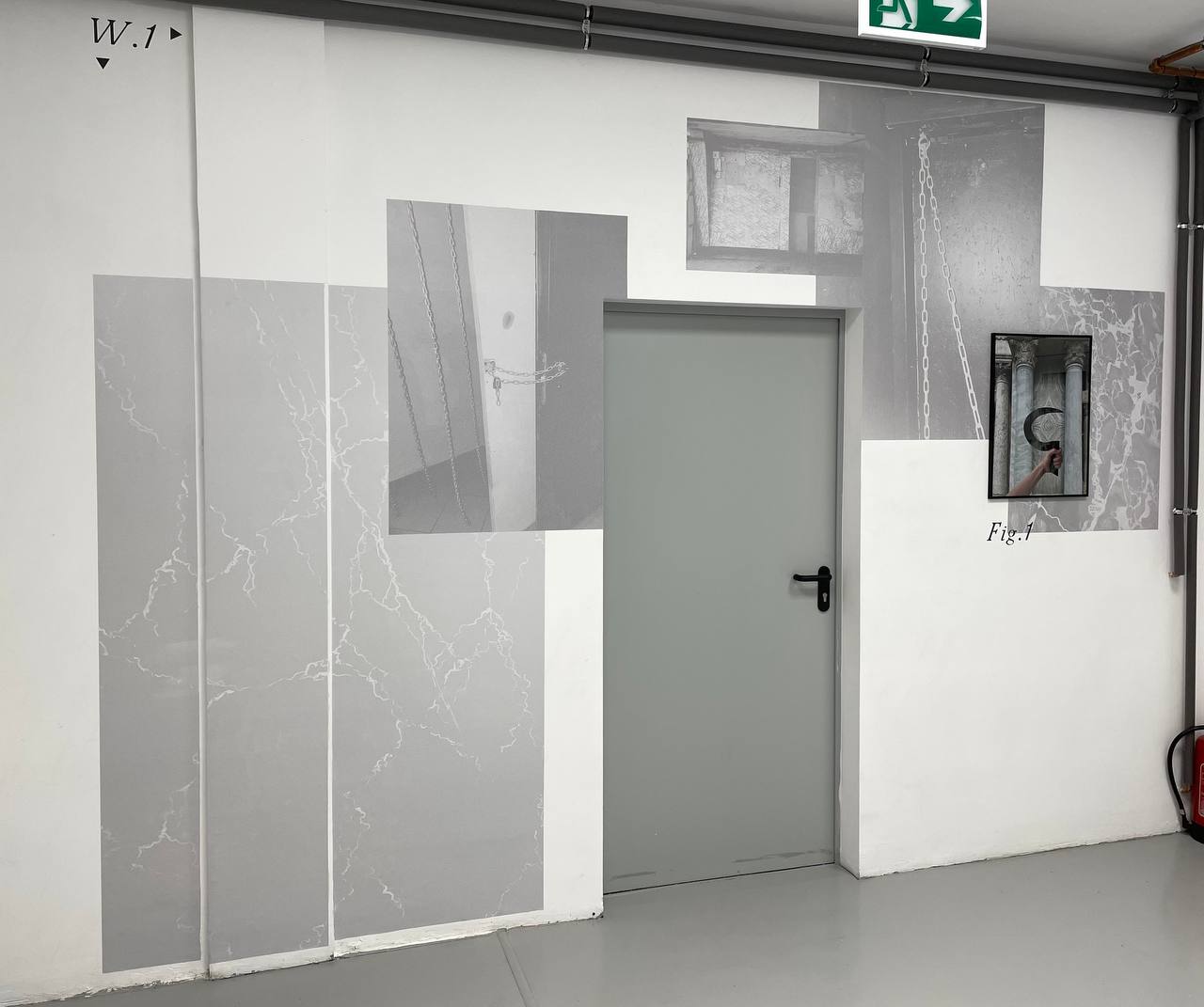
Painted marble, Cathedral Basilica of Our Lady of Perpetual Help, St. Mary Magdalene and St. Stanislaus the Bishop in Poznań, 2022.
Dark room detail, Pokusa bar, Poznań, 2022.
Underpass in Warsaw, 2022.
Chains in the dark room, Dark Angels Club, Poznań, 2022.
Marble wall, Pantheon in Rome, 2022.
Dark room detail, Pokusa bar, Poznań, 2022.
Underpass in Warsaw, 2022.
Chains in the dark room, Dark Angels Club, Poznań, 2022.
Marble wall, Pantheon in Rome, 2022.
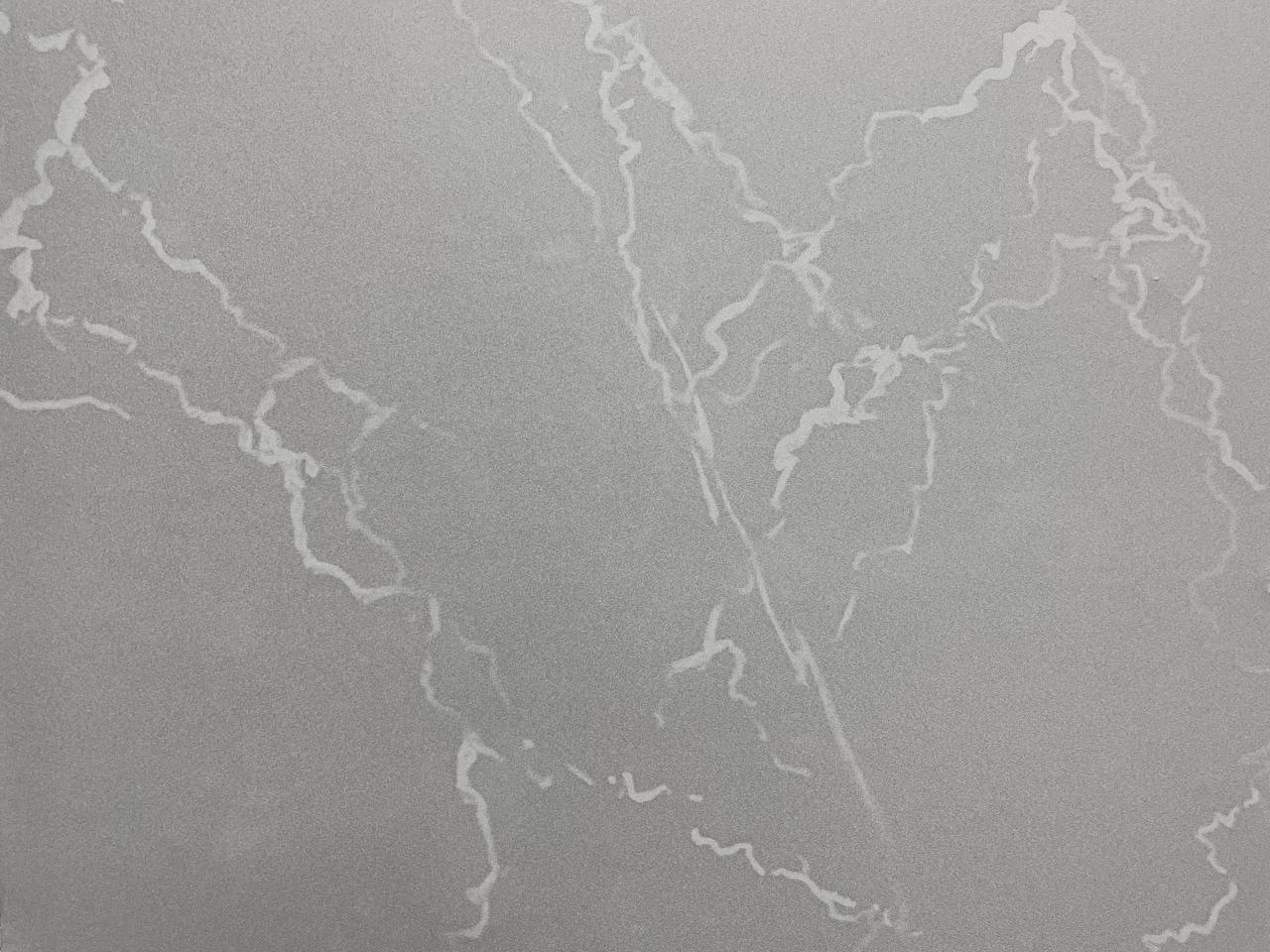
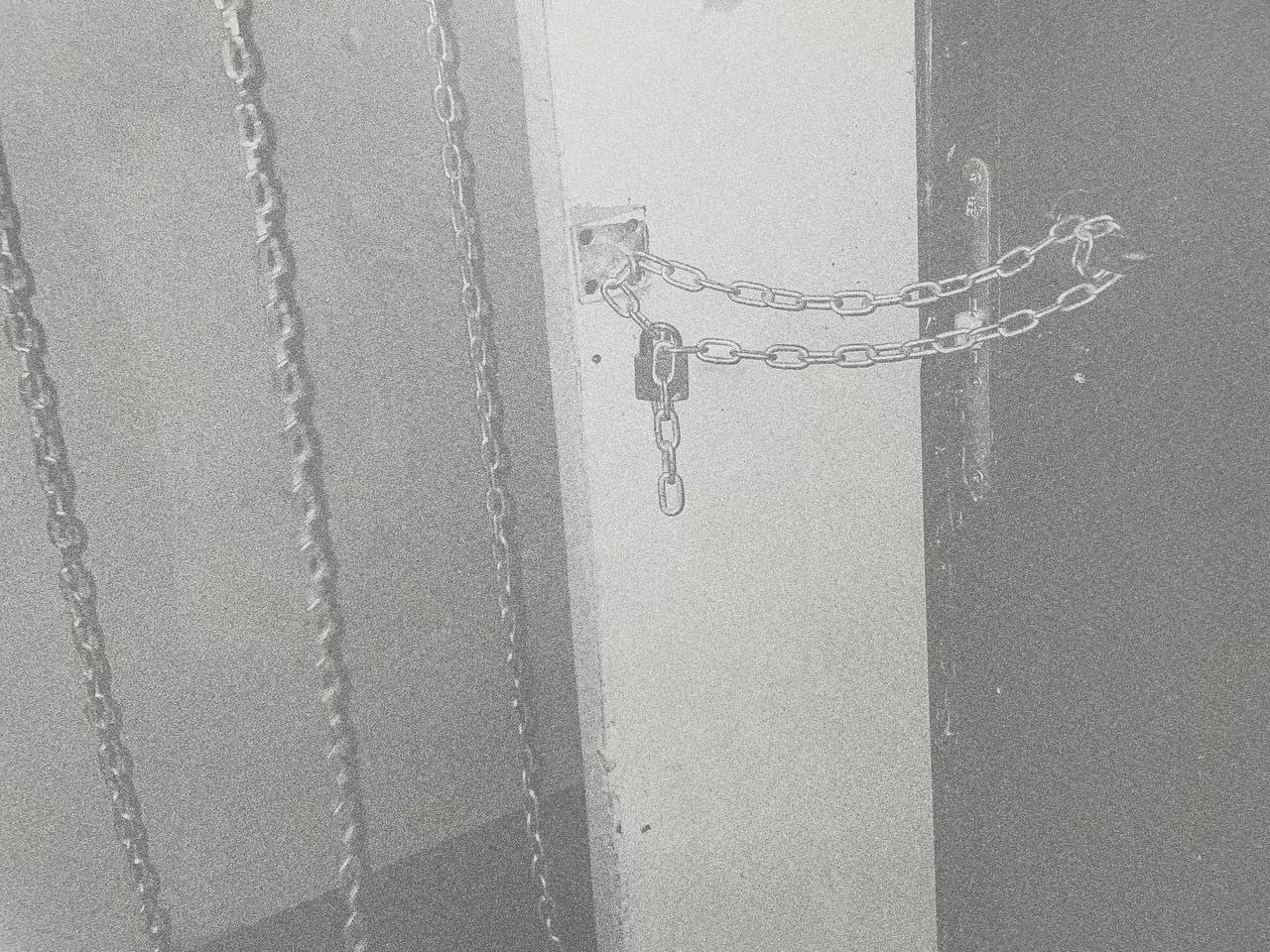
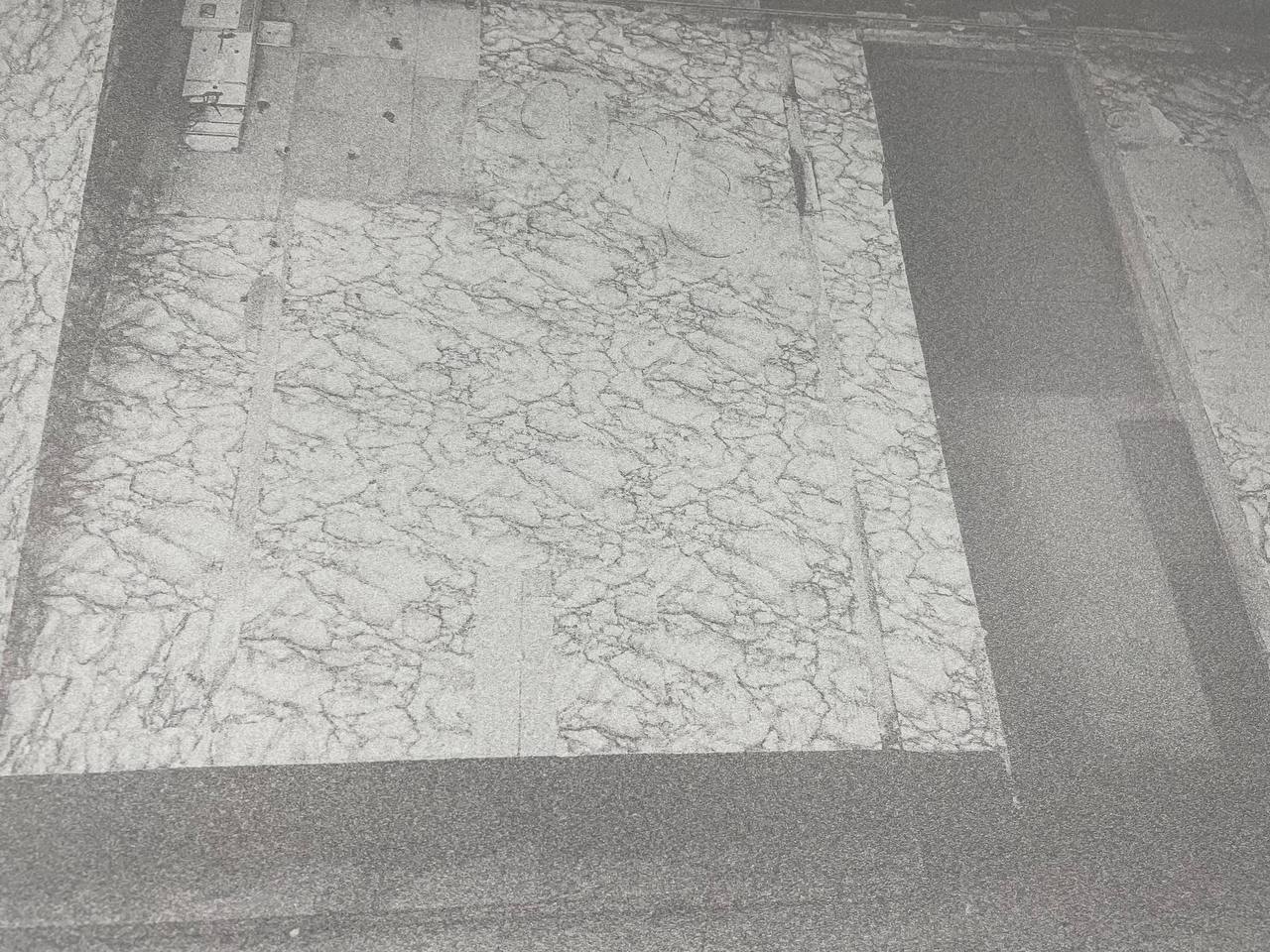
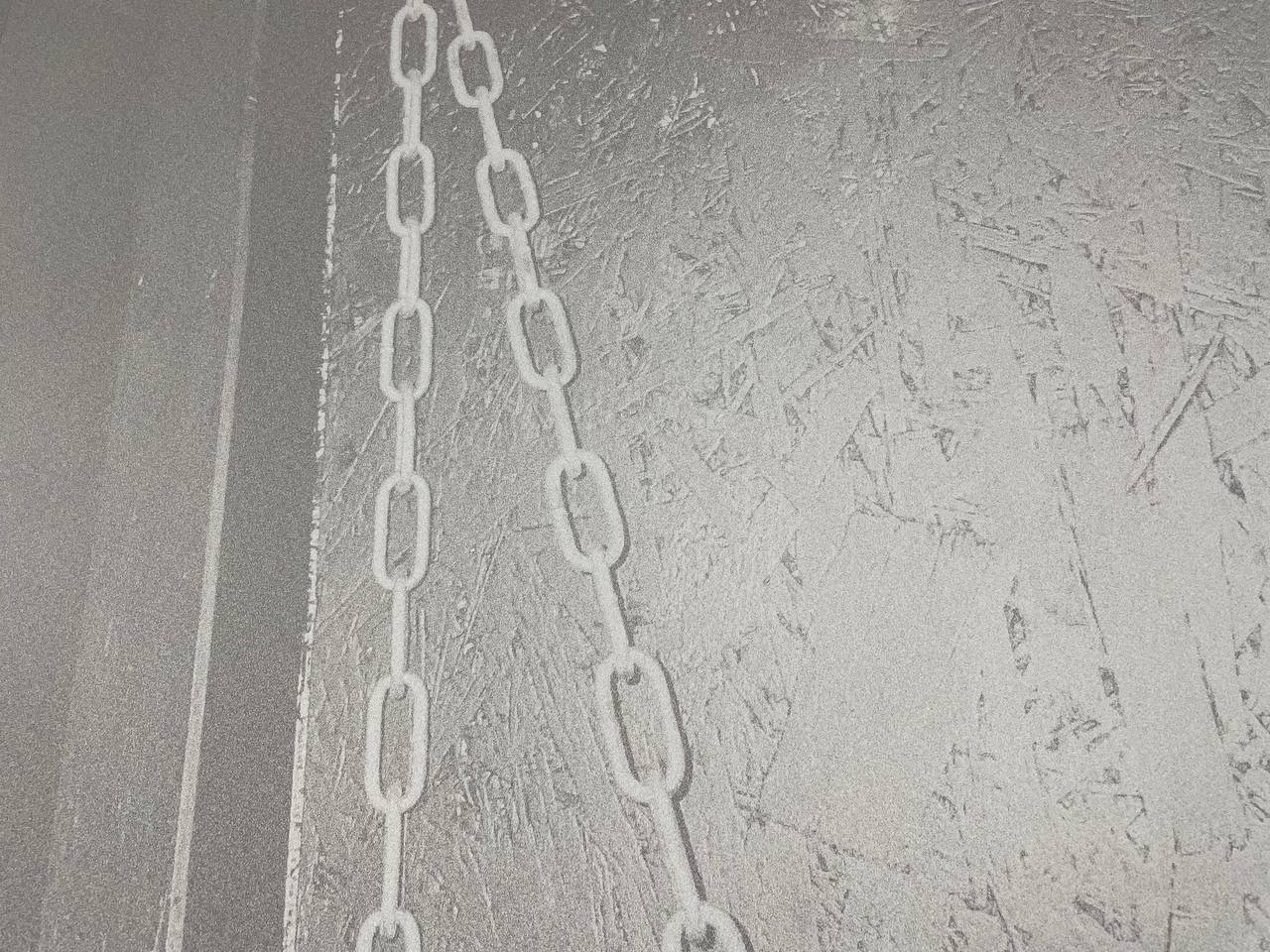

Fragments
W.2
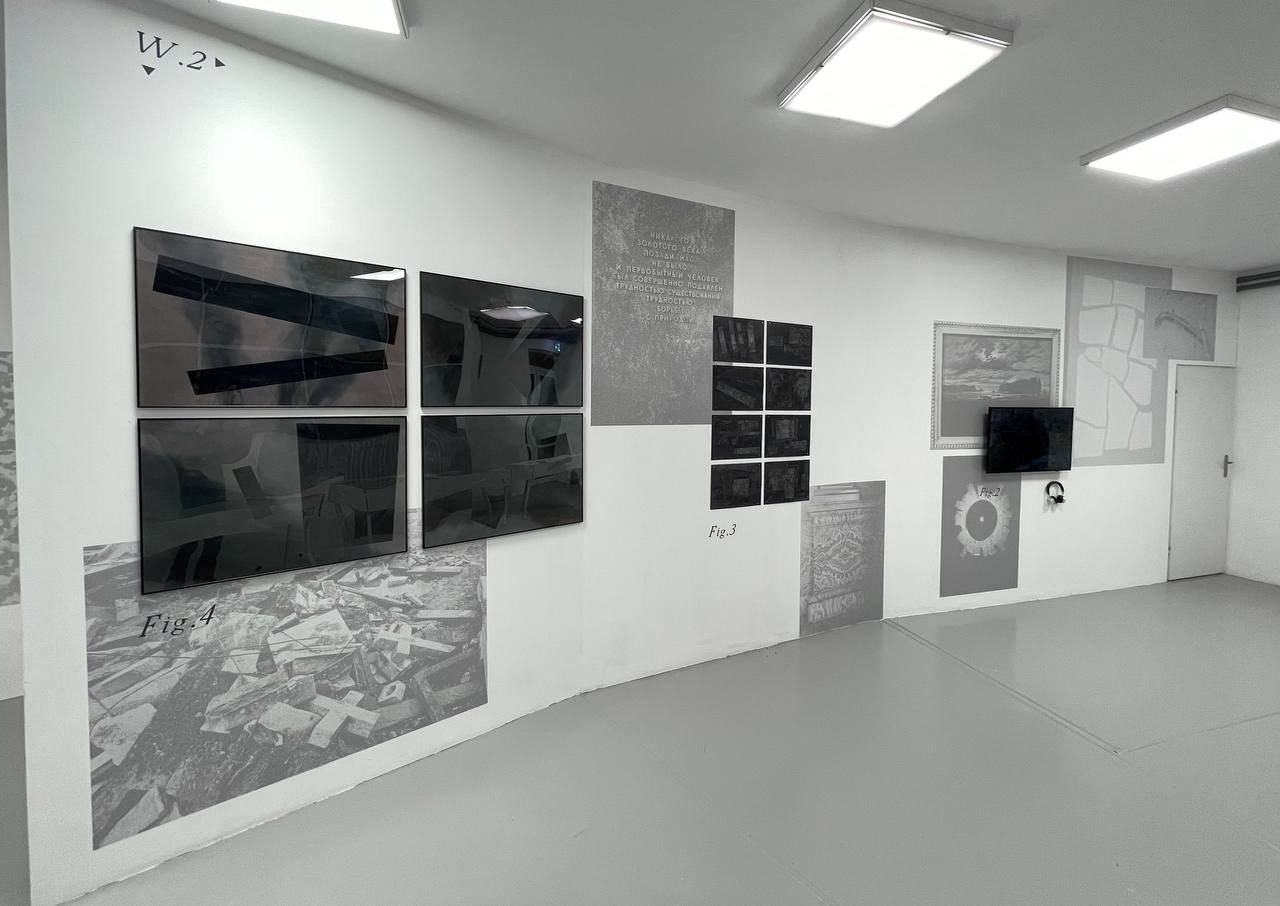
Second Death, Yunikovo City Cemetery, 2023.
Fragment of the exposition, National Historical Museum. DI. Yavornitsky in Dnipro, 2019. Translation of the inscription: There was no golden age behind us, and primitive man was completely overwhelmed by the difficulties of existence, the difficulties of struggling with nature.
Wall with painted marble, Palazzo Altemps, Rome, 2022.
Photographs of Caspar-David Friedrich's painting North Sea at Full Moon (1823-1824), National Gallery of Prague, 2022.
Glory Hole, fragment of the Fear of Castration installation, Minsk, 2016.
Torn leaf, Gray Mandorla Studio, Poznań, 2023.
Ants, Odessa, 2008.
Fragment of the exposition, National Historical Museum. DI. Yavornitsky in Dnipro, 2019. Translation of the inscription: There was no golden age behind us, and primitive man was completely overwhelmed by the difficulties of existence, the difficulties of struggling with nature.
Wall with painted marble, Palazzo Altemps, Rome, 2022.
Photographs of Caspar-David Friedrich's painting North Sea at Full Moon (1823-1824), National Gallery of Prague, 2022.
Glory Hole, fragment of the Fear of Castration installation, Minsk, 2016.
Torn leaf, Gray Mandorla Studio, Poznań, 2023.
Ants, Odessa, 2008.
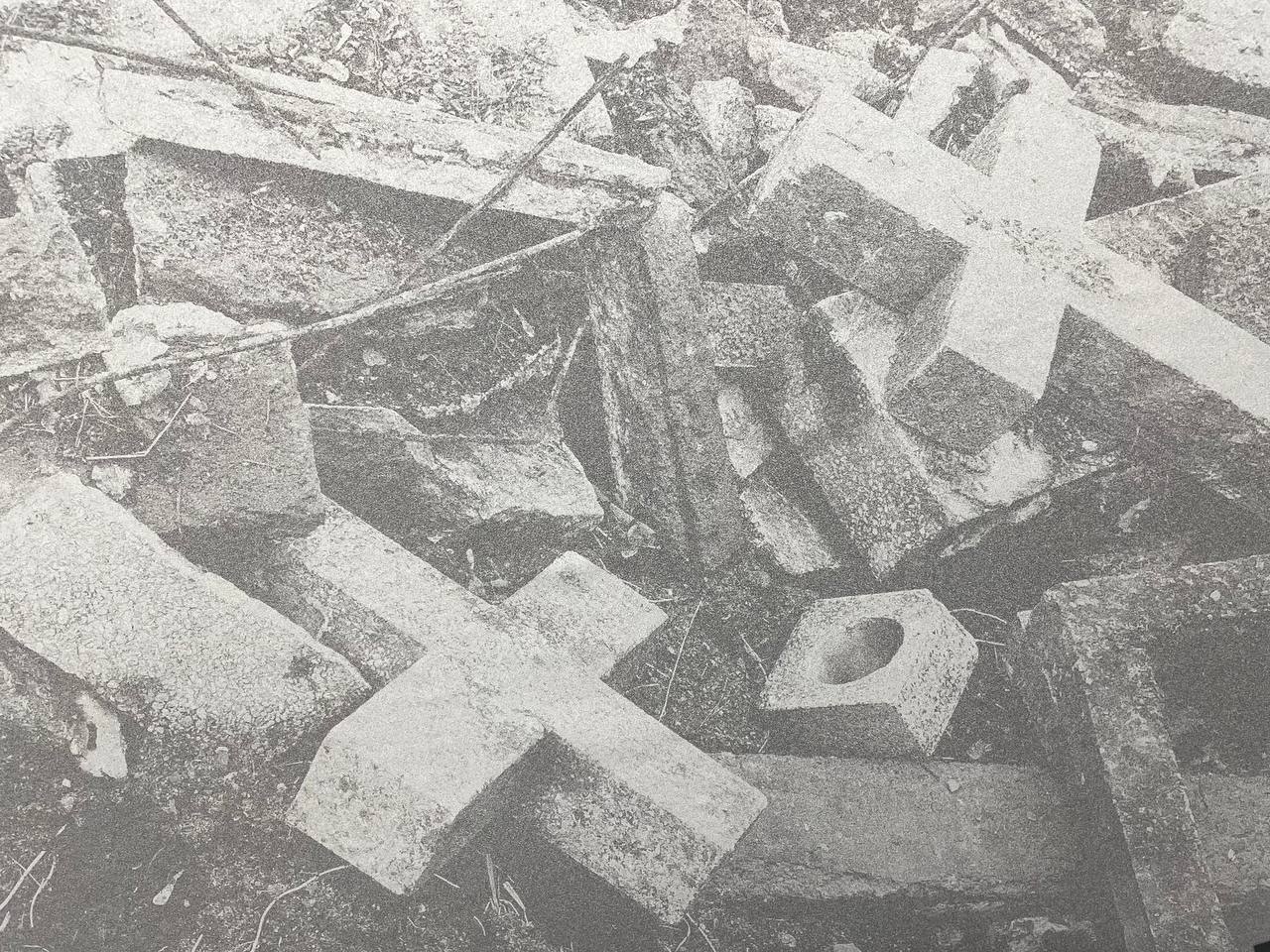
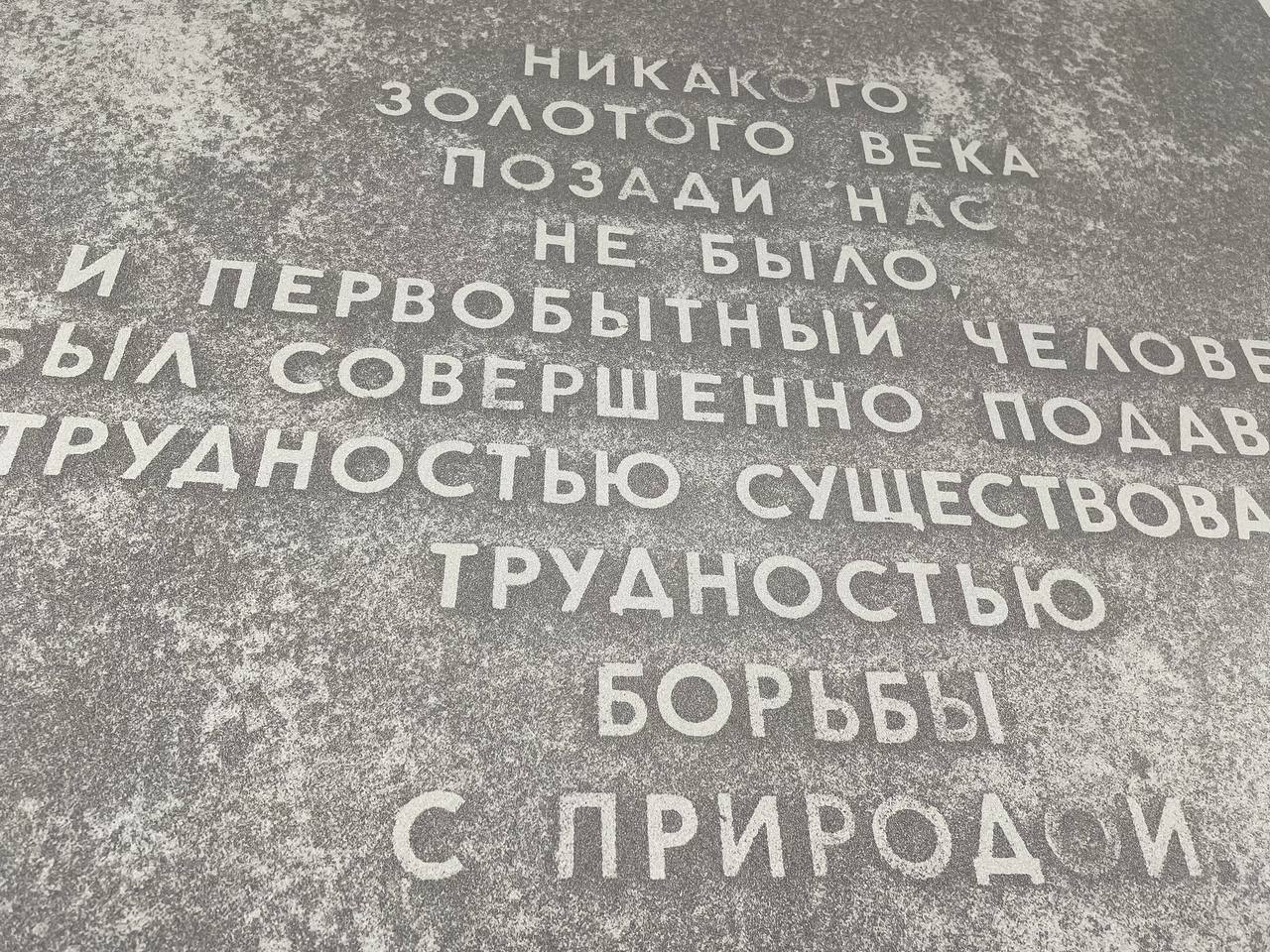
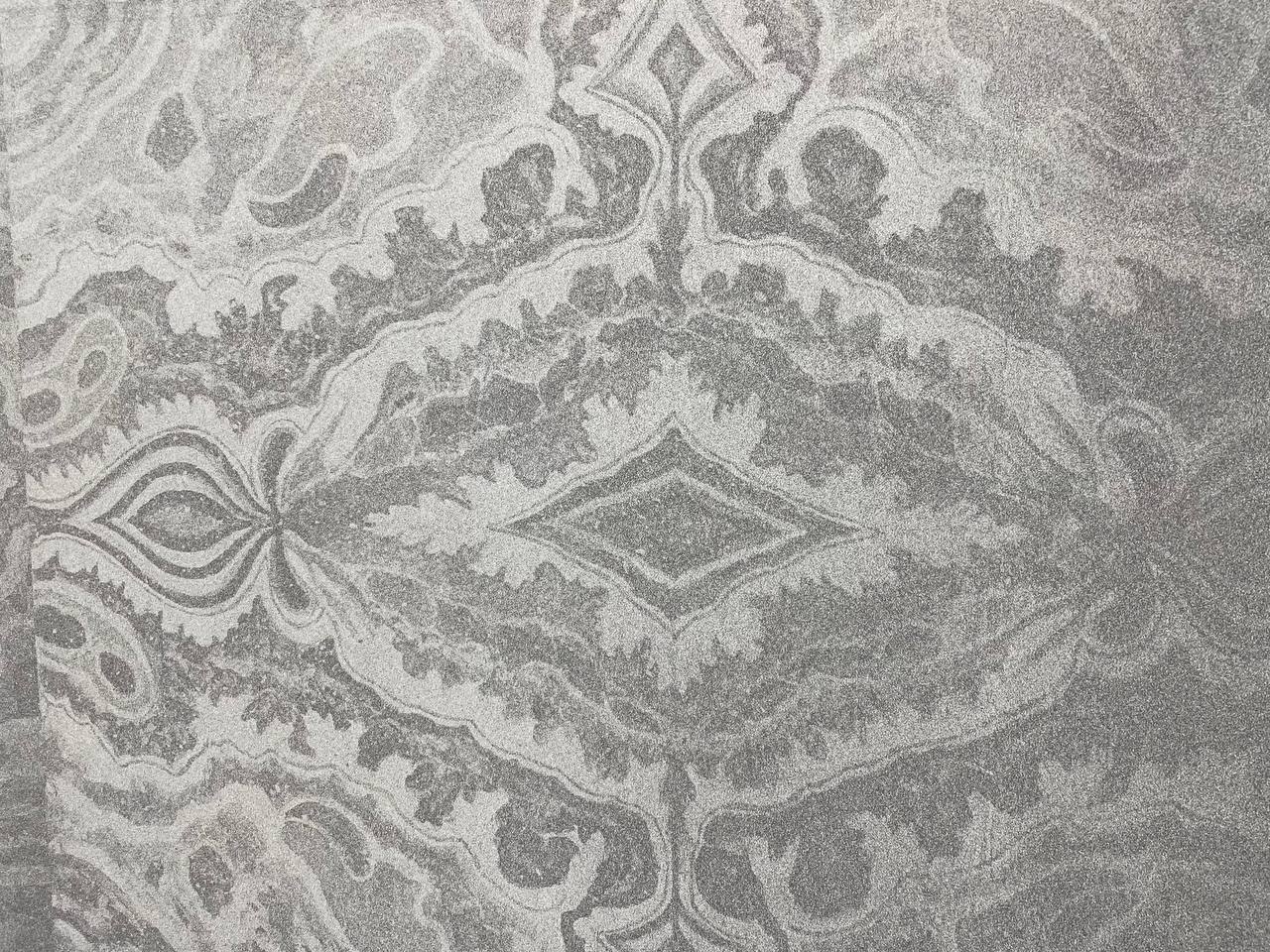
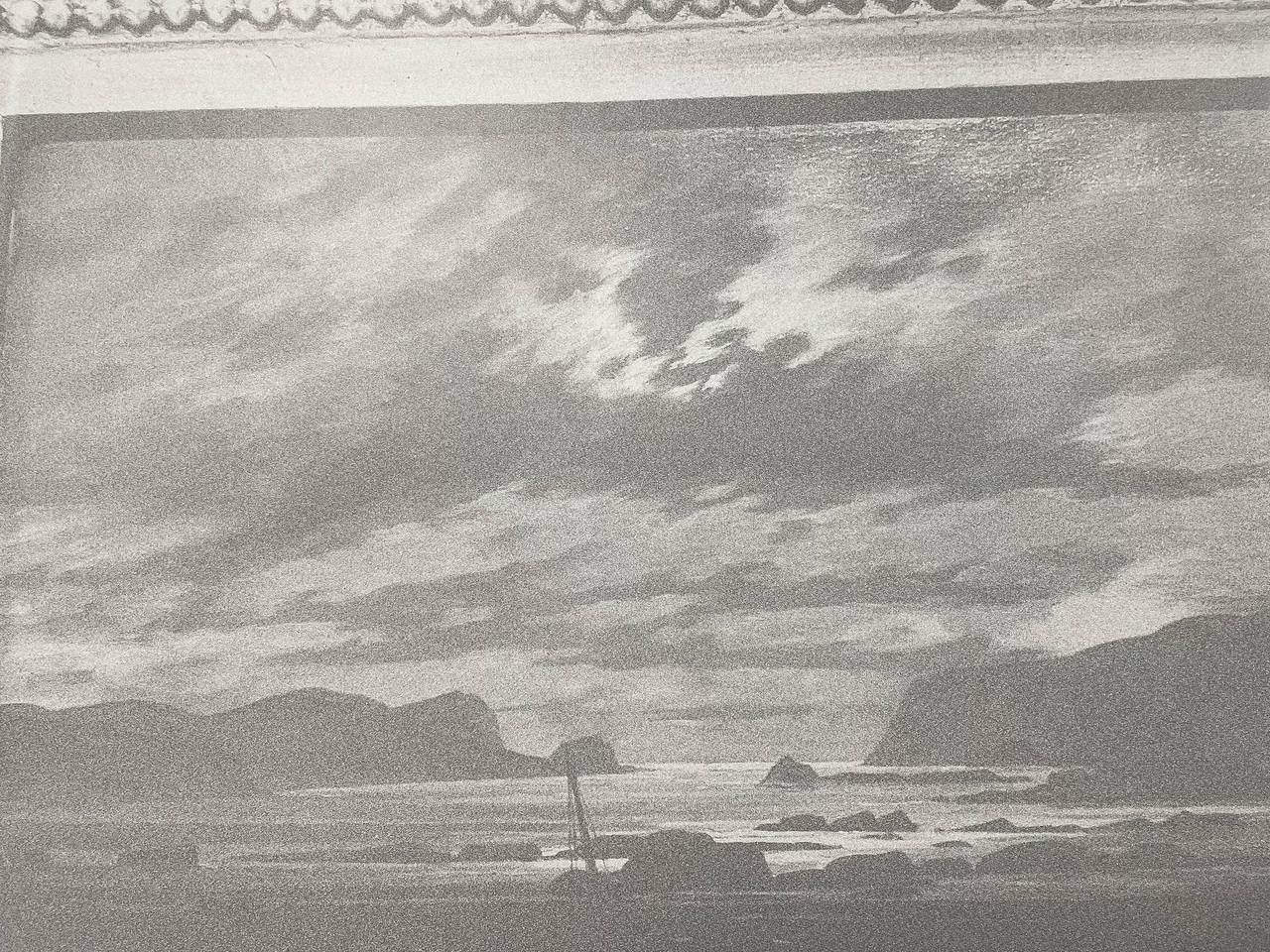
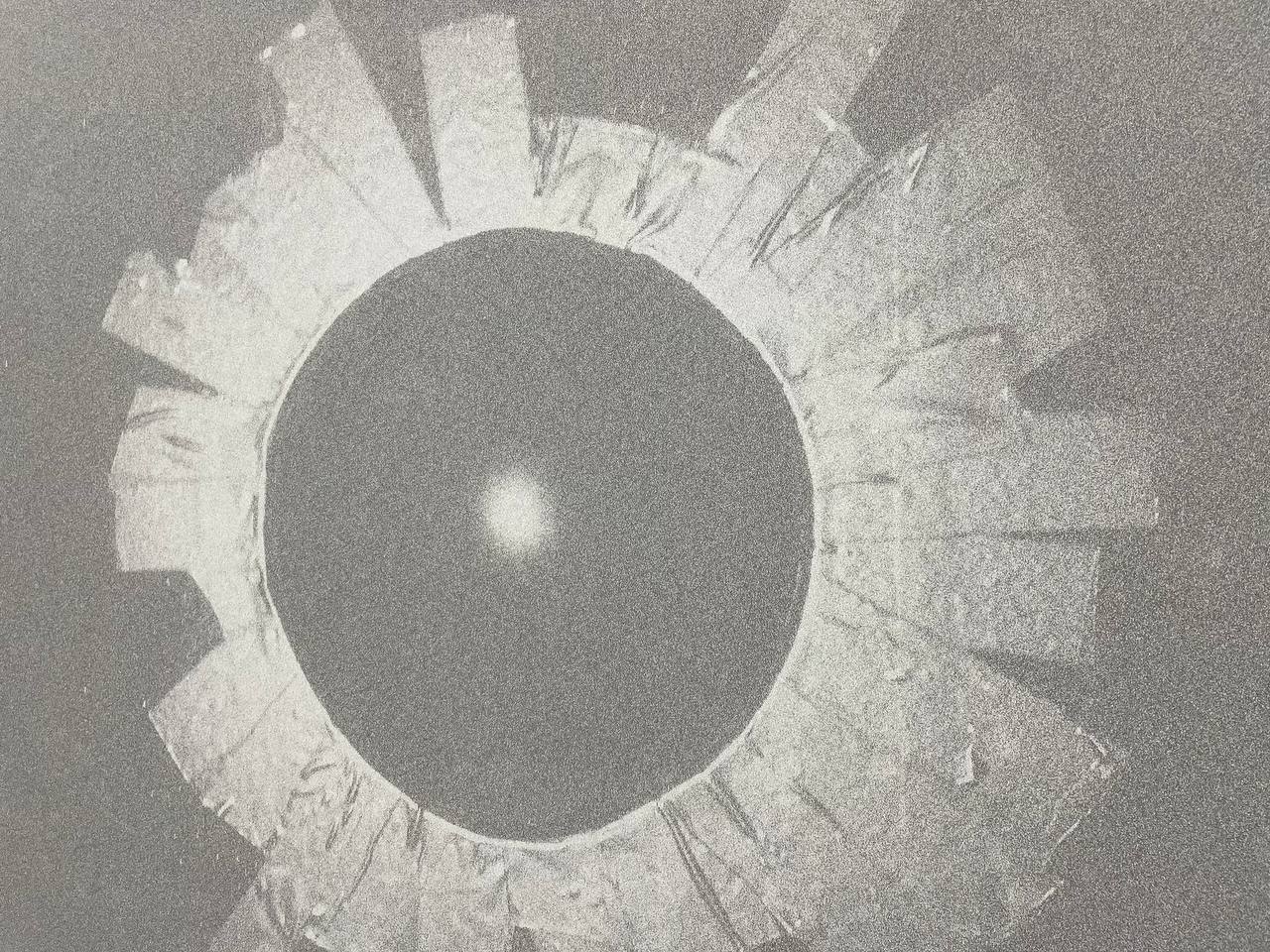

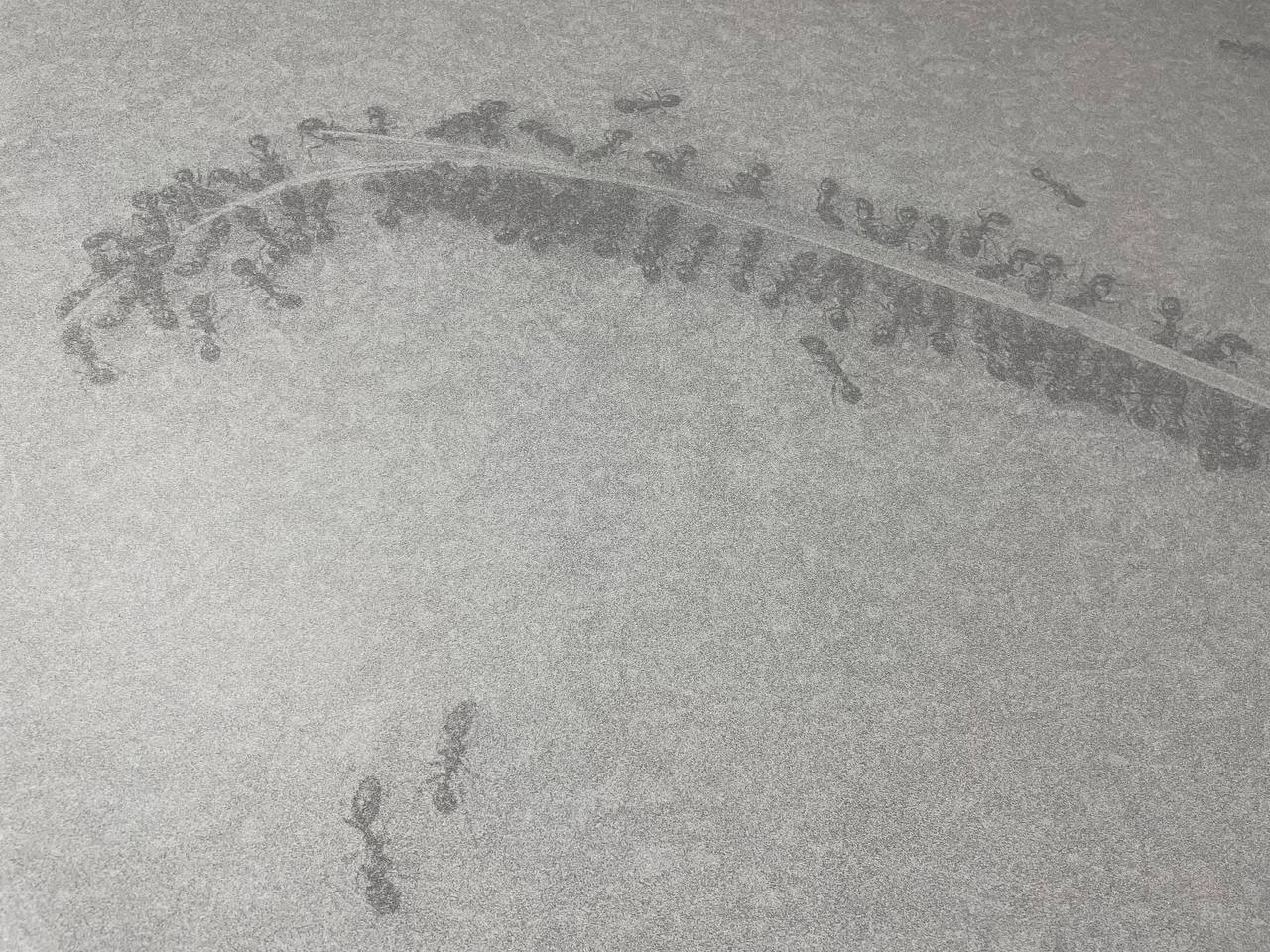
Fragments
W.3

Patterned plate, Castel Sant'Angelo National Museum, Rome, 2022.
Mask, an exhibit at the National Historical Museum. DI. Yavornitsky in Dnipro, 2019.
The texture of the seat upholstery in the Berlin subway, 2022.
Inventory book of museum exhibits, Arsenal Gallery, Bialystok, 2019.
Mask, an exhibit at the National Historical Museum. DI. Yavornitsky in Dnipro, 2019.
The texture of the seat upholstery in the Berlin subway, 2022.
Inventory book of museum exhibits, Arsenal Gallery, Bialystok, 2019.
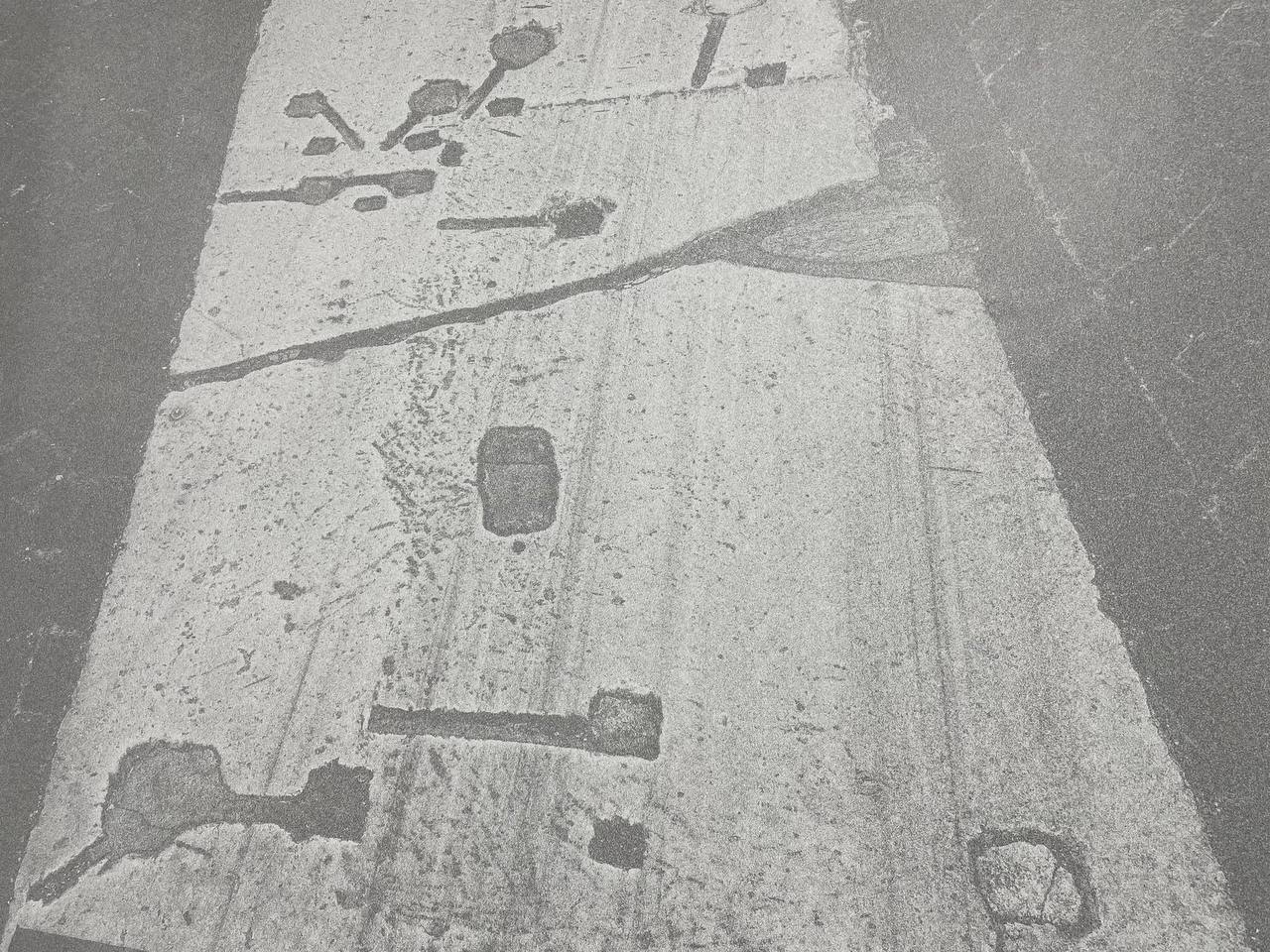
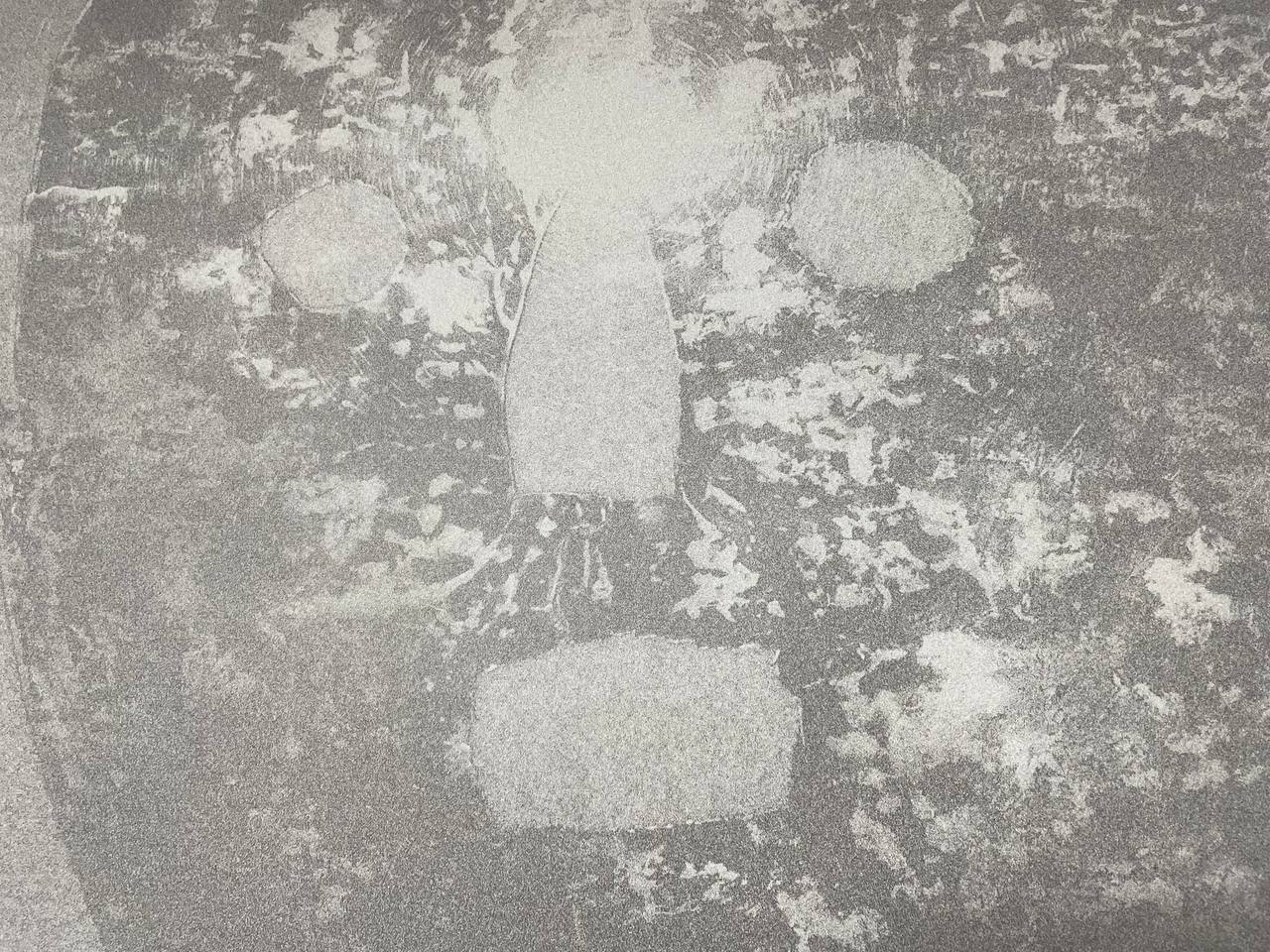
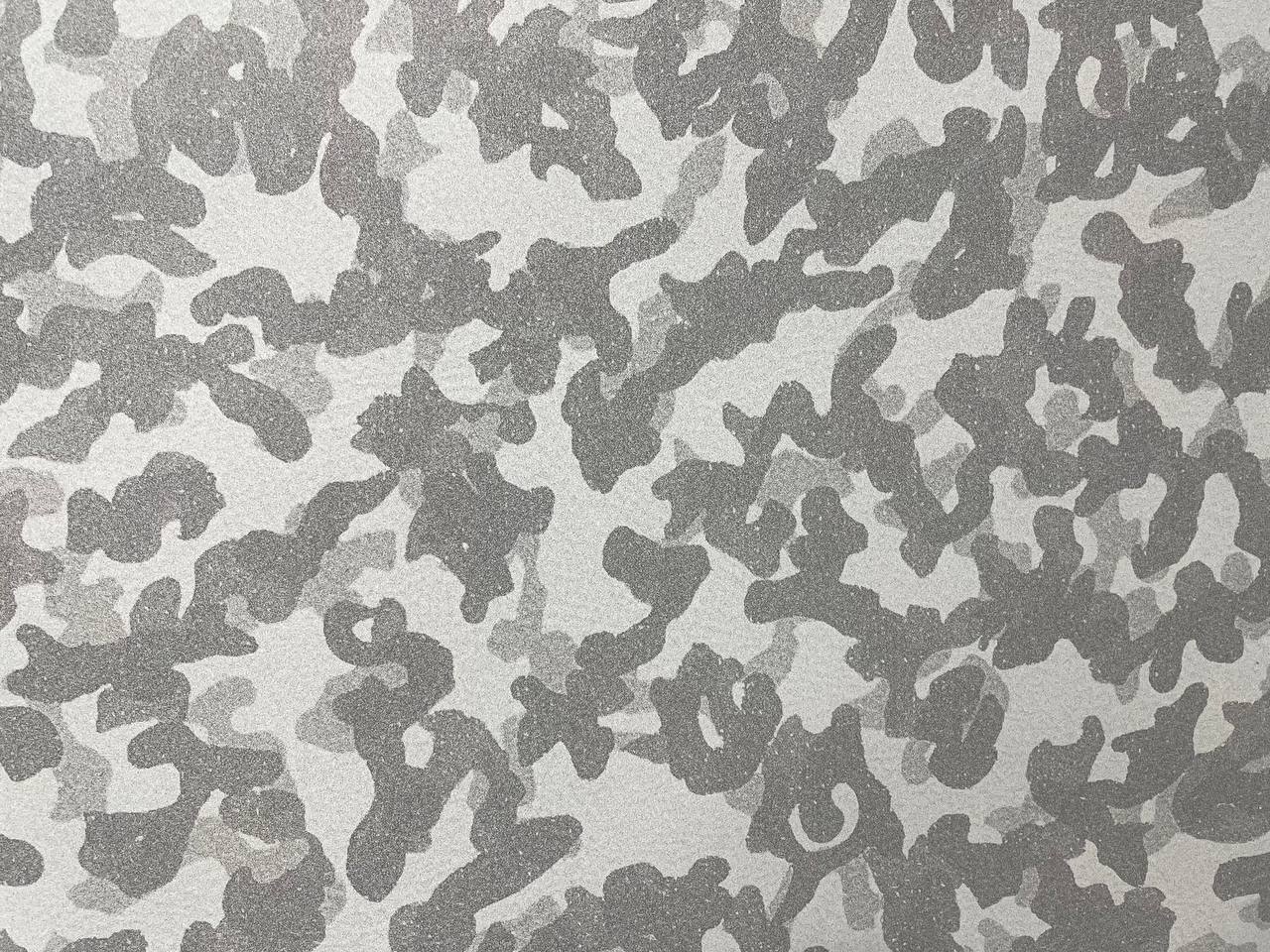
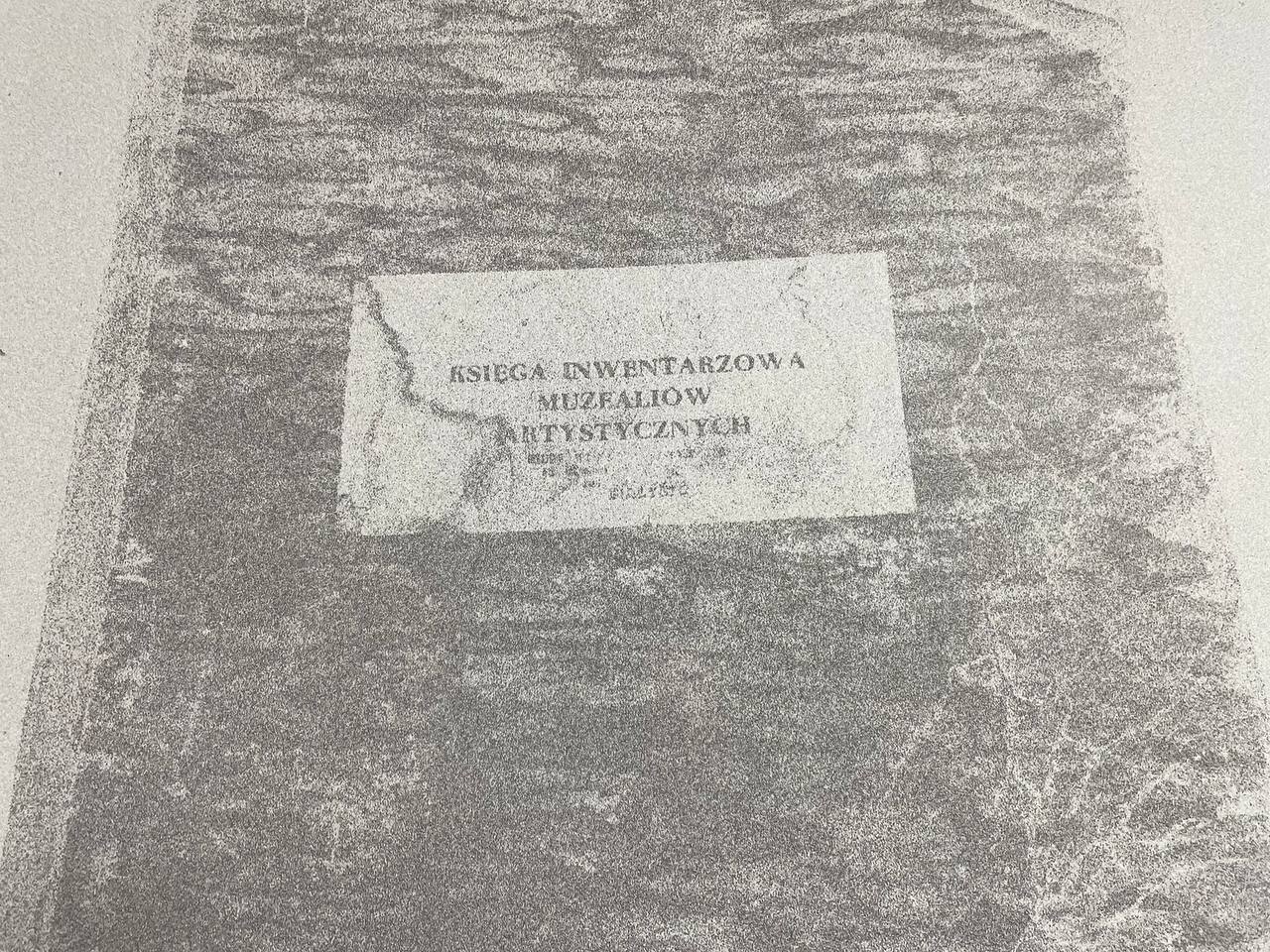
Fragments
W.4

Renovation work in the center of Poznań, 2023.
Plates, Kamieniarstwo Michał Palacz, Poznań, 2023.
Marble wall, Pariserplatz, Berlin, 2022.
Wall, Church of San Silvestro in Capite, Rome, 2022.
“Glory to Ukraine!”, Gray Mandorla Studio, Poznan, 2022.
Eye of a deer, Museum of Natural History in Belovezhskaya Pushcha, 2017.
Arch of Friendship of Peoples, Kyiv, 2019.
Neon sign, Pasaż Różowy, Poznań, 2022.
Plates, Kamieniarstwo Michał Palacz, Poznań, 2023.
Marble wall, Pariserplatz, Berlin, 2022.
Wall, Church of San Silvestro in Capite, Rome, 2022.
“Glory to Ukraine!”, Gray Mandorla Studio, Poznan, 2022.
Eye of a deer, Museum of Natural History in Belovezhskaya Pushcha, 2017.
Arch of Friendship of Peoples, Kyiv, 2019.
Neon sign, Pasaż Różowy, Poznań, 2022.
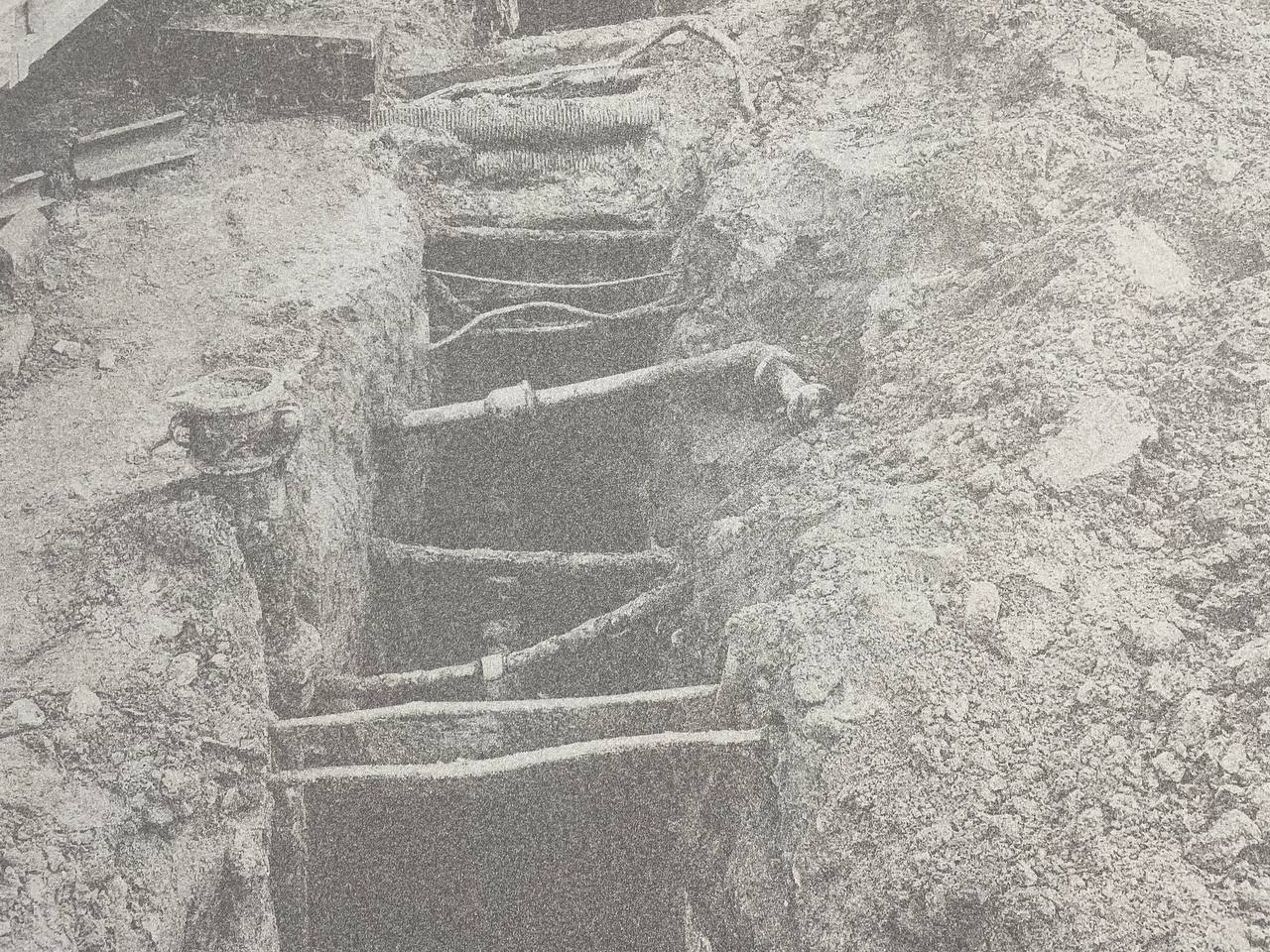
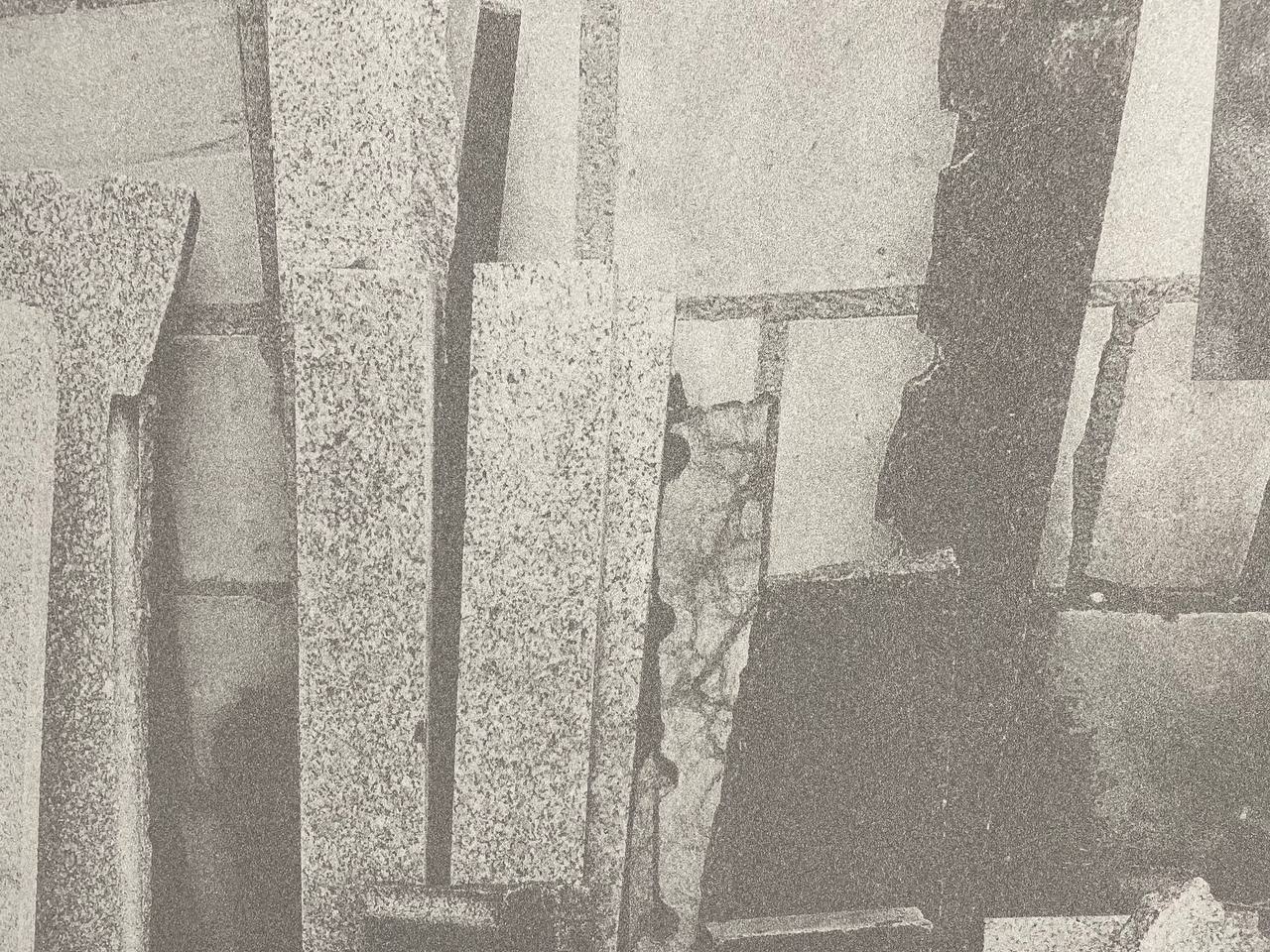



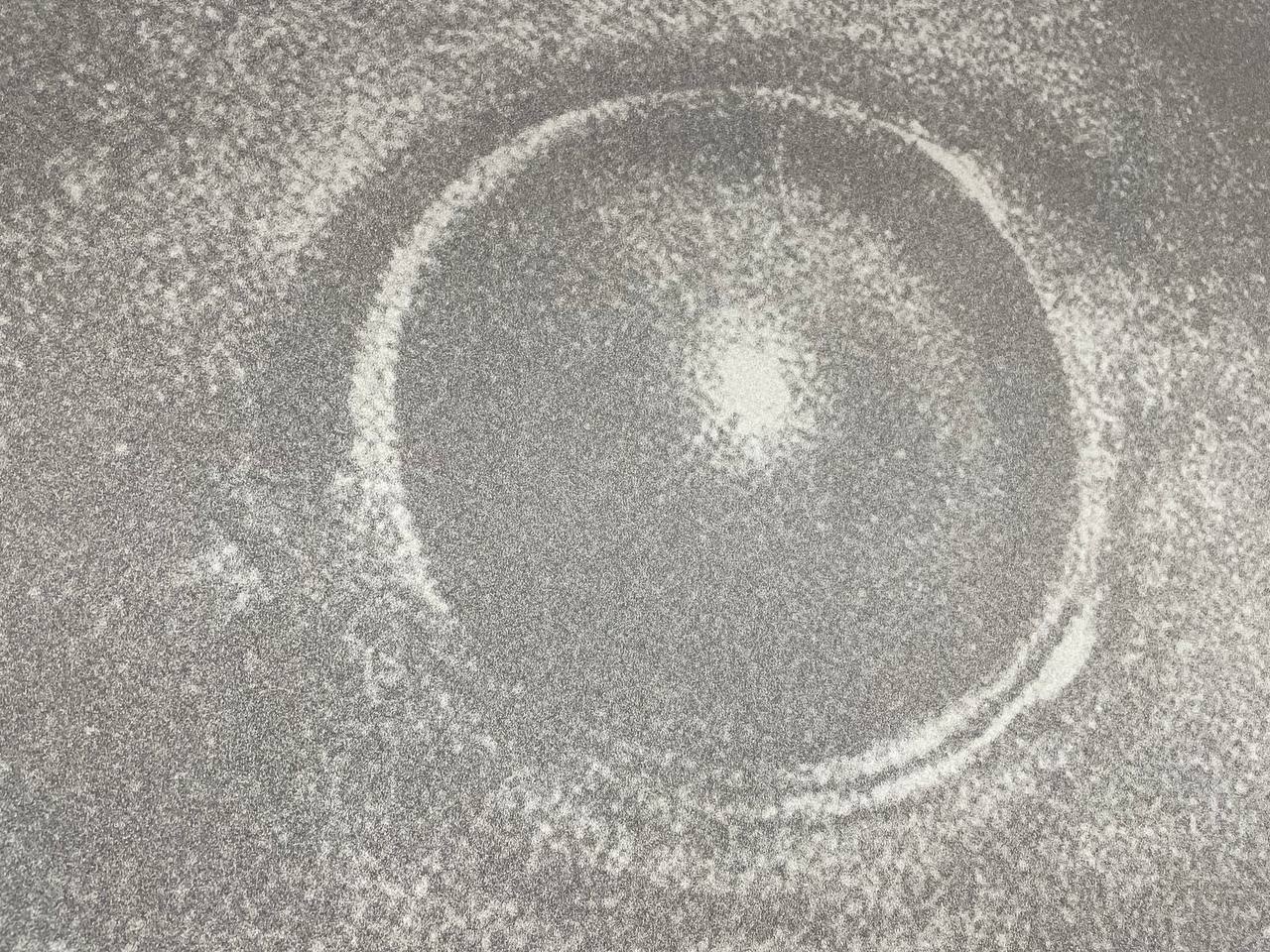

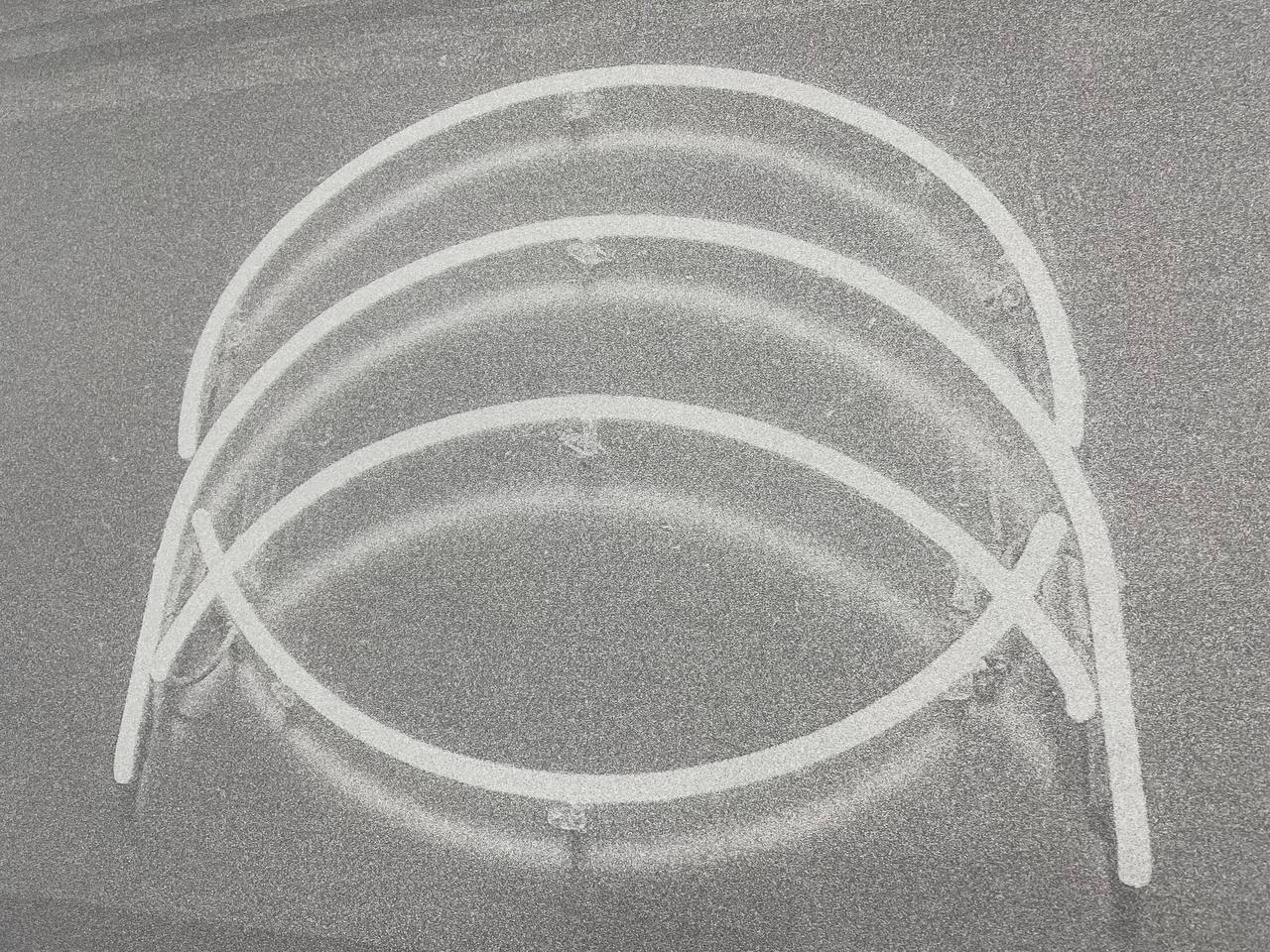
Fragments
W.5

Swamp, Belovezhskaya Pushcha, 2019.
Torn off heel, Warsaw, 2019.
Sperm, Dark Angels club, Poznań, 2021.
Torn off heel, Warsaw, 2019.
Sperm, Dark Angels club, Poznań, 2021.
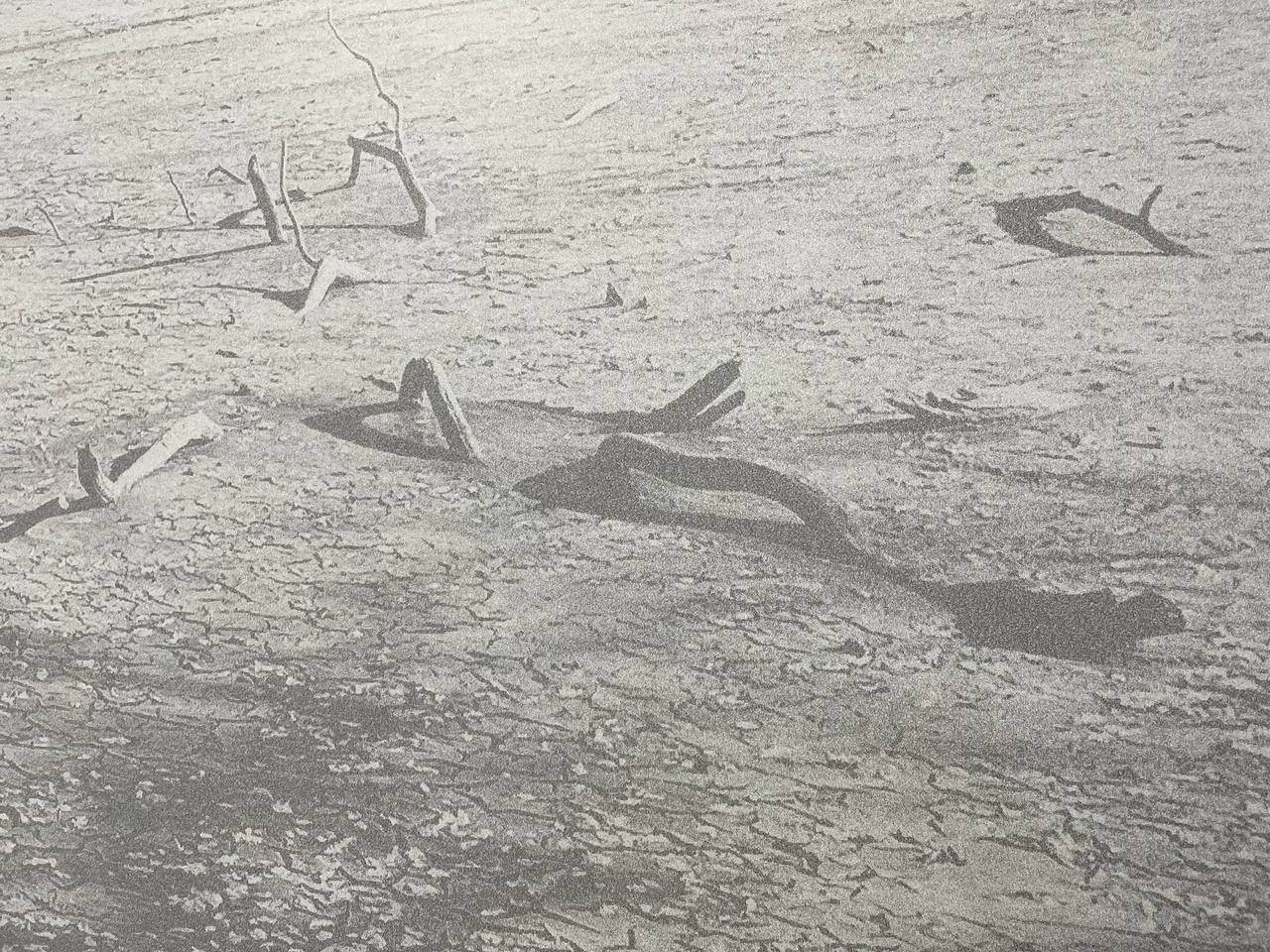


Fragments
W.6
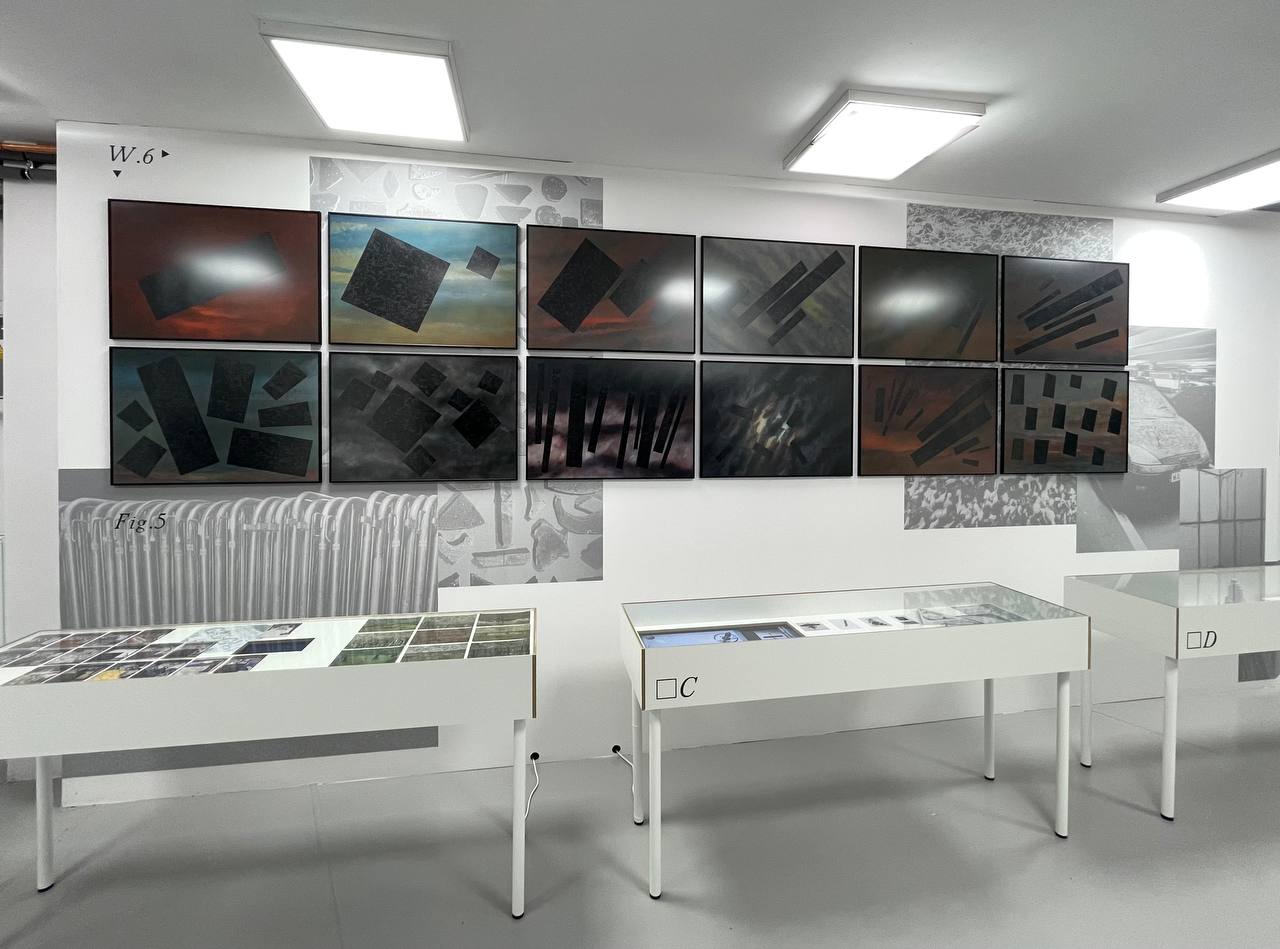
Fences, Zurich, 2023.
Tiles, Palazzo Altemps, Rome, 2022.
Snow, Zbigniew Zakrzewski's Garden, Poznań, 2022.
Abandoned car, Avenida, Poznań, 2022.
"Dirty seams", Pinchuk art center, Kyiv, 2019.
Tiles, Palazzo Altemps, Rome, 2022.
Snow, Zbigniew Zakrzewski's Garden, Poznań, 2022.
Abandoned car, Avenida, Poznań, 2022.
"Dirty seams", Pinchuk art center, Kyiv, 2019.
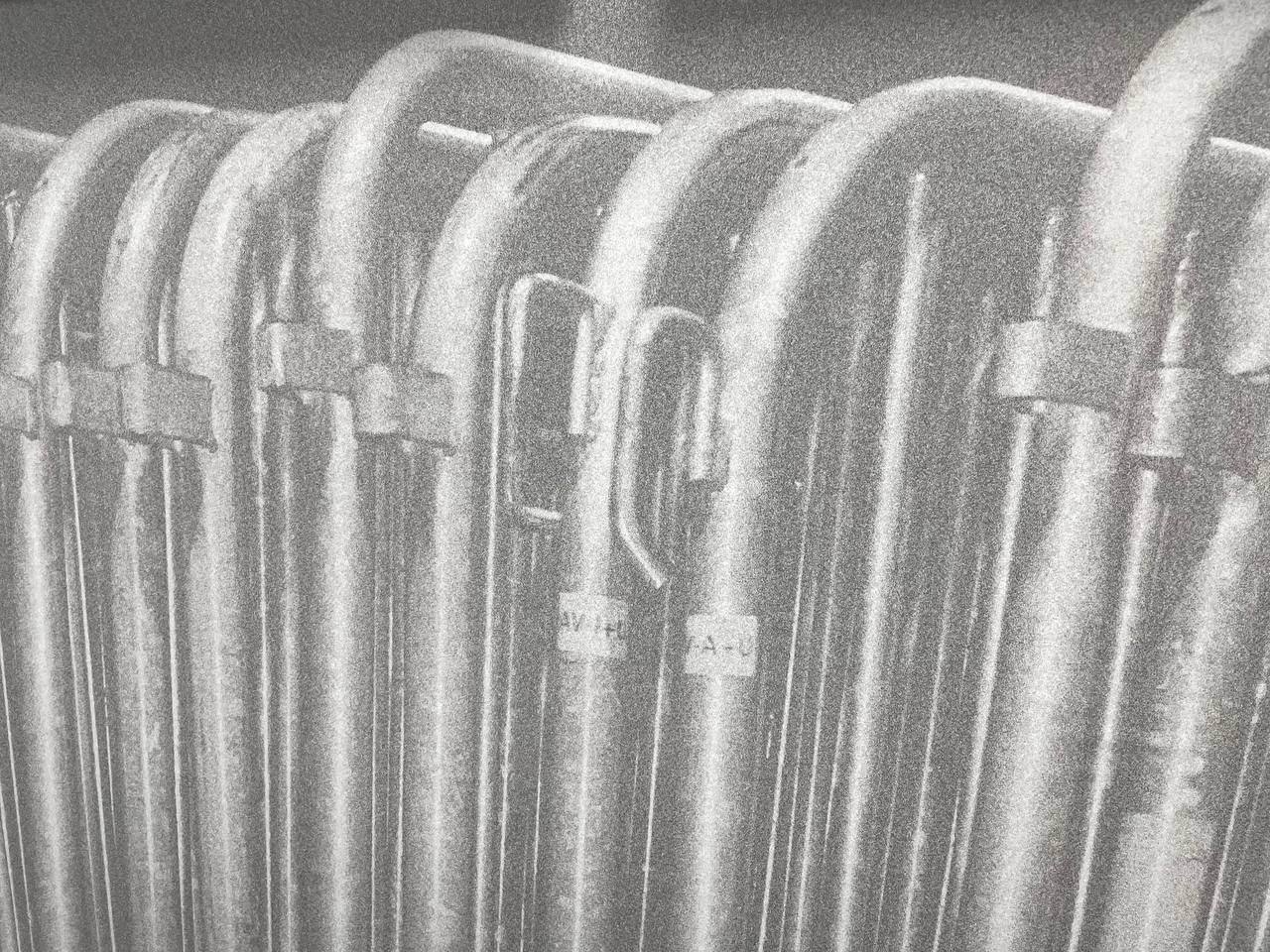


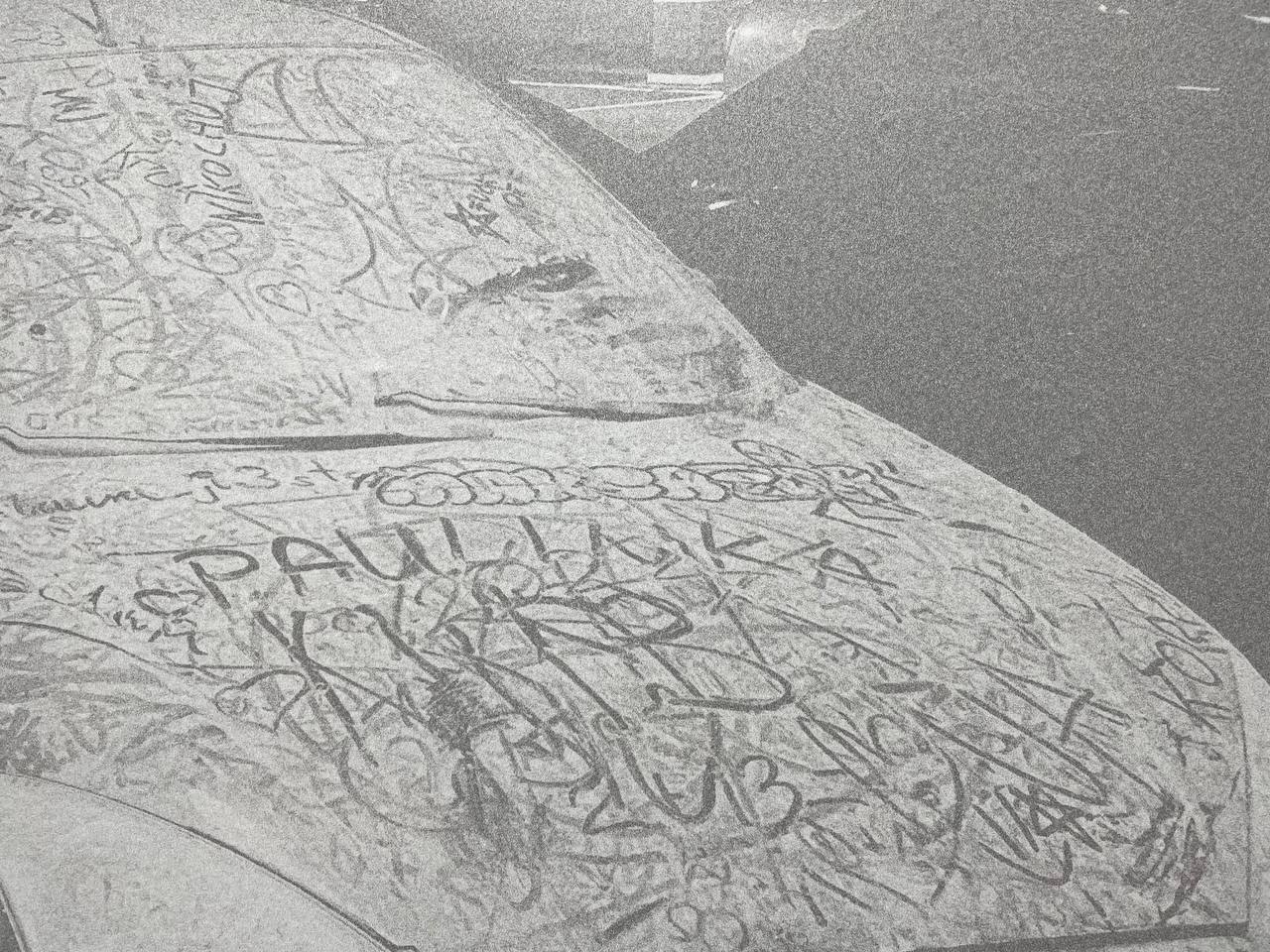
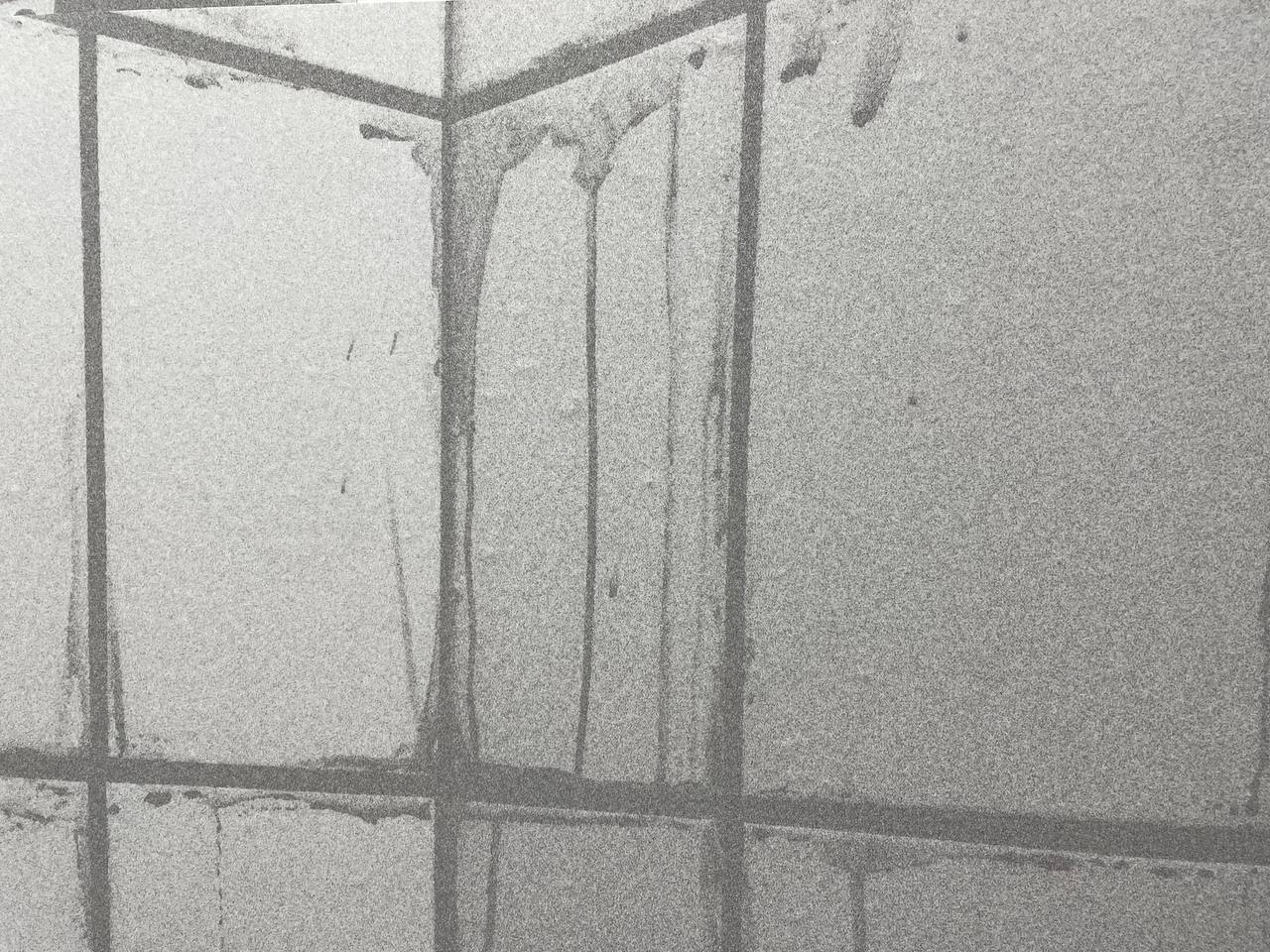
Fragments
W.7

Frieze Solidarity, Fashion House, Minsk, 2014.
Grass, Sant Archangelo, Italy, 2022.
Curtain, Julia Stoshek collection, Berlin, 2021.
Grass, Sant Archangelo, Italy, 2022.
Curtain, Julia Stoshek collection, Berlin, 2021.
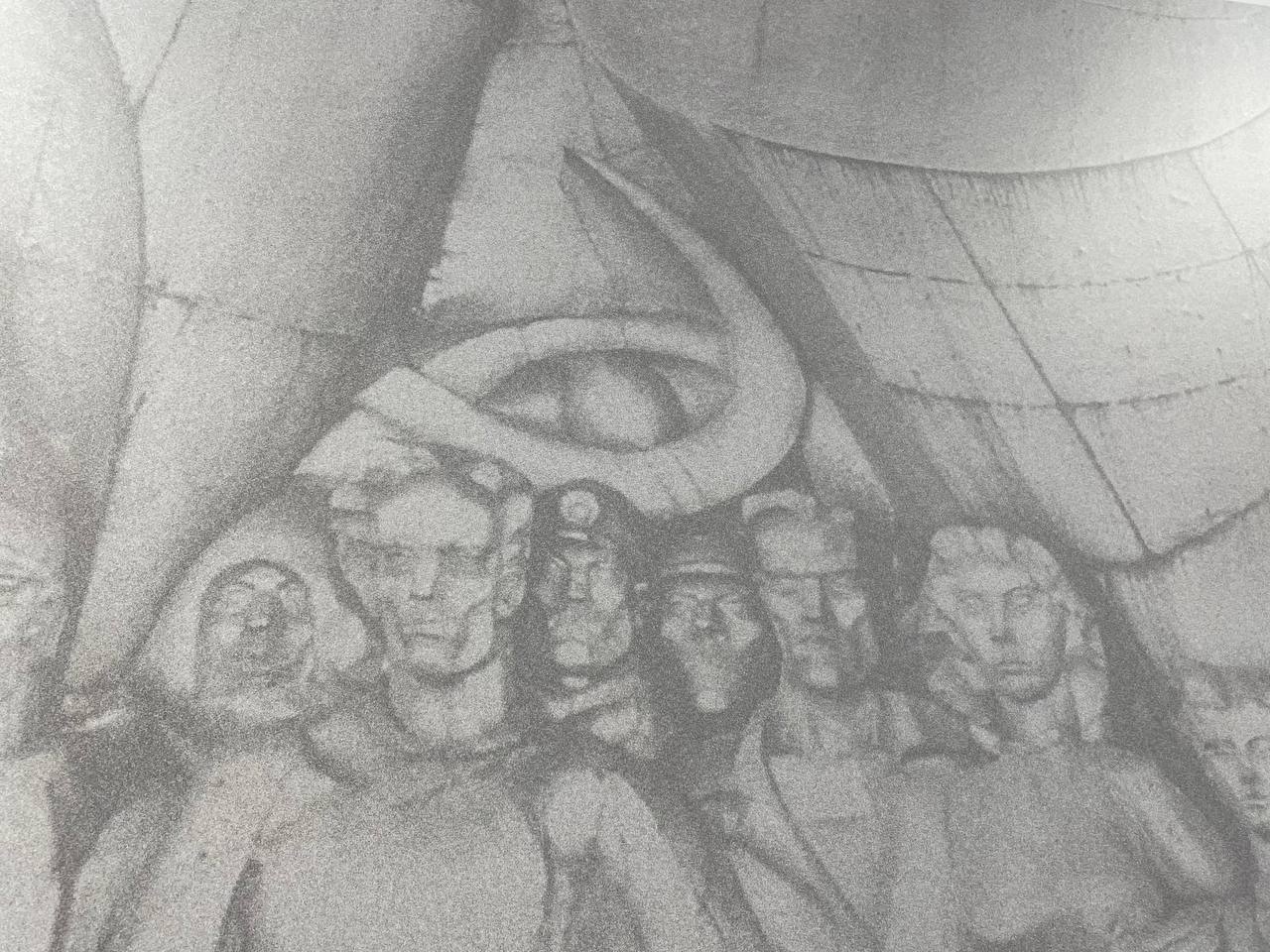
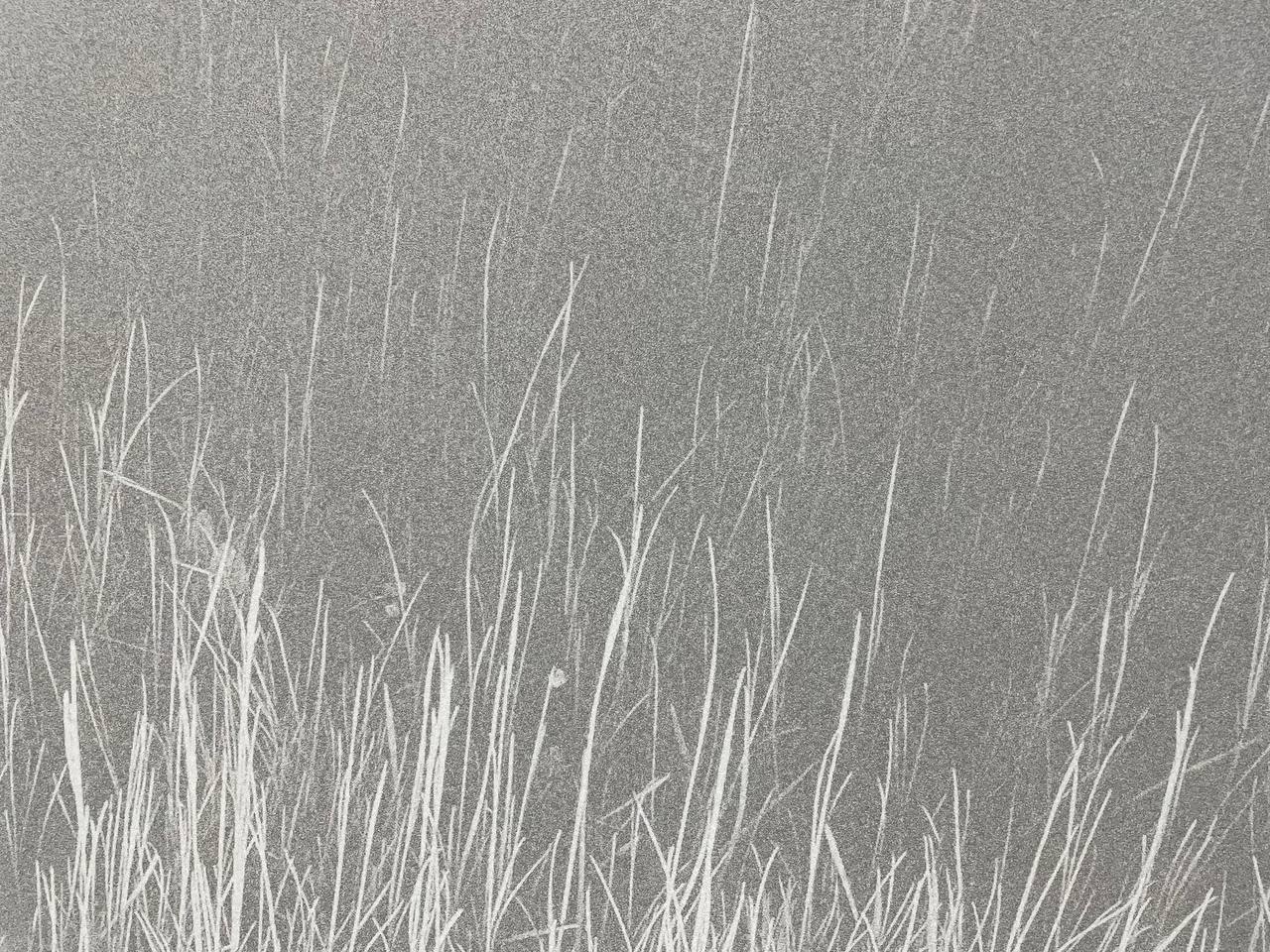
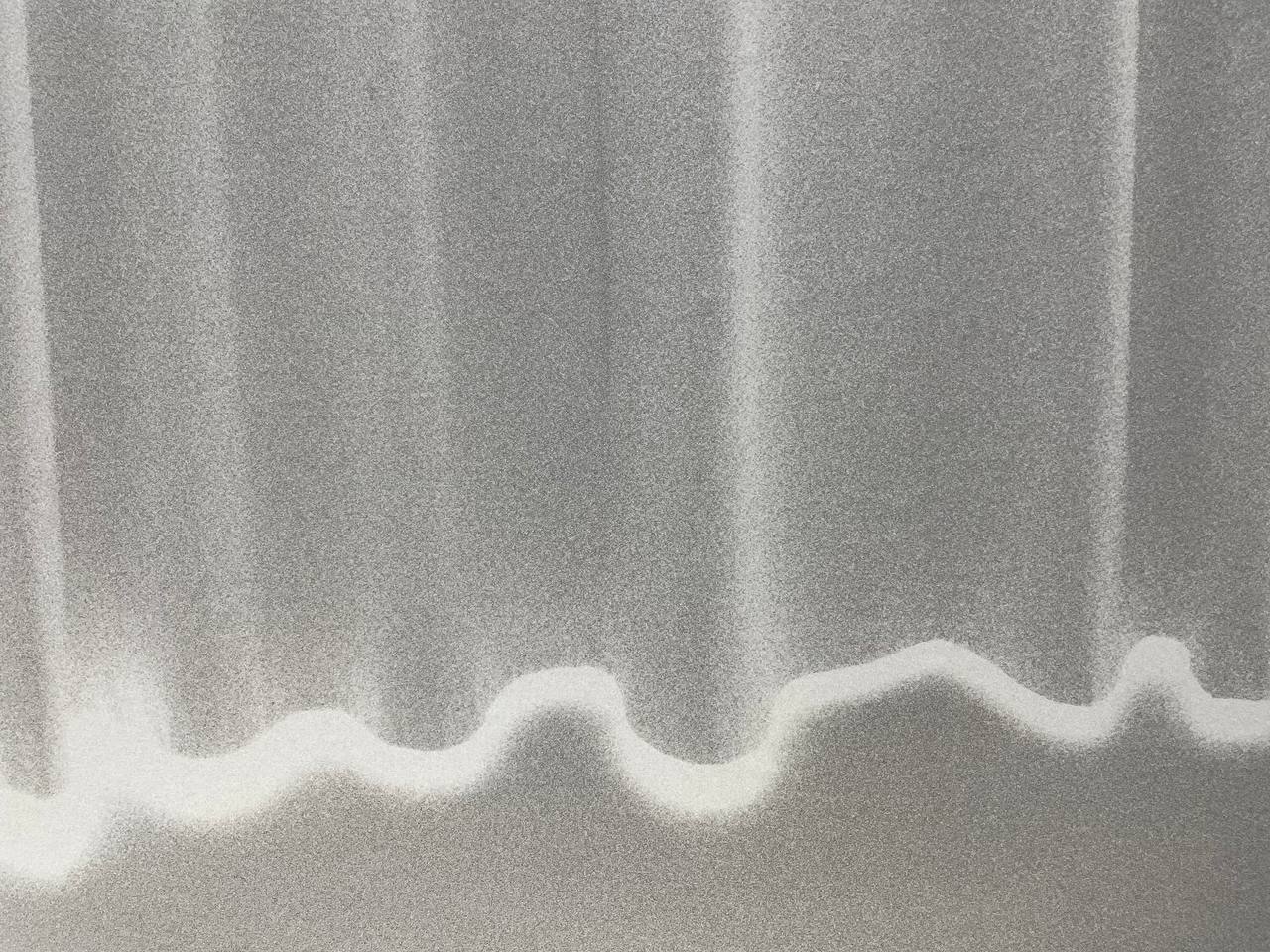
Fragments
Thanks for help in creating the exhibition:
Arsenał Municipal Gallery organizer
Marek Wasilewski curator
Installation:
Monika Petryczko production
Marcin Krzyzaniak editing
Viktoria Zalozna editing
Gray Mandorla Studio production
Grzegorz Nowak production of showcases
Fresh-design Studio prints
Masonry Michał Palacz will provide materials
Roman Romanowski help
Promotion:
Ewelina Muraszkiewicz promotion
MINIMUM STUDIO (Gosia Ciernioch & Dominik Bobersk) project
KALEKTAR information partner
Sound:
Christoph Ogiermann composer
Mikita Bubashkin and Gray Mandorla composer
Olga Podgaiskaya pianist
Christine Fisher producer
Sgustok delivered track
Objects:
Roman Shabohin help with modeling and 3D printing
Sviatlana Haidalionak provided video excerpt
Heorhi Minets operator support
Text:
Bogna Blazewicz correction
Joanna Figiel translation
Marcin Turski translation
Yuliya Zalozna translation
Special thanks:
Zofia nierodzińska
